KRASIS BLOG
ABOUT KRASIS (2017-2023)
Krasis is a unique, museum-based, interdisciplinary teaching and learning programme, which began life at the Ashmolean in 2017, devised by classicist (and historian of ancient Boeotia) Dr Sam Gartland and Teaching Curator Dr Jim Harris. In 2018, the programme won a University of Oxford Humanities Division Teaching Excellence Award. Michaelmas term 2022 was its 15th iteration.
Each term Krasis gathers eight early career researchers from the University of Oxford (the Ashmolean Junior Teaching Fellows or AJTFs) and 16 current Oxford undergraduates and taught-postgraduates (the Krasis Scholars) for a series of object-centred symposia, devised and delivered by the teaching fellows, who each address a shared theme from the standpoint of their own discipline and their own research.
For the Krasis Scholars, the programme offers first-hand insight into what an academic pathway might look like and provides a rare opportunity to learn directly from researchers outside their own subject, whilst contributing from within their degree specialism. For the AJTFs, it offers a forum for interdisciplinary dialogue and a ready, able team of students and colleagues to explore creative, imaginative approaches to collaborative, collections-based teaching.
Over the past five years, Krasis has seen series on Power, the Body, Absence, Presence, Performance, Devotion, Imitation, Voices in Conflict, Movement/Transition, Play, Danger, Identity, Constraint, Opening, Becoming, Belonging, Re-Use and Container. We have used objects ranging from kimonos, musical scores and Tibetan musical instruments to Renaissance bronzes, newspaper advertisements, palaeolithic handaxes. and ancient Egyptian magic wands.
Our Teaching Fellows and Scholars have come from Classics, English, History, Economics, Fine Art, Chemistry, Archaeology, Anthropology, Egyptology, Assyriology, Russian, Japanese Studies, German, Earth Sciences, Engineering, Politics, French, Portuguese, History of Art, Arabic, Physics, Statistics, Islamic Studies, Development Studies, Geography, Music, South Asian Studies, Philosophy, Linguistics, Theology, Women’s Studies, Experimental Psychology and Law, and from almost every college of the University.
Competition to join Krasis is fierce, and the growing number of former Scholars returning as Teaching Fellows testifies to its impact on participants. But the question of what actually happens each week has remained mysterious outside the walls of the Museum.
This blog, written by programme participants, aims to shed some overdue light on the enigma.
Welcome to Krasis.
KRASIS 15
During Michaelmas term 2022 we explored the theme of Believing, from the perspectives of AJTFs working in English, French, Theology, Late-Antique and Central Asian History, Linguistics and Anthropology.
KRASIS 14
During Trinity term 2022 we explored the theme of Container, from the perspectives of AJTFs working in English, Central Asian History, History of Science, Medieval German, Linguistics, History of Art and Engineering.
Week 1 was devised and led by AJTF Madeleine Saidenberg, whose doctoral research examines Shakespeare, adaptation, and national identity in 18th-century Ireland. She also co-convenes the TORCH network Queer Intersections Oxford (QIO) and hosts the forthcoming ‘Practice Makes’ podcast for the Re-Imagining Performance Network. Before starting the DPhil, Madeleine worked in theatre and television in New York, Dublin, and Morocco, and as an assistant director and dramaturg in the West End and off-Broadway.
This blogpost was written by Krasis Scholar Caitlin Kelly, a second-year undergraduate reading English at Somerville College.
Theatre
Krasis 14 began, as Krasis does, at the harpsichord – our physical anchor during eight disorienting weeks of intellectual unravelling. After a journey through labyrinthine corridors to the Eastern Art study room [it’s not that far! Ed.], AJTF and 18th-century Irish theatre historian Madeleine Saidenberg began her symposium by prompting us to describe the scene directly facing us as we sat at the table.
For me, this meant an array of delicate pottery stored behind glass. For the scholars on the opposite side of the room, a series of obstinately opaque metal cupboards, like filing cabinets. Even unlocked, behind each door were just reams of black boxes and envelopes: a seemingly infinite regress of archival Matryoshkas.

Assessing these juxtaposing perspectives, I was struck by how the contrast between the filing cabinet and its glass counterpart mirrored that of backstage and frontstage. How behind the illusion of effortless, contained performance is an intricately organised network of artifice.Madeleine split us into groups, giving each an architectural plan of a theatre, tasking us with fixing the price of each seating area.
Armed with the staging for the Playhouse Theatre’s recent production of Cabaret, my colleague Bethan Downs and I deliberated before deciding that the seats directly on and above the stage should be the most expensive: the production seemed to deliberately play with the boundary between audience and performance, therefore placing a premium on those most immersive seats where theatregoers could become a part of the Kit Kat club themselves.
Sharing our findings amongst the rest of the scholars we heard about a range of spaces from the Almeida theatre to the Sam Wanamaker Playhouse, each with their own idiosyncrasies available for productions to harness.
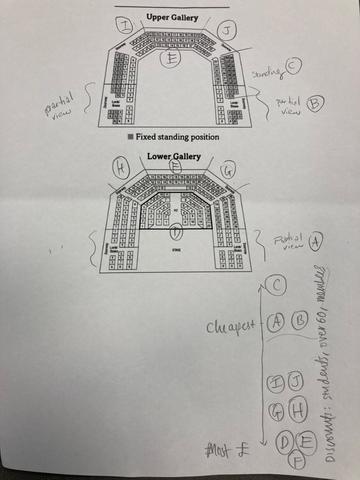
As we each explained our pricing strategies, we considered how theatre as an art form often occupies an exclusive container unattainable to those who cannot afford either to participate in or watch it and how this is in some degrees a modern phenomenon.
Placed in the role of theatre designers, set designers, and directors, the exercise highlighted the malleability of the stage as well as how ‘immersive’ theatre, which appears to break the container of the fourth wall is nonetheless carefully micro-managed.
So, what happens when the audience refuses to be contained?
We were each assigned an account of a theatrical riot ranging from the Abbey Theatre riots during the first performances of The Playboy of the Western World in 1907 to the Astor Place Shakespeare riots of 1849 in which at least 25 people were killed. Behind each were latent tensions around class, race, and gender, whose containers somehow failed, ruptured by the performances staged. It struck us how, as a meeting point for a host of clashing and intersecting identities, the theatre can be a volatile space in which the boundaries of social containment are disputed or reinforced.
Theatre can simultaneously be a locus of conservatism and radicalism. Hearing about W.B. Yeats’s introduction of lights-down performances and the austere rules of behaviour he enforced on the Abbey Theatre’s audiences highlighted how theatrical mores have evolved over time; the unruly chatter of 17th-century Restoration audiences seems alien to a 21st-century audience for whom Yeatsian silence is the standard.
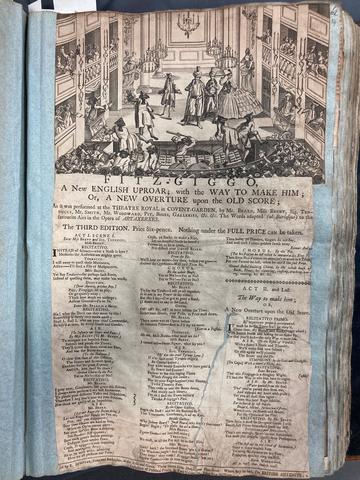
Moving on, we examined the 18th-century broadside print, Fitz-Giggo, a new English uproar, a satire on a riot which occurred during a performance of Thomas Arne’s Artaxerxes at Covent Garden in February 1763.
As we read how the actors feared that the audience would ‘throw the Seats about our Ears/And tear the Boxes down,’ we discussed the decline in theatrical audience invasions and the way popular sport seems to have replaced theatre as a mass cathartic space. Most of us had heard of or witnessed pitch invasions but never come across one on stage.
After all this talk of rioting, we made our way to the cafe in a nice orderly fashion to take tea.
Resuming fully caffeinated, we were met by a curious, gold-framed pendant featuring a portrait of a man. Each of us was encouraged to share one thing we observed about the object as we passed it around the room; the only rule being we had to state only what we saw, not what we could interpret. From this, we gradually pieced together a picture of the object: that it had a hook and could be worn; that the man depicted was in the latter stages of his life and dressed formally; that hair which matched the colour of the man’s own was carefully plaited and incorporated into the back of the pendant.
Eventually, it was revealed that the object allegedly depicted the Georgian Irish actor Charles Macklin, famous for playing Shylock in The Merchant of Venice and for breaking with the established declamatory style to introduce a more naturalistic mode of acting. Perhaps a souvenir, family memento, or piece of mourning jewellery, the pendant seemed to question whether human essence can be contained.
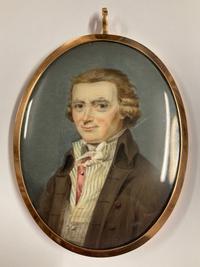
Springboarding from this, we moved to a collection of portrait prints of Macklin both on and off stage, alongside a broadside advertisement for Macklin’s own play Love à la Mode, a comedy in which four suitors, English, Irish, Scottish, and Jewish, compete for the hand of the heroine Charlotte. As we surveyed these images, Madeleine provided an overview of Macklin’s life and career, tracing his childhood in County Donegal through to the heights of his fame on the stages of the West End. Learning about Macklin’s chameleonic ability to portray and write characters of different classes and cultural backgrounds prompted a rich discussion around whether the actor is a neutral, universal container.
In hindsight, this discussion was underpinned by two assumptions. Firstly, that the boundary between actor and role, container and contained, should be fully blurred, that the two should become one and the same. Secondly, that audiences may interpret theatrical representations as microcosms for entire communities with this having the dangerous potential to underplay the heterogeneity, even the humanity, of marginalised groups. These unsaid principles seemed to reflect 21st-century tastes for naturalistic acting and non-allegorical characterisation.
Our conversation centred on whether the identity of an actor should align with that of the role they mean to inhabit, a pertinent question in light of growing calls for representative casting.
In this vein, we discussed the appropriateness of straight, cisgendered actors playing queer characters, of able-bodied actors playing disabled characters, and wondered if non-representative casting constrained performances and hampered authenticity.
Ultimately, a consensus emerged stressing the importance of representative casting as a form of reclamation for marginalised communities. Turning back to Macklin we debated whether his portrayal of Shylock humanised the Jewish community by individualising Shylock as three-dimensional and fallible, or if he crystallised negative stereotypes by playing into antisemitic tropes.
The discussion then moved on to accents; we dissected the way in which RP (Received Pronunciation) has been taken as a neutral form of English and how this has resulted in an erosion of regional accents within the acting community.
Born and raised in Norfolk, I reflected on how as a child I’d been taught to iron out any semblance of an East Anglian twang, how I had never seen how my family talked properly represented on stage or screen until very recently with Sean Harris’s performance in The Goob (2014) and that of Ralph Fiennes in The Dig (2021).
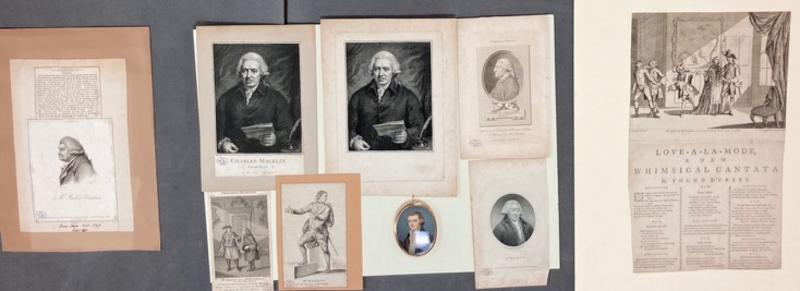
We equally considered instances where the presence of a certain actor interrupts the melding of container and contained, preventing the audience from fully immersing themselves in performance.
Bethan raised how she found the casting of Elizabeth Moss as Offred in The Handmaid’s Tale jarring, given her membership of the Church of Scientology. Afterwards, we debated Tom Cruise’s acting ability (Jim firmly on the side of Cruise as great actor).
Reflecting on this conversation after the session called to mind productions which have taken a more iconoclastic approach to the idea of containment.
John Barton’s 1973 production of Richard II saw the roles of the titular king and the usurper Henry Bolingbroke alternated between performances. The audience was unaware of who would be playing who until the performance started - each night opened with an actor playing Shakespeare who crowned a masked Richard Pasco or Ian Richardson as that night’s King Richard II.
Danny Boyle’s 2011 production of Frankenstein at the National Theatre employed a similar strategy. Jonny Lee Miller and Benedict Cumberbatch would take turns playing Victor Frankenstein.
Barton and Boyle’s self-reflexive productions highlight how breaking the container between actor and role can foreground the fragility of human power structures, as well as the commonalities we often desperately try to deny between ourselves and those we deem different.
The final third of the symposium concentrated on the Museum as a performative space, inviting us to consider whether we can transcend the containers of viewer and viewed.
Leaving the Eastern Art study room, Madeleine led us to the Weldon Gallery of Baroque art.
The first painting we encountered was Truth Presenting a Mirror to the Vanities of the World, an anonymous work from the early 1600s.
The piece shows an allegory of Truth who looks upon the viewer. She holds a set of scales in her left hand and an outward facing mirror in her right, adjacent to the mirror is a skull resting on top of a manuscript. Truth invited us to meet her gaze yet the inability of the mirror to reflect us was disorienting, it decidedly prevented our assimilation with the artwork. Read alongside the presence of the skull, perhaps the mirror’s refusal to reflect reveals the insignificance of our mortal containers relative to a grand cosmological scheme, a protest against material concerns. Alternatively, does the mirror relegate art to a contained realm of artifice unable to truly reflect or interact with the real world?
The anonymity of the artist equally seemed to question whether visual and literary artworks require a single identifiable creator to contain them, whether we can reconcile ourselves to unknown or collaborative genesis.
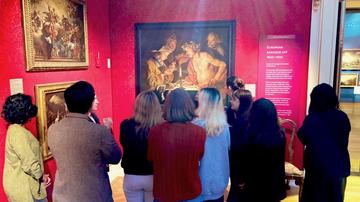
Madeleine then guided us to Blowing Hot, Blowing Cold, an oil painting by Matthias Stom, depicting a feast scene from Aesop’s Fable ‘The Satyr and The Traveller’ in the style of Caravaggio.
Madeleine encouraged us to stand directly before the painting, to try to immerse ourselves in the banquet before us. Though an empty space at the table occupying the foreground seems to invite the onlooker to take a seat, the painting’s grand scale and dramatic chiaroscuro seemed to reinforce the border between art and reality.
After the session, I learnt that the painting depicts a satyr’s amazement at how a peasant man can warm his hands with his breath yet with the same air cool a spoonful of soup. The subject seemed particularly relevant to the session’s refrain on contradictions held within a single container.
The session drew to a close at the Treby toilet service, an opulent silver dressing table set gifted by George Treby to his wife Charity on the occasion of their marriage in 1725. I couldn’t help but wonder what the display did not show; whether immense suffering had been required to produce the toilet service and to sustain the luxurious lifestyle of the Trebys.
The extensive array of brushes, cosmetic compacts, and jewellery boxes in the toilet service prompted us to discuss the exertion behind calm, collected facades. The effort required to produce the containers we present to the world and whether such endeavours are in vain. As we debated this, our gaze was met in the mirror before us, yet the morphed reflections in the silver trinkets below underscored the impossibility of true containment.
To return to the image of the infinite filing cabinet confronting us at the start of the symposium, my first Krasis has taught me never to rest on my laurels. The container of knowledge can never be fully unpacked, or filled, its contents and contours are constantly evolving.
I eagerly await the next existential crisis Krasis has in store.
Week 2 was devised and led by AJTF Dr Linus Ubl, who is Departmental Lecturer in German at Somerville College. His research draws together linguistic and historical approaches to medieval German literature, as well as reception studies and the question of how history is told in the present, i.e. books, movies and popular culture.
This post was written by Krasis Scholars James Titterington and Renée Trepagnier, both Masters students. James is reading English at Regent's Park College; Renée is reading Classical Archaeology at Hertford College.
Museum
James: Inevitably, Krasis 14 began for us all at the harpsichord. Rather than being whisked away to the New Douce Room, the session started with a walk around the museum. Each group was assigned a floor and tasked with wandering around for ten minutes, all the while thinking about the kinds of containers that might be found within the Ashmolean.
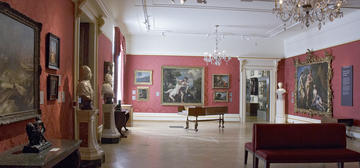
Dr Linus Ubl was in charge this week and we walked the third floor with him, watching out for containers. As it turns out, this museum (like every other) is full of them. Most obviously there are the glass cases. But then in certain cases, there are cases within cases. In other cases, there are no cases at all. Linus encouraged us to think about why this might be.
When we got back to the New Douce Room, each group presented their findings on containers: the gift shop as container; language and labels as containers; the museum itself as a meta-container. Then things got properly underway, and Linus brought out one of Douce’s creations, an album which contained a puzzling collection of prints. We were encouraged to think about reading practices and how a book might facilitate these. Francis Douce was famous for cutting up incunabula and printed books, and rearranging them in new, often inscrutable, compilations of his own design. Linus dissuaded us from condemning this as a purely destructive act, and suggested we focus on the “new” objects as containers.
[Biographical note: Douce resigned from the British Museum in 1811. His reasons for doing so have since become infamous. Reason number thirteen is a highlight. He bemoans the “fiddle faddle requisition of incessant reports, the greatest part of which can inform them of nothing, or, when they do, of what they are generally incapable of understanding or fairly judging of.”]

However, Douce’s album was just one of four books that was examined. In addition to Douce 367 there was a cookbook focussed on making pie cases; some French poetry printed on Korean paper and stored in a bespoke box. Renée, Linus and I were presented with an entire folder, containing photobooks, exhibition records and receipts from the artist Sigune Hamann. One of the books was in fact a poster which functioned as a folder for photographs, which were records of a previous exhibition. For a group on the lookout for containers it was very pleasing indeed.
So far, the session had been stimulating, fascinating and (happily, in the New Douce Room) completely free from fiddle-faddle of any kind.
Renée: So, having examined books as containers, Linus now turned the investigation to the function, history, and properties of empty boxes. James, Linus, and I were given a very large, wooden box with an old label reading “Douce Prints N: 7”. Another label comprised a note: “Empty - moved to solanders”, which clued James and I into the idea that this box was itself an important artifact; the preservation of the empty container indicated its significance beyond its function as an object for holding other artifacts.
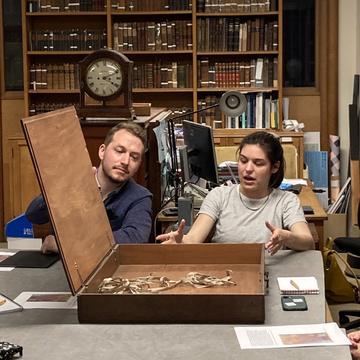
The box belonged to Douce’s personal print collection which he catalogued with reference to the compass points denoting the walls of his own print room. Therefore, the box we examined was “North: 7”. Douce’s prints were bequeathed to the University in 1834 in his own containers: not just boxes but also folios and wrappers. which both held his prints and also recorded the organization of his collection. Even empty, Douce’s boxes offer insight into the innovative ways in which he structured, conceptualized and contained his collection. The original intentions and functions of containers, though, are subject to change and objects that act as containers can in themselves become valuable reminders worth preserving - in their own containers. In this case, the Douce box held historical significance and was preserved in the ‘container’ of the Western Art Print Collection in the larger ‘container’ of the Ashmolean.
This thought exercise led smoothly into the final activity in which Linus asked us to re-explore the museum and find an object with multiple layers of containment. James and I selected a brilliantly carved Italian Renaissance chess-set that doubled as a backgammon board on the reverse side. We first identified the set as a container, a box, because of a small, hidden drawer to hold the game pieces. Each carved side-panel of the box acted to contain the two game-boards, while the squares of the chess board contained the game pieces. In a more abstract reflection, James observed that the game pieces were also contained by the rules of the game. Nice. Further levels of containment could be seen in the display case and the Fox-Strangways Gallery itself. In total, we pinpointed approximately 15 layers of containment around this one object.
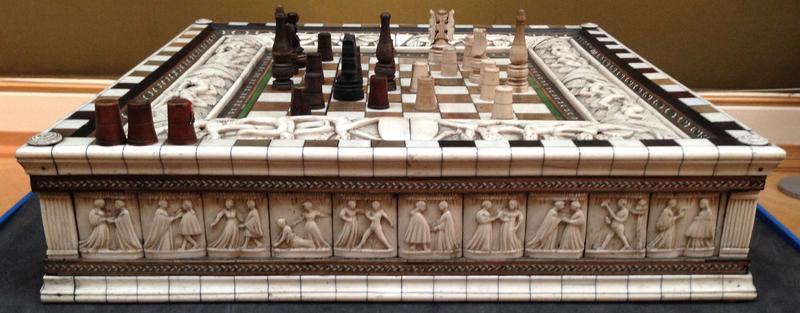
Other groups tracked down other 'containers'. One examined a US fifty dollar bill, counterstamped ‘lesbian money’, used for political activism. Just as James and I had pondered how the rules of chess limited and contained the movements of the chess pieces, our colleagues questioned how this bill contained notions of economy, activism, identity, and ideology. I believe the discussion concerning layers of containment prompted us all to consider how both materiality and the meanings with we imbue containers - symbolic, political, social, historical, cultural, economic - impact the function, significance, and value of the objects. Containment can happen on a variety of levels and each layer of containment comes with a specific purpose and meaning. Contemplating how objects contain (and are contained by) abstract ideas like game rules or value provides a fresh new perspective for evaluating how we interact with them.
As 5:00pm loomed nearer, Jim rushed us out of the museum before closing. As an archaeologist, I was left considering my own possessions, home, research, and even life in terms of containers. I will doubtless continue these reflections as Krasis continues to introduce new ideas into my consciousness.
Week 3 was devised and led by AJTF Songjun He, who is a DPhil researcher focusing on both synchronic and diachronic Manchu phonology. Manchu is a critically endangered language, once the official language of the Qing dynasty, closely connected to folk music, religion, history. Both the language and the dynasty have left abundant traces in the Ashmolean Museum, from royal certificates of appointment to daily necessities.
This post was written by Krasis Scholars Aspen Warren, who is reading for a degree in the History of Art at Christ Church; and Anna Henderson, who is taking an MSt in Archaeology at St Hugh's.
Language
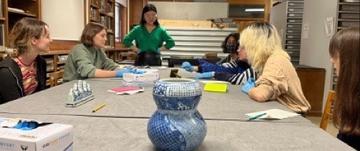
This week, AJTF and researcher in Manchu phonology, Songjun He sought to further extend our understanding of ‘container’: how can an object store and transfer information, without any direct interaction between maker or ‘storer’, and recipient or ‘user’.
Based, as usual, in the New Douce Room, we were greeted on arrival by a trolley full of material ranging from seals to vases and other, more unknowable objects. Assembling in groups of three, two scholars to each Teaching Fellow, we each chose a treasure and donned our blue gloves…
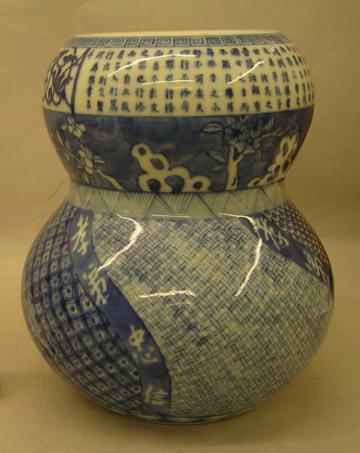
We selected a blue and white ‘container’, a vase decorated with text, flowers and different patterns and textures. The vase had a sculptural form, with the floral decoration suggesting it might function to hold flowers. Through further observation we noticed how the ornamentation was hand-painted, made obvious through the visible brushstrokes and delicacy of line, with text appearing to be the dominant motif, and we began to ask whether an understanding of what was written was important in trying to assess the purpose of the object.
After speaking with Songjun we learnt the text was derived from Confucian teaching and ‘contained’ a message of loyalty to parents, siblings and the Emperor. Our understanding shifted again after discussion with other groups. We discovered that the jar was, in fact, a ‘mizusashi’, designed to hold water for the tea ceremony, for filling the kettle and rinsing the whisk. The container was thus a practical object which simultaneously served to remind users, when preparing and sharing tea, of the values of family and nation.
After the break, Songjun took us to the Textile gallery, where, after wandering past the array of beautifully decorated textiles lining the walls, we came to a stop in front of a relatively innocuous glass case. Inside was a partly-unrolled silk scroll. The text on the scroll was an edict written in Manchu script, the now-endangered language that was the official language of the Chinese Qing dynasty.
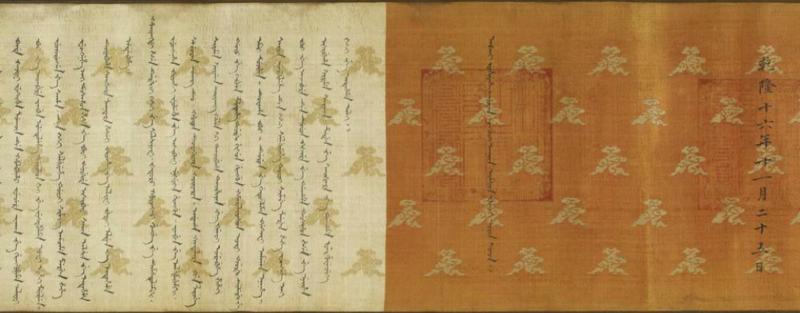
The scroll records a decree by the Chinese emperor appointing a new governor for the city of Chengdu, capital of the province of Sichuan, and bears his official imperial signature, the body of the text in Manchu script painted onto the silk with ink. We began to consider the scroll as a container; not only did it contain the official edict, but also the imperial seal. Yet the symbols on the scroll were not the only method of containing and transferring information: the weave of the silk itself, with repeated patterns in the background, communicated importance, wealth and authority.
When we returned to the New Douce Room, Songjun gave each group a book from the Hope collection in a language with which we were unfamiliar - Latin, German, French or Italian - asking us to extract what information we could despite our lack.
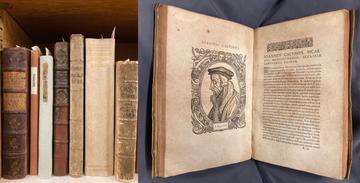
Many of us resorted to studying the pictures or pointed to odd words we either recognised or were similar to English. We used the publishing information on the front pages to give the books a location and a date and were able to sound out words whose meaning was still unknown. Despite the fact, then, that most of the contents were inaccessible to us, we still managed to understand something.
Songjun then guided us through writing the apparently impenetrable Manchu script. We learned how to connect the various symbols to form the flowing lines that are read vertically top-to-bottom.
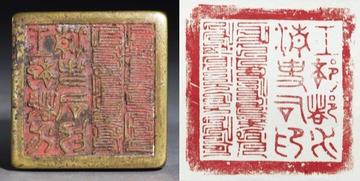
We considered what letters and symbols can contain - a shape, a sound - and how, combined in different ways they can then construct new sounds and new meanings, forming more complex containers and communicators of meaning and idea.
Whether or not we can read a script, as in the scroll and the books, the letters still contain this information, waiting to offer it to the next person with the tools to understand.
Week 4 was devised and led by AJTF Mathilde Daussy-Renaudin, who took us for the first time in Krasis history to the University's History of Science Museum. Mathilde is a collaborative doctoral award holder working between the HoSM and University College London. Her work investigates the relationship between science and religion embodied in astrolabes, and considers the categorisation and display of these objects in a museum environment concerned with questions of decoloisation.
This post was written by Emily Rosindell, who is a second-year historian at Exeter College, and Alexandra Egland, who is studying for an MSt in History of Art and Visual Culture at St Benet's Hall.
Astrolabe
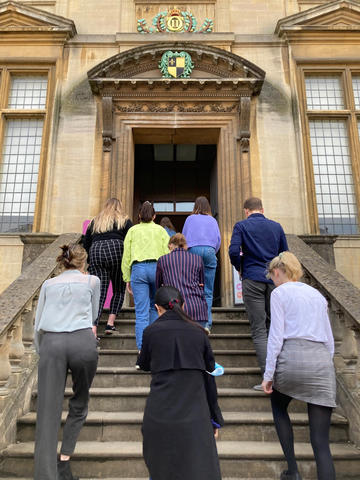
Krasis met this week at the intersection of astronomy and astrology, as we investigated the history and technology of astrolabes in the History of Science Museum, under the direction of AJTF Mathilde Daussy-Renaudin. At this crossroads, we were asked to consider how science, religion, and magic might interact within an object: how it might contain all these, and more.
Once gloved, we were able to hold and take apart astrolabes of various sizes and ages and from various places, in an attempt to understand their inscriptions as well as their intricate mechanics. Astrolabes possess multiple moving parts: the rete, or map of the stars, and sometimes several ‘plates’, in addition to rulers and various units of measurement. The plates - metal discs that we discovered were templates for use in different merchant cities - are replaceable and changeable based on the user’s location.
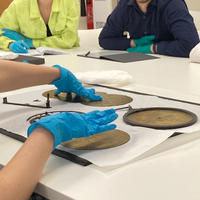
Astrolabes were used by merchants and travellers in the ancient and medieval world and were developed to a high degree by Islamic astronomers and craftsmen. They proved a useful intersection of navigational science and astrology in a manner that revolutionised how an individual could calculate sun and star positions and thus situate themself in space.
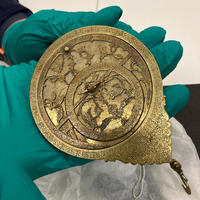
Leaning into the Krasis 14 theme of ‘containers’ we thought about what an astrolabe could ‘contain’ – and how we make that clear in a museum. As astrolabes are often double-faced and include several parts, they are difficult objects to comprehensively display to museum audiences. There are intricate and useful details all over the astrolabes’ surfaces that require some contextualisation in order to fully understand the object. These small details acted as containers of the various knowledge bases that determined each astrolabe’s function. They were symbols of education, due to the knowledge required to read them and the economic power required to obtain them, implying that class and pedagogical accessibility are important social containers to consider when analysing these objects.
Astrological and planetary symbols, with inscriptions in Latin and Arabic, all encapsulated elements of the precise function of a particular astrolabe. Some things to consider when looking at individual astrolabes concern their categorisation. Are they Islamic objects or European? Given the geographical and religious contexts of these objects, the information contained was tailored for specific belief systems, points of view, and functions, such as pointing the user in the direction of Mecca in the case of many Islamic astrolabes. Different geographical points of origin would largely correlate to the type of information contained within a single astrolabe.
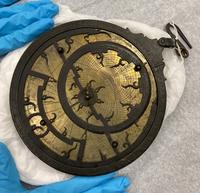
These handheld objects were containers that possessed all the tools and information for reading the universe and making sense of the world–both physical and metaphysical, as instruments to navigate the geographic and religious pathways of the world. They prompt us to ask: what meanings are stripped from an object when it is displayed in a museum setting and what must be externally learned in order to understand it? Contrarily, what has been foregrounded or distorted now that they are not in use? For objects that are valued for both their utility and beauty, which should we privilege as observers?
The astrolabes, and their relatives such as armillary spheres, compelled us to consider practices such as astrology, now often considered a pseudoscience, but nonetheless founded in scientific observation – of the influence of the moon on the tides, for example. How do we analyse such a pseudo-science as a container of information against what one may consider ‘real’ science, and how can objects like this help us to untangle the relationship between science and magic?
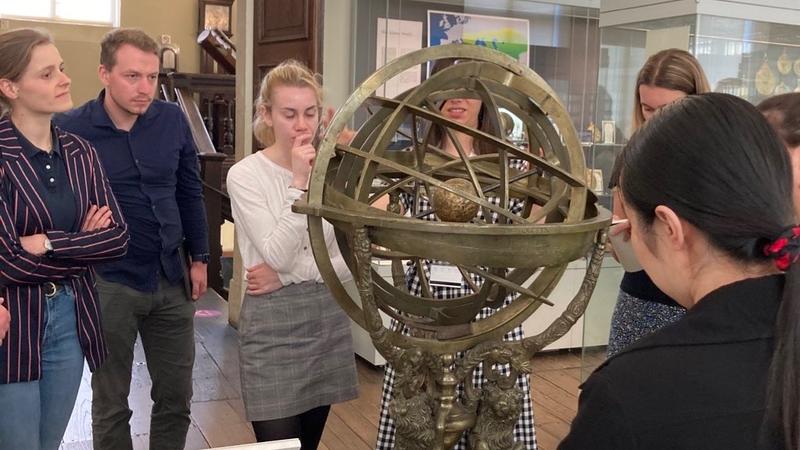
Astrolabes exist within a truly interdisciplinary sphere, useful to different people for different reasons: doctors for tracking illness, explorers for mapping, merchants for travel. They compel us to consider why we so often seek to contain, categorise and label historical learning. The object is multifaceted; it should be displayed as such.
Week 5 was devised and led by AJTF Jiaqi Kang, who is writing a DPhil in the History of Art. Their research examines the relationship between hygiene politics (discourses of health, contagion, and pollution) and art in the postsocialist period in China. As an undergraduate, Jiaqi was a Krasis Scholar in Krasis 05.
This post was devised and, unusually for the Krasis Blog, formatted as a virtual exhibition by Krasis Scholars Zara Ismail and Georgina Dettmer. Zara is a postgraduate at Wolfson College, writing an MPhil in Modern South Asian Studies; Georgina has just completed a BA in English at Trinity College.
Body
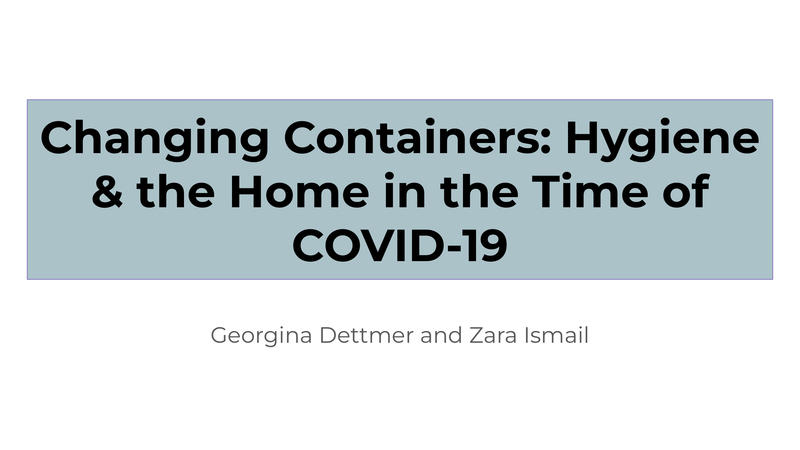
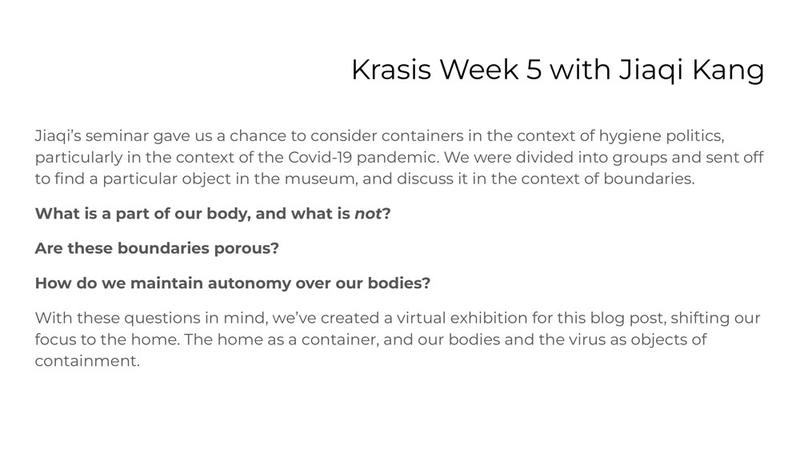
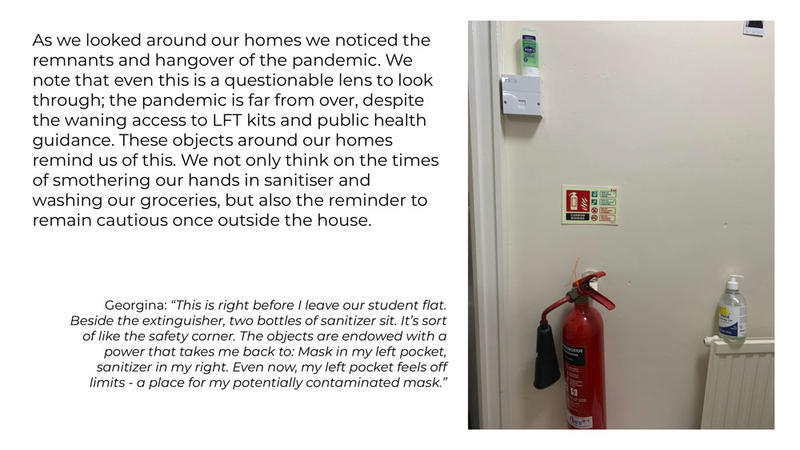

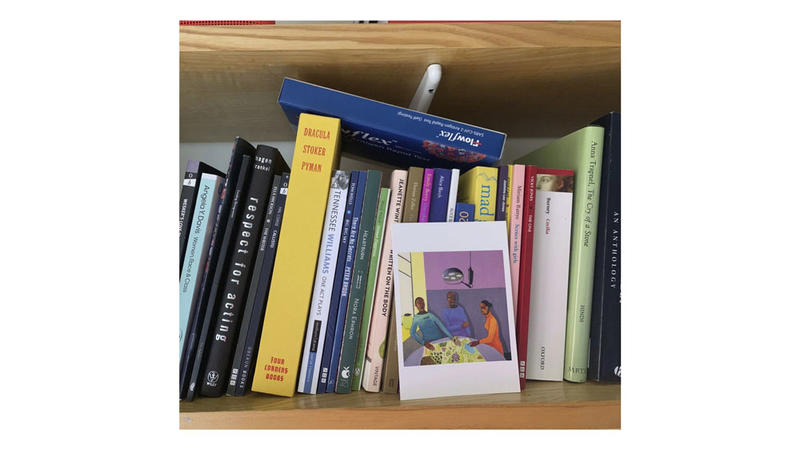
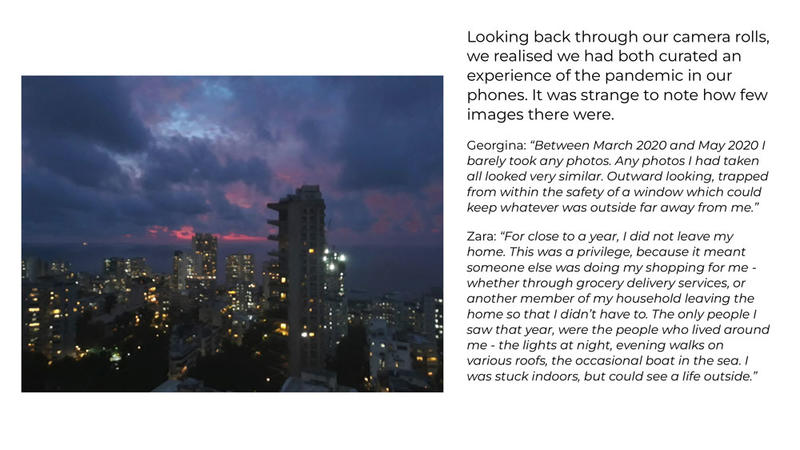
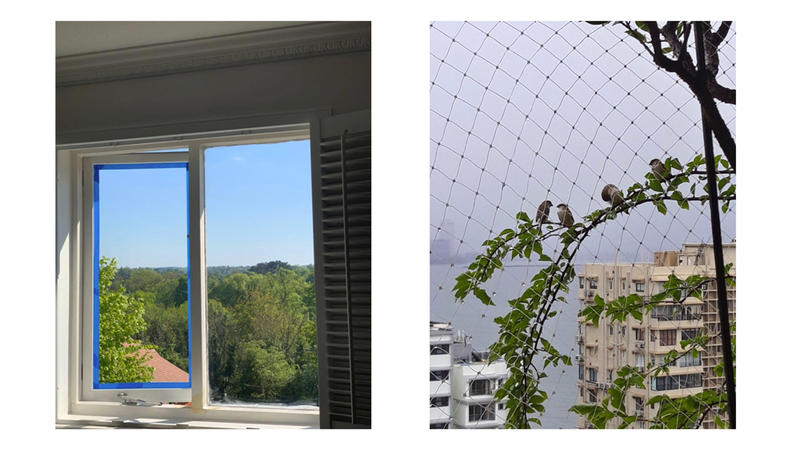
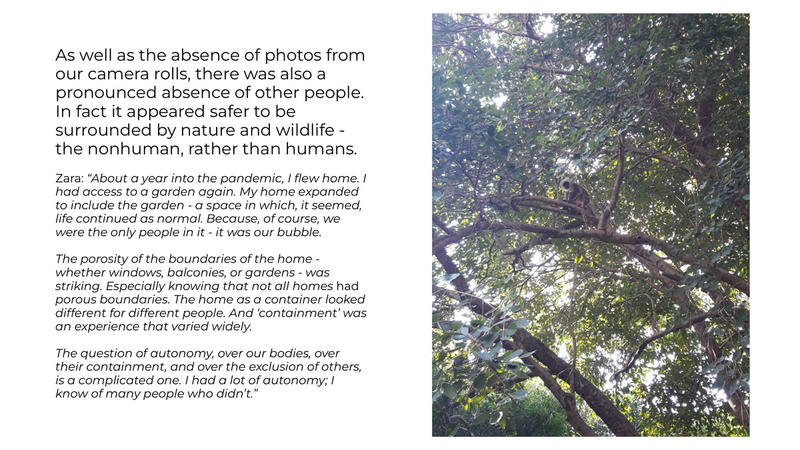
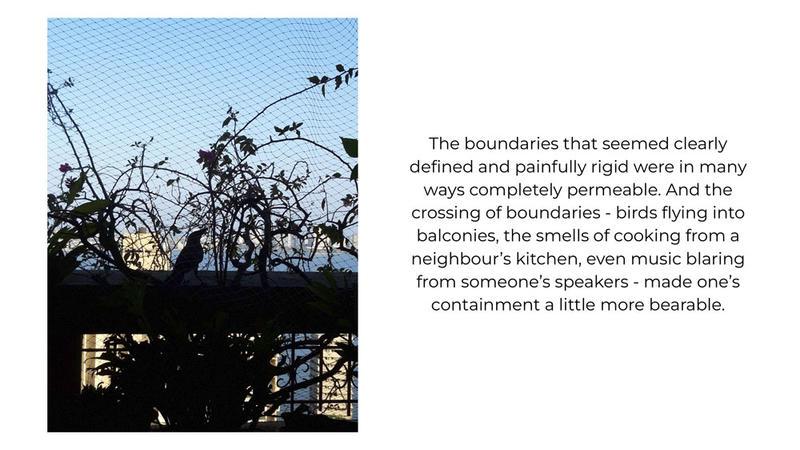
Week 6 was devised and led by AJTF Rachel O'Nunain, a DPhil researcher in English whose work focuses on the pseudonymous, Anglo-Irish writer Michael Field.
This post was written by Lara Garrett, who is reading for an MSt in Women's, Gender and Sexuality Studies at Worcester College.
Discipline
In this week's session, AJTF Rachel O’Nunain encouraged us to consider how containers - categories or areas of study - can be constrictive. While Krasis seeks to break down disciplinary boundaries, we start the programme by introducing ourselves in terms of our subject. Are we, then, being contained? Are we preventing ourselves from seeing how our work connects to other subjects? And what possibilities open up when we reconceive our research through different disciplinary lenses?
With these questions in mind, we moved onto the first exercise. Rachel passed round a cup, which contained everybody’s subject written on a piece of paper. Taking it in turns, we each picked out a slip and considered how to reframe our work in terms of that discipline.
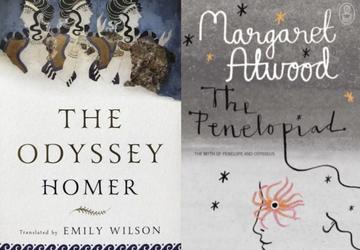
My research looks at late-20th and early-21st century feminism, and, having picked out Classical Archaeology, it took some time to work out how to link the two. I soon realised, however, that Greek and Roman texts have played a crucial role in shaping feminist writing. Homer’s Odyssey, reinterpreted by Margaret Atwood in The Penelopiad, for example, and Ovid’s Metamorphoses, reinterpreted by Ali Smith in Girl Meets Boy.
Reframing our studies in this way, thinking across disciplines, invariably opens up new opportunities. Indeed, making connections between subjects that are often separated out forms the basis of Rachel’s own DPhil research on 19th-century theatre, which looks at connections between naturalistic ‘sexual problem’ plays and the verse-dramas of Michael Field.
Scholars have generally treated naturalistic plays distinctly from verse-dramas. Thinking beyond these categories, however, points to commonalities between the two theatrical forms. Field, for instance, engaged with contemporary dramatic networks, including the plays of their older contemporary, Henrik Ibsen. Field’s work should perhaps, therefore, be reframed in dialogue with – not distinct from - naturalistic theatre.
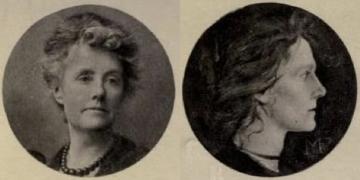
Katherine Bradley and Edith Cooper, together known as Michael Field
Rachel then revealed to us that 'Michael Field', whom we had all assumed to be male, was in fact the pseudonymous creation of Katherine Bradley and Edith Cooper, who were aunt and niece. Interestingly, their incestuous relationship has often been left out of the literature, scholars not wanting to acknowledge this ‘uncomfortable’ history. Again we see containment at work: scholars attempting to fit Bradley and Cooper into an ‘acceptable’ narrative rather than acknowledging their lives in full.
Week 7 was devised and led by AJTF Roman Osharov of New College, who is a DPhil researcher in History and who wrote this blog post. His doctoral research explores the history of the Russian Empire and Central Asia in the late nineteenth and early twentieth centuries with a focus on the role of knowledge production about Central Asia.
Where is Central Asia (in the Ashmolean)?
The Asian Crossroads gallery in the Ashmolean Museum introduces visitors to the history of Asia in a nutshell. In it, visitors are greeted with objects from Asia ranging from stunning models of camels from China in the period of the Tang dynasty to unique surviving fragments of textiles from Old Cairo. In Week 7, Junior Teaching Fellows and Scholars on the Krasis programme gathered in the Asian Crossroads gallery on the quest to find Central Asia in the Ashmolean Museum and in the contemporary historiography more broadly. What did they discover?
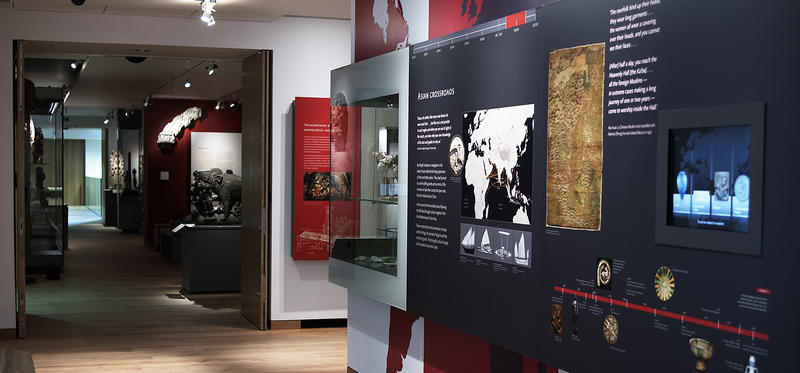
The symposium was dedicated to Central Asian history. The key question was simple, ‘What is Central Asia, and where is it?’ historically and more specifically in the Ashmolean Museum. A quick survey of the galleries and spaces by the participants of the Krasis programme showed that it’s hard to pinpoint Central Asia to a specific location in the Museum. Instead, Central Asian objects, albeit not many of them, are scattered throughout the Museum. They are to be found, for example 'on The Silk Road', in a display housing ceramics, documents and garments; ‘near Iran’, like a ceramic vase in the Islamic Middle East gallery; or ‘between India and Japan’, as seen in the Textiles gallery, where a stunning Central Asian ikat robe from the Robert Shaw collection is displayed between objects from India and Japan.

Elsewhere, another ikat robe brought by Robert Shaw is presented in a display dedicated to the conservation department at the Ashmolean Museum. It illustrates how much behind-the-scenes work goes to preserve textiles so that it could be studied and displayed. Other objects from the Robert Shaw collection – Central Asian textile hats and leather riding boots – are displayed in the Asian Crossroads gallery in a case titled 'The Silk Road'. This shows that at least in the Ashmolean Museum the bulk of objects on display pertaining to the history of Central Asia came from a single collection. This shows the difficulty of studying and teaching Central Asia at Oxford and elsewhere in the UK.
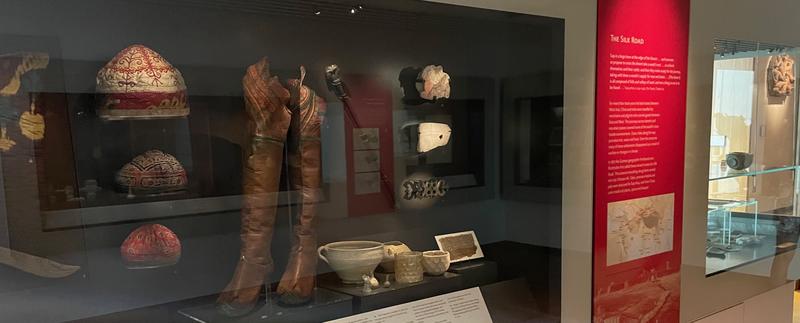
Hence, the main objects that the Krasis Scholars had a chance to examine were Central Asian textile hats from the Robert Shaw collection. Not all Central Asian hats and robes from the collection are on display – many of them are kept in the Museum’s storage rooms in large containers (incidentally, the theme of this iteration of Krasis).
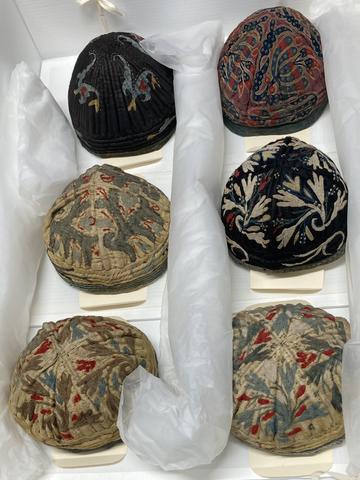
Robert Shaw (1839-1879) was an English explorer and writer who brought the objects displayed in the Museum today from his journeys in Central Asia, which he recorded in his travelogue published in 1871, Visits to High Tartary, Yarkand, and Kashghar. Thus, Shaw was single-handedly responsible for much of our public understanding of the nineteenth-century material history of Central Asia, certainly in the Anglophone world. The garments, like hats and robes, that Shaw brought to London are from Yarkand and Kashgar, but they are almost identical to those worn, for example, in Tashkent or Samarqand in the same period and therefore culturally representative of the entire Central Asian region.
The Robert Shaw collection came to the Ashmolean Museum in the 1960s after the closure of the University of Oxford’s Indian Institute, where it had been kept since at least the 1930s. But the collection was forgotten and for almost 60 years were contained in a storage room. The Shaw collection was rediscovered only in the early 1990s during a routine inspection carried out by Dr Ruth Barnes, a former textile curator in the Museum’s Department of Eastern Art. The garments – which were found in a very good condition -- were exhibited for the first time in 1995 and since then became permanent fixtures in several of the Museum’s galleries.
Elsewhere in the Ashmolean Museum, Central Asian objects were found in the Money gallery. Among the many coins on display, only one or two potentially represent Central Asia, although they are from present-day Southern Anatolia and Northern Pakistan. Finally, a contemporary Central Asian object was found in the Museum shop – a dress advertised as a ‘classic ikat jacket’ and made in a Central Asian country was on sale for £300 (pricey!).
The search for Central Asia showed that there is no dedicated space to Central Asia, at least in the Ashmolean Museum. Instead, Central Asian objects, such as those from the Robert Shaw collection, are scattered throughout the Museum’s many sections. This is especially noticeable when compared to other regions and cultures of the world represented in the Ashmolean Museum, like Indian and Chinese art. ‘Why there is so little interest in Central Asia?’, -- was one of the questions that followed.
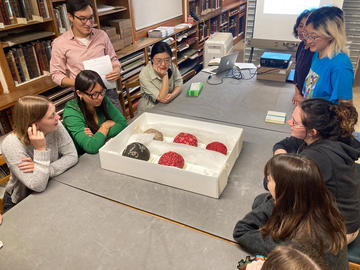
For many in our Krasis 14 cohort of Trinity 2022, which includes doctoral students and early career researchers in disciplines ranging from Classical Archaeology to Engineering, Central Asia remains a mystery, both in terms of its history and today. Some said that everyone understands immediately where South Asia, Southeast Asia, and East Asia are, not to mention Russia, China and Iran, that surround the Central Asian states. As one Krasis teaching fellow put it, ‘Central Asia is not on our mental map because it’s not out there’, for example, in museums or (most importantly) in courses that teach history.
But Central Asia, its culture and history have gradually become more visible to the rest of the world, especially since the early 1990s, when the five Central Asian countries became independent in the aftermath of the break-up of the Soviet Union. A recent example is the Gold of the Great Steppe exhibition at the Fitzwilliam Museum at Cambridge. The exhibition showcased recently excavated treasures of the Iron Age Saka people, like spectacular pieces of gold jewellery and bronze arrows, in the East of modern-day Kazakhstan. The most interesting objects in the exhibition were excavated as recently as a couple of years ago. And in 2022, two of the world's leading museums - the Louvre in Paris and the James Simon Gallery in Berlin - plan to hold exhibitions devoted solely to Central Asia.
Week 8 was devised by AJTF Chenying Liu, who is is in the 3rd-year of a DPhil in Engineering Science at Wolfson and St Hugh's. Her research spans origami and soft robots. Whilst looking into origami, the Japanese art of paper folding, Chenying goes beyond paper: her work mainly investigates how rigid materials like wood or metal can be folded and what robotic applications they can lead to.
Chenying fell ill at the end of term and was unable to lead the last Krasis of the year. Nonetheless, she gave us tasks that embodied both the simplicity and the extraordinary complexity of the folding technology she has introduced us to.
We folded for all we were worth.
To see and hear Chenying speak about her research (and origami), take a look at this video.
These two reflections on the experience of Krasis were written by Krasis Scholars Stephanie Armbruster and Isabelle Johnsen. Stephanie is an MSc student in Statistics at Somerville College; Isabelle is reading for an MSt in Archaeology at Hertford College.
Krasis
Stephanie: As the first statistics student to ever participate in Krasis, I was definitely an absolute outlier. I would be lying if I did not admit to having felt a little bit out of place and worried about my lack of knowledge about almost everything Krasis touched upon at the beginning. This turned out to be an unfounded and restrictive ‘container’ I put myself into, as Krasis taught me.
As a collective of humans, of students, of statisticians (in my case) we neglect too often that while we have agreed to consider objects and objectivity a common baseline in our objective world definition - a book is a vessel for a certain type of knowledge, an astrolabe is an astronomical instrument explaining the night sky - we all inherently think in different containers, shaped by the experiences, history and skills which underlie every supposedly objective item with subjective meaning. Consequently, my ‘natural science’ perspective was just one additional ‘container’ into which objects could be laid. By discussing with fellow Krasis members, I could distance myself from my own ‘container’ thinking, exploring the perspectives of others.
Isabelle: Attending Krasis this semester helped me to rethink how people from other subject backgrounds approach museums and their exhibits. As an archaeologist, you learn that context is everything. However, in Krasis, we learned about how containers can be changed, manipulated, and expanded or contrasted. This made me begin to think about how each profession, and each individual as well, highlights different parts of the context as the “most important”, and how these highlights might greatly differ from one another.
This demonstrated how important interdisciplinary work will be to me in the future. Just as objects have their own histories and are used differently throughout their lifetimes, methods don’t just undergo a linear progression from worse to better; rather, they adapt to fit their own context.
The field of archaeology today focuses on objectivity and scientific approaches during excavation. However, Krasis reminded me that the ‘containers’ into which we put objects during excavation may be changed throughout the objects' lifetime on display. In my experience, archaeologists rarely focus on how these objects that we find in the ground will find a completely new context and take on new meanings based on which ‘container’ a museum puts them in.
In order to understand objects better, perhaps we need to turn outward to alternative interpretations and weave them into our own understandings of the objects and become more interdisciplinary, rather than just becoming more and more specialized and putting that ‘container’ on ourselves and studies.
KRASIS 13
During Hilary term 2022, we explored the theme of Re-use from the perspectives of AJTFs working in English Literature, History, History of Science, Medieval German, Engineering, Musicology and Art History.
Week 1 was devised and led by AJTF Felicity Brown, whose doctoral research examines the relationship between myth and history, performance and politics, and the construction of the 'medieval' in early modern and Enlightenment thought, using social and ceremonial modes of performance to establish how King Arthur was deployed as a symbol of instability and innovation in early modern England.
This blogpost was written by Krasis Scholars Eliza Browning, a visiting student from the US, reading English at Lady Margaret Hall, and Risa Cooper a second-year undergraduate in English at Exeter College.
Re-using Things
The first session of Krasis 13 began at the harpsichord, the weekly meeting point for Krasis Scholars and Junior Teaching Fellows. But the work started when AJTF Felicity Brown led us to the Still-Life Painting Gallery, containing more than 90 outstanding 17th-century paintings by Dutch and Flemish artists.
After an introduction to the still life genre, we split into groups to count occurrences of popular objects in each painting - lemons, tulips, oysters. Whilst our colleagues counted 27 lemons and 42 tulips, we discovered 28 depictions of oysters, often arranged in groups, which raised questions surrounding their symbolism, glistening objects that reflected their surroundings. We also discussed the association of oysters with sexuality, a theme that recurred throughout the wider group conversation.
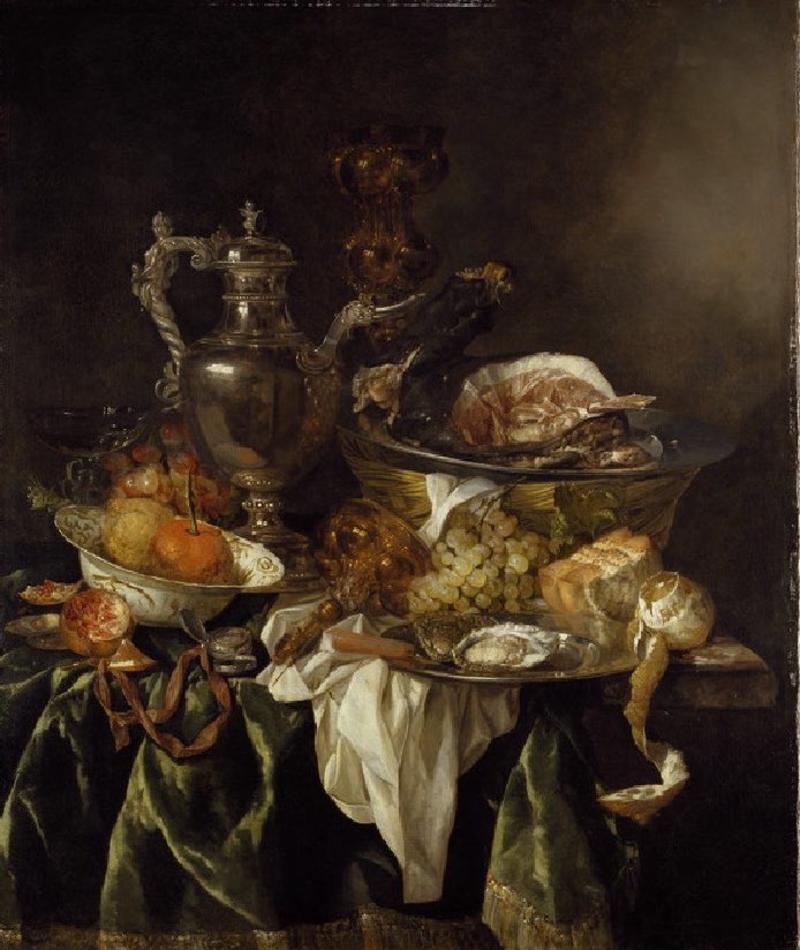
One of my groupmates noted that the juxtaposition of a closed and open oyster shell may have represented the seen and unseen world, as in the reflection of the painter in a nearby glass. The shape of the open oyster shell also mirrored a nearby timepiece, reminding the viewer of the temporality of this perishable object.
The precarity of the objects at the edge of the table emphasized their fragility, drawing the viewer into the frame. The inclusion of household objects in still life hearkened back to our collective focus on re-use, reminding us that common items often doubled as objects of great value and beauty within works of art.
Asked then to identify unusual objects in other paintings, we discovered a number of strange items including beetles and coins, and an imported Chinese vase that would raise questions about globalisation that we would later explore hands-on with objects from the Ashmolean's collection.

At tea in the Ashmolean Café, we were able to have a longer chat and start to get to know the other members of Krasis. As expected, whilst we ranged in our subject areas, our shared interest in material culture and everyone's friendly and open attitude made it very easy to feel comfortable in the space straight away.
After a short break, we headed to the New Douce Room, a stately yet inviting place full of old leather books and the occasional chime of an antique clock. Dividing into two groups we were lucky enough to handle a cornucopia of beautiful artefacts from around the globe. It was uncanny to see the objects we had studied so closely in brushwork actually before our eyes, and the experience added new depth to the paintings seen prior. My group handled a beautiful pocket watch, a repeated motif in still lives, which was wrapped in a leather case. Our AJTF, Mathilde Daussy-Renaudin, who works at Oxford’s History of Science Museum, commented that the intricate goldwork reminded her of Arabic astrolabes, which in turn prompted Jim to show us a Persian carpet, in which the pattern of the threads resembled the metalwork of the clock.

Alongside these, we looked at a wide range of banqueting objects similar to those depicted in the paintings: glassware, a silver bowl with floral embellishment, a stoneware pot, also mounted with silversmith’s work and a dish decorated with people dancing and playing music around its interior.
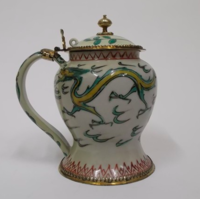
We also examined a large, porcelain dish with a floral decoration and gold embellishment, inscribed with the name of Wanli, 14th Ming Emperor of China, but of later date and made for export by the Dutch East India Company. We compared it with a porcelain tankard, created in China during Wanli’s reign but exported and then mounted with silver-gilt fittings by a European goldsmith.
Finally, we were given frames, fabric, shells and silk flowers to create and photograph our own still lives. This practical experience was very thought-provoking as we thought about form, texture, tone and colour - but also the symbolic meaning of certain objects: a watch amongst flowers, for example, perhaps highlighted the moralising message that all beautiful things must fade. Setting up our own compositions highlighted that whilst on one level naturalistic, still lives were essentially artifice: as Mathilde pointed out, many paintings incorporated fruits and flowers not in season at the same time.
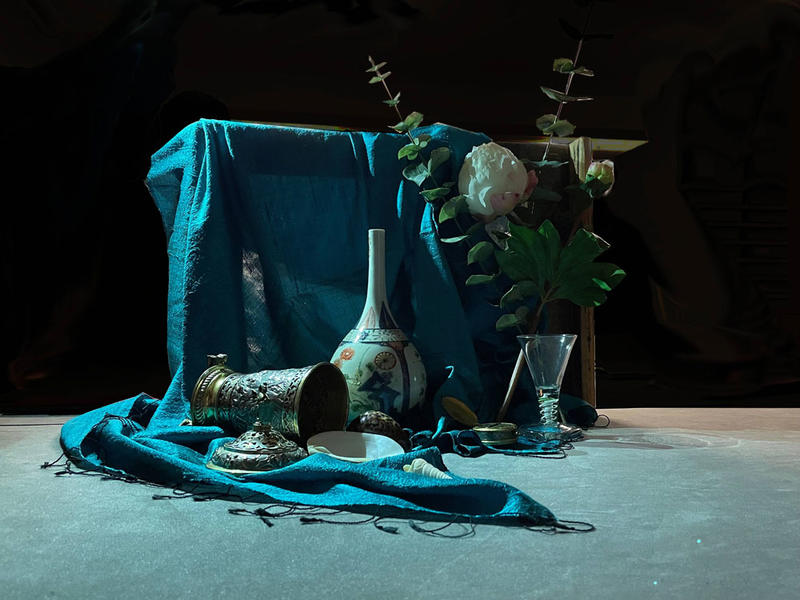
Still Life created during Krasis 13 Week 1; photograph enhanced by Laurel Rand-Lewis
Whilst chatting with Felicity, I mentioned that I always used to skip straight past still lives because I found them to be boring and found little difference between the individual paintings. The session completely overturned past prejudices: still lives are actually dynamic, incorporating flora and objects of global trade, and showing implicitly the continual cycles of time: flowers in bud, fruit starting to rot, other objects deployed symbolically to create meaning. Mostly, I am grateful to Krasis for starting to teach me the art of close observation: a little more discipline in looking at things heralded great discoveries.
Week 2 was devised and led by AJTF and historian Elena Porter, whose DPhil research focuses on postwar British cultural policy as it related to the preservation of country houses and their contents.
This blogpost was written by Krasis Scholars Holly Anderson, a third year undergraduate in History at Lady Margaret Hall, and James Green, a second year undergraduate in English and Classics at Exeter College.
Re-using Images
Jane Austen famously begins Pride and Prejudice with a ‘truth universally acknowledged’, so it was fitting that when asked initially in Week 2 of Krasis 13 to sketch (badly) our image of a traditional English country house, we turned almost universally to something vaguely resembling Chatsworth, which stood in for Pemberley in the 2005 film adaptation of the novel. We found common ground on that estate, in its neoclassical columns, bucolic vistas, balconies and terraces and much else besides. But whence came these connotations?

Confronted by a group of objects in the New Douce Room – a small silver container, architectural drawings, and watercolours of country houses – we began to unpack the network of association which supported our shared imagination, seeing ‘exotic’ designs through the lens of architecture and buildings through the lens of cultural appropriation.
This reciprocal framework proved deeply productive, steering us towards two central figures whose architectural voices still echo around many great British buildings of the 17th and 18th centuries: Vitruvius (c. 1st century BCE) and Palladio (16th century CE). In discussing their influence, we were performing something of a nested exorcism: reviving English builders' revival of Palladio’s revival of Vitruvian ideals.
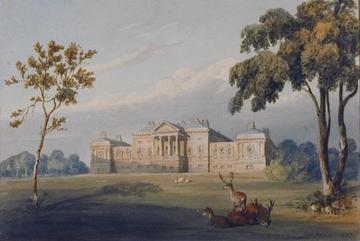
The Palladian aesthetic – of harmony, proportion and symmetry – was one developed (in part) from the (unillustrated) writings of his Roman predecessor. Thus, the buildings we find preserved across the English countryside are themselves preservations of a 16th-century idea of an antique architectural ethos: the cosmopolitan was concomitantly the archaic, true to the spirit of the European Renaissance. Paradoxically then, these magnificent structures, conserved for re-use in the interests of the heritage industry, have long been performing a re-use of sorts.
At this point, we were ready to depart from the English country house and embark on a journey through cultural iconography more broadly defined, including its manifestations in and around the Ashmolean itself.
Examining what the Ashmolean had to reveal about the iconography and changing function of the English country house pushed us to consider the words of historian Robert Hewison in his seminal work, The Heritage Industry:
‘In the twentieth century museums have taken over the function once exercised by church and ruler, they provide the symbols through which a nation and a culture understands itself.’
Like the country house itself – somehow emblematic of English culture, despite its many borrowings - the museum, according to Hewison, possesses a similar function. It has the power to shape our image of different cultures, displaying artefacts selectively, seen through the eyes of a curator to appeal to (educate?) a broad public audience. For many, it is their only contact with other cultures and helps form a worldview, perhaps defined by golden trinkets, dramatically woven garments and ostentatious portraits.
It is interesting to consider how the country house and the enduring role it plays in popular culture is informed by similar self-conscious, historically selective decisions; a facade incorporating classical and renaissance traditions, crafting an image closely associated with the landed aristocracy, yet almost entirely imported from other places and periods.
The interaction between cultural traditions in the construction of the country house went beyond simply following a view of western antiquity. The popularity of Eastern style had a marked impact upon the interiors of England’s 18th- and 19th-century homes.
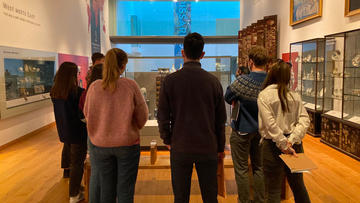
We took a closer look at a Japanese lacquered chest, adorned with delicate flowers, pastoral scenes and pagodas, made for export and once in the home of a wealthy English patron. The appeal of oriental styles speaks again to a process of cultural cross-fertilisation, a product of new and expanding world markets, as well as changing aesthetic taste. It’s fascinating to consider how an object so seemingly in conflict with the quaint interiors we associate with country houses and National Trust properties, represents one of their key features – the complex interweaving of different styles and traditions.
The same discourse emerged from other objects in the Museum’s collection, including a narrative painting and a Pre-Raphaelite cabinet. There was little around us in the Museum that couldn’t be productively subjected to the same analytical framework.
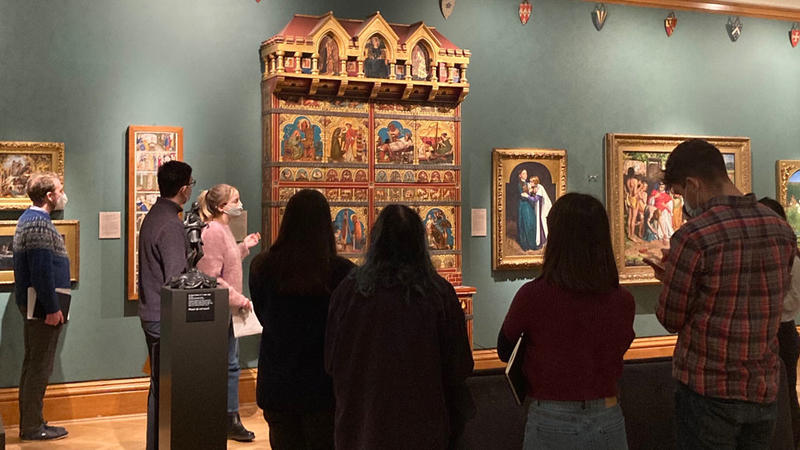
Ultimately, it was revealing to see how our understanding of an English country house has been shaped by our own contemporary popular culture and that the image of what we associate with native tradition can be complicated by an understanding of the stylistic and economic currents, the traditions of appropriation and re-use which helped define English taste.
In the denouement of Pride and Prejudice, we hear Darcy making a recommendation to Elizabeth: ‘Think only of the past as its remembrance gives you pleasure.’ What this Wednesday afternoon at Krasis taught us was that objects and buildings can, if interrogated, teach us that pleasure, the past, and its remembrance are bound together in a more puzzling (perhaps even troubling) way than is apparent at first sight.
Week 3 was devised and led by AJTF Mathilde Daussy-Renaudin, who is a collaborative doctoral award-holder, working at Oxford’s History of Science Museum and University College London. Her research focuses on the labelling of astronomical objects and the use of categorical terms such as ‘science’, ‘religion’, ‘belief’, ‘Islamic’, or ‘European’, exploring their historiography and challenging the way we use them
This post was written by Krasis Scholars Giulia da Cruz, who is a 4th-year undergraduate in French and Arabic at Christ Church, and Daniel Morgan, a 2nd-year Historian from Lady Margaret Hall.
Re-using Collections
What stories is a museum telling us?
When looking around a museum, the most visible dynamic seems to be that between the artefacts and the public. Visitors from different age groups and backgrounds and with varying perspectives, interpret the artwork and objects according to their own unique frames of reference. However, another dynamic, equally important but perhaps not as evident, is that between the visitor and the curator. After all, although great debts are owed to the civilizations whose artefacts now fill the cases of the Ashmolean, it is the Museum staff who not only shape the public experience of the Museum but also, more importantly, tell the stories of the collections.
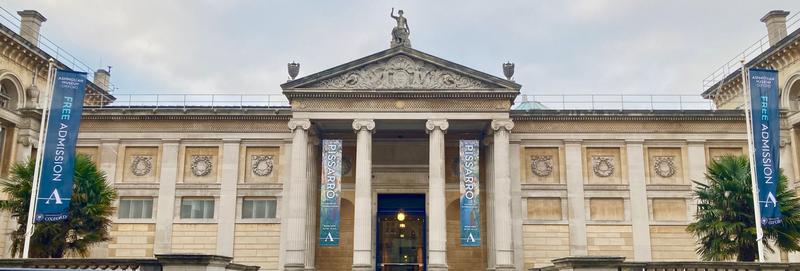
After the 2009 reconstruction of the Ashmolean, the Museum layout was no longer split neatly by department but was redesigned around the theme ‘crossing cultures – crossing time’. Jim Harris reminded us of the importance of the many decisions behind the layout of the Museum and the curation of the galleries. Indeed, what the public sees is not a random assortment of objects, but instead the result of recent and carefully-considered curatorial and managerial choices.
This week was led by AJTF Mathilde Daussy-Renaudin, who brought her research challenging museum labels and categories to the Krasis roundtable. Where better to start the session then, than in the ‘West Meets East’ gallery. The labels of ‘West’ and ‘East’ have an extensive literature of criticism, especially within History of Art. Unlike a usual visit to a museum, we focused on the labels beside each exhibit, rather than the objects themselves. This was an intriguing shift of attention. We realised that often we are so drawn to the range of the artefacts before us, that we find ourselves passively consuming the information beside it. In this session, however, we instead looked for the contexts behind the objects, both across their histories and their journey to the Ashmolean.
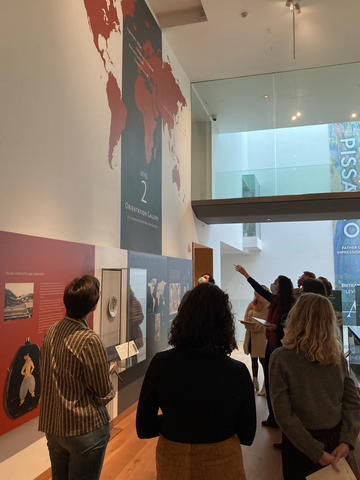
Our first response to the ‘West Meets East’ gallery was that it was based on clear, and perhaps rather reductive, periodisation. We noted how the displays, constrained by the nature of the collections, showcased luxury goods which had travelled from East to West from the 16th century onwards, thereby overlooking centuries of exchange and trade from before that point.
The gallery is therefore not so much a history of Eastern-Western interactions, than a showcase of the wide luxury trade in the (so-called) Age of Discovery, facilitated by advances in Western shipping and colonial expansion. Moreover, the generalist nature of the term, ‘Eastern’, was further highlighted as the majority of the objects in the room were manufactured in China or Japan.
The subheading for one of the displays, ‘Chinoiserie: a taste for the Orient’, prompted a discussion on the concept of ‘taste’. Taste is, of course, subjective but the western fascination with the ‘Orient’ has long been documented and ‘oriental’ motifs were once revered by wealthy elites across Europe. We also explored the connotations of feasting and consumption, especially with regards to the Western colonial project.
With many of the objects in this gallery manufactured for export to Europe, we felt that the ‘meeting’ between the ‘East’ and ‘West’ was rather one-directional, with most of the precious objects and resources permanently leaving Asia for Europe. Labels prioritised European provenance over Asian points of origin, and a set of porcelain vases, lacquered and with mother of pearl inlay, were described as being ‘from Althorp’ before any mention of their manufacture in Japan c. 1700.
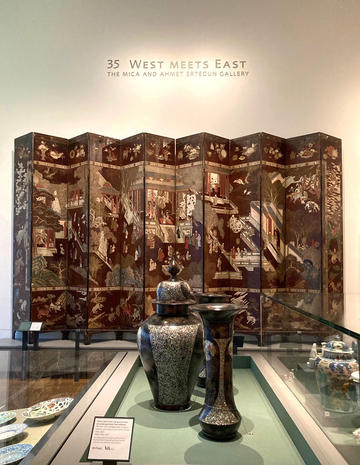
The complexity of naming and categorising was evident in the label for a ‘Coromandel screen for a stately home’ purchased for a baronial seat in the English Midlands. It was of a type named for the coast from which it was exported in southeast India, but it was originally manufactured in China, and the label had also to include its final destination. As we can see, the European provenance of these objects has been highlighted, whereas the story of their production and manufacture are secondary, perhaps due to a lack of documentation.
In the second half of the session, Mathilde gave us the opportunity to curate our own hypothetical exhibition. Providing us with an individual object – a coffee cup, a snuff box, a gold coin – we brainstormed about the different ways these objects could be displayed. For example, displaying the cup in its intended setting, similar to the table setting in the Ceramics gallery; looking at its use, situating it next to objects of different origins but with the same function; or tracking its journey, both geographically and physically – from a clay lump to an enamelled coffee cup on a fashionable table.
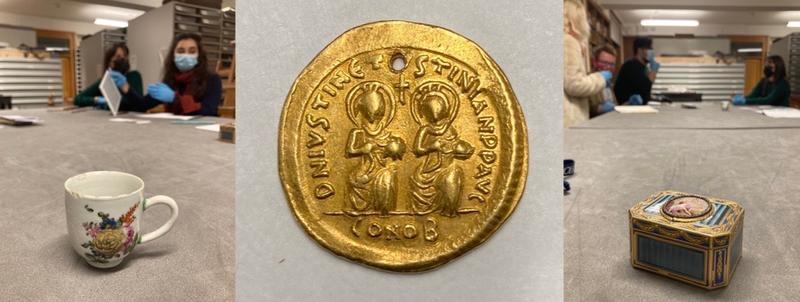
After this session, it is likely that Krasis students will always walk around museums with a more critical eye regarding layout and labelling; and perhaps feel a heightened respect for the curators who have the challenge of deciding how to categorise and re-categorise objects that transcend geographical and chronological boundaries, belonging to many different cultures across their long lives.
Week 4 was devised and led by AJTF Dr Linus Ubl, who is Departmental Lecturer in German at Somerville College. His research interests lie largely in religious literature, for example legends and mystical texts, circulating in medieval Germany.
This blogpost was written by Kate van Riper, who is a visiting student from Brown University in Providence RI, reading English and Classics at Lady Margaret Hall, and Hector Worsley, who is in the second year of English and French at St Catherine’s College.
Re-using Books
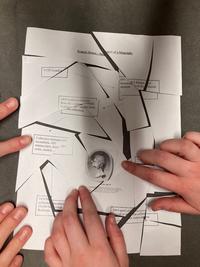
Reconstructing Douce's Biography
This week’s Krasis session focused on the collection of Francis Douce, an antiquary, collector and museum curator who left much of his collection of manuscripts, books, prints and coins to the Bodleian library on his death in 1834. Linus began by asking us a question: if we could take just one page from one single book to a desert island, which page would it be and why? The group’s answers ranged from the philosophical to the poetic to the practical (a map!). While this was a fun thought experiment, Linus also used the question to jump into a discussion about the process of removing an aspect of art or literature from its broader context.
He asked questions like: would you feel okay about cutting up your book to get your desert island page? How important is it for a book or collection (or the parts of a book or collection) to be stored together? These inquiries are relevant in the context of Douce’s collections, which feature many isolated pages and images that he either cut from their sources or found already dismembered.
Kate: 'After getting to know Douce and his modes of collecting, we got to investigate some of his collection. Hector, Linus and I were assigned a box full of 15th-century German woodcuts, all cut out from their original sources. Together, we tried to figure out how the Ashmolean had organised them. Another group took on the task of examining two manuscript catalogue volumes describing the collection as organised by Douce himself and explained to us how Byzantine and idiosyncratic the system was. Other groups looked at unmounted prints still gathered in Douce’s own portfolios, and at prints he had cut out, stuck into albums and annotated.

Douce's Albums and his rationale for ordering their contents
'This exploration got us thinking about the many steps between the creation of an object or image and its collection and display in a museum. If Douce kept certain pages together, should the museum keep them together as well? After our discussion, I was leaning towards yes; though the idea of Douce tearing pages out of books is certainly jarring, Douce’s eccentricities added a whole new layer of interest to the collection.'
Hector: 'After a brief tea-time hiatus, we divided up to delve into the Museum's approach to transformed objects. Focusing on the Italian Renaissance gallery, Kate, Linus and I inspected a large, square painting of the Resurrection by Tintoretto. However, the painting had originally been octagonal and had been anachronistically altered to fit a square frame, with dark shadows added in the new corners and stitching visible on the surface of the canvas. Should the Museum keep the adapted sections?
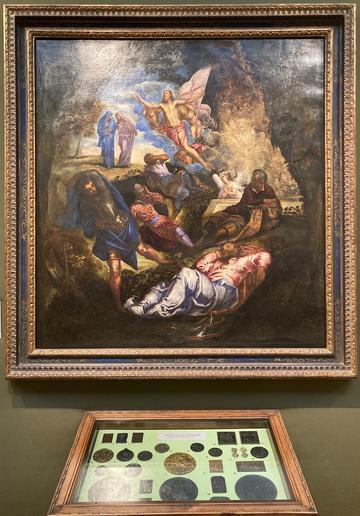
Tintoretto's re-shaped 'Resurrection'
'Methods of overcoming this issue were suggested. The Museum could show the original form on the label, or perhaps deploy a projection to distinguish between the original and the amended shapes. Naturally, a compromise between the painting’s transformation and the museum’s display had to be struck: there is an inherent gulf between the Museum, an object's original setting, and the collection for which it was later altered. This led to an interrogation of a museum’s objective: should it principally be to educate (about the objects as it now exists), or to emulate (the objects's original state)?
'Other groups explored similar curatorial predicaments. The collection of antique statuary, together known as the ‘Arundel Marbles’ was at the forefront of discussions: bodies often did not match heads yet had been put together to create an aesthetic viewing experience. Whilst the decision made sense from a collector’s perspective, as the viewing experience was enhanced by seeing complete statues, this came at the cost of authenticity. However, it is also worth asking who has agency in these decisions? Collectors? Museums? The public is often omitted from the conversation, creating problems of the elite few gatekeeping art from the masses.'
Overall, the session made us interrogate the thinking behind the Ashmolean's public galleries and its collections storage and organisation. Museums act as beacons of education and must respect this power when it comes to their displays, overcoming potential obstacles to understanding, such as past acts of destruction, alteration, and censorship. Ultimately, we realised how it is impossible, and occasionally undesirable, for the past to be perfectly emulated and recreated (we cannot reconstruct Douce's dismembered books); yet education is only possible, and arguably enjoyable, when museums act as passageways into the (re-used, redeployed) wonders of the past.

Tracking down a print of John Calvin in the Douce collection
Week 5 was devised and led by AJTF Dr Tom Metcalf of Worcester College, who is a composer and lecturer in the Music faculty.
This post was written by Chloe Green, who is reading for a Music degree at Somerville, and Dominic Madera, who is in the second year of an English degree at Exeter.
Re-using Parts
On a blustery February afternoon, Krasis convened in the basement café of the Ashmolean Museum, with music on our minds and in our ears. Prior to the session, Ashmolean Junior Teaching Fellow, Dr Tom Metcalf had shared with us an intriguing playlist, which juxtaposed works of Franz Schubert, George Crumb and Frédéric Chopin via Eugen Cicero and Tom himself. In response to this music, we asked ourselves, ‘what does it mean for an object to be an “original” or a “copy”?’ If an original object can be said to exist, does it change when transposed across geography and time? Do broken pieces of Greek classical architecture, for example, become a new object when rearranged by curators? Is meaning ultimately contingent on the audience’s interpretation of the object, or the context from which it is extracted?
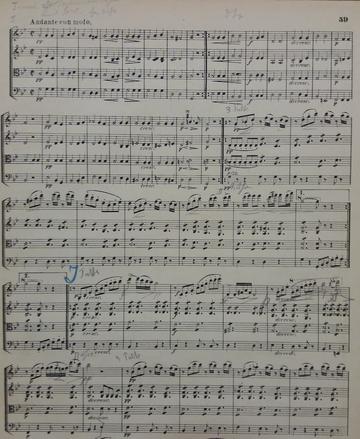
Schubert's string quartet 'Death and the Maiden' annotated by Mahler
Gathered around café tables, we engaged in a metacritique of interpretation, interpreting the act of interpretation itself. Like you do.
We began by problematising the topic of re-use in a musical context, starting with Schubert’s quotation of his own 1817 lied Der Tod und das Mädchen (Death and the Maiden) in his 1824 String Quartet No. 14 in D minor, D. 810.
From the concept of self-quotation, relevant in music and many other disciplines such as literary and aesthetic studies, we transitioned to the question of quotation more broadly. In Movement 6 of Crumb’s 1970 composition Black Angels (13 Images from the Dark Land), Schubert’s Death and the Maiden motif reappears, transformed.
Crumb’s instruction that his performers emulate ‘a consort of viols’, in ‘a fragile echo of an ancient music’, constitutes a contemporary relocation of a Romantic work into a distant past, evoking a complex tension between modernity and antiquity. The art of (re)interpretation reveals the intertextuality of relationships between 'original' and 'new' and destabilises these categorisations altogether.
The various soundworlds of Death and the Maiden delivered us into discussion of The Death of the Author, which Roland Barthes theorised in 1967. Is it possible ‘to give a text an Author’, in Barthes’ terms, where its creators are multiple? (In 1965, Eugen Cicero swings Chopin’s Prelude in E Minor.) Can nature function as Author also? (The trajectory of the River Danube structures Tom Metcalf’s 2020-21 composition Folyò.) Our critiques of the 'ego' and 'eco' alike foregrounded the role of live-ness in art, which we analysed through the lens of Walter Benjamin’s 1935 essay The Work of Art in the Age of Mechanical Reproduction. Benjamin’s notion of aura – the authority he ascribes to unique art works – and its decay readily suggested to us the possibility of analytical breakdown
Enter the assignment of the day: fictitious interpretation. Through this exercise, we delighted in creating alternative histories for objects on every floor of the museum, in dialogue with their labels. Our revisions provoked a range of responses, from laughter to serious conversation, as we radically re-contextualised ancient sculpture, 14th-century pottery, and 20th-century paintings.
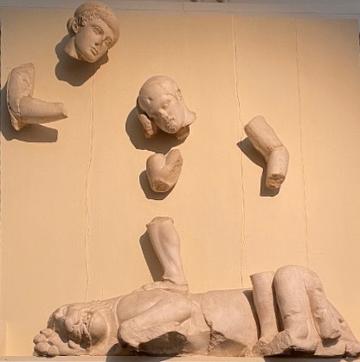
The Ashmolean's cast of the fragmentary metope of Herakles and the Nemean Lion
In the Cast Galley, for instance, we interrogated the negative spaces of Herakles and Nemean Lion.
The largely absent bodies of the supposedly living Herakles and Athena, and endurance of the ostensibly dead lion, led us to view the work from a post humanist angle. Nature lives on in death; while all that remains of humankind are remains themselves, these disembodied heads and joints, our minds and our movements.
In this light, the dead lion transforms, paradoxically, into the most human figure within the display. What was once Herakles and Nemean Lion becomes, to us, a noli me tangere, or touch me not: an exploration of the way we, as contemporary viewers, are drawn to the lion’s suffering over the disembodied limbs of the demigod and goddess. Negative space generates intertextual reuse and adaptation, and, from there, a new object.
The missing elements of the cast inspired us to ekphrasis: influenced by 'erasure' or 'blackout' poetic techniques, we reworked the original label to support our new materialist interpretation. The activity led us to the conclusion that making meaning always leaves phantom traces of originals and copies. Processes of adaptation and reuse invite a multiplicity of perspectives on objects, which incorporate various interpretations – of curators, scholars, museumgoers, and more – into their histories.

A vital aspect of Krasis is its interdisciplinarity. With Tom at the helm, we brought musicology to bear on the Ashmolean collections. In Lydia Goehr’s seminal 1992 musicological text, The Imaginary Museum of Musical Works, she explicates the ‘work concept’ in music. Goehr’s writings might encourage us to consider 'artwork' more generally as 'art' plus 'work': as our reworked label reads, ‘the hero is labour.’ Although, through Krasis, we occupy a very real museum (as opposed to Goehr’s imaginary one) our imaginations certainly, and fortunately, flourish within.
Part of this imagination comes from the intellectually demanding task of engaging across disciplines. Through our experiences of two divergent academic fields (Music and English Literature, respectively), we exercised our academic and aesthetic imaginations within the symposium. As we exited the Ashmolean into the Oxford early evening, Tom concluded, ‘I hope you learned something – or unlearned a lot of things.’ Both were true.
Week 6 was devised and led by AJTF Chenying Liu of Wolfson College, who is a DPhil researcher in Engineering Science working on origami, folding technology and soft robotics
This post was written by Deanna Cunningham, who is reading for a Masters degree in Archaeology at Hertford College, and Seren Atkinson, who is a 2nd-year undergraduate in English at Christ Church.
Re-using Shapes
On an unsuspecting, drizzly, Wednesday afternoon, eight students and four ECRs were about to have their minds changed forever by the technological genius of this week’s teaching fellow, Chenying Liu. Krasis is designed with the principal aim of bringing together teachers and students of different academic backgrounds to challenge and expand our ways of thinking, which could not be a sounder way of thinking about our experience on that rainy day!
Chenying’s session focused on what origami is and how it might be used: thereby bringing together the disparate strands of arts and sciences and showing us that they were not so separate after all.
Before we arrived at the New Douce Room, Chenying had requested that we each make a piece of origami and bring it with us. As we convened at the table, both of us felt slightly ashamed at our lack of origami skills, with two (slightly battered looking) butterflies to show for our efforts. Much to our relief, Chenying’s subsequent request was that we flatten our creations back into paper. We then began to look more carefully at the crinkled indentations left in the wake of our origami shape. The fact that our tiny creations were made of paper was, of course, important, but the tiny mountain and valley folds - a technical term we soon found out - were what transformed the possibilities of a single piece of paper.
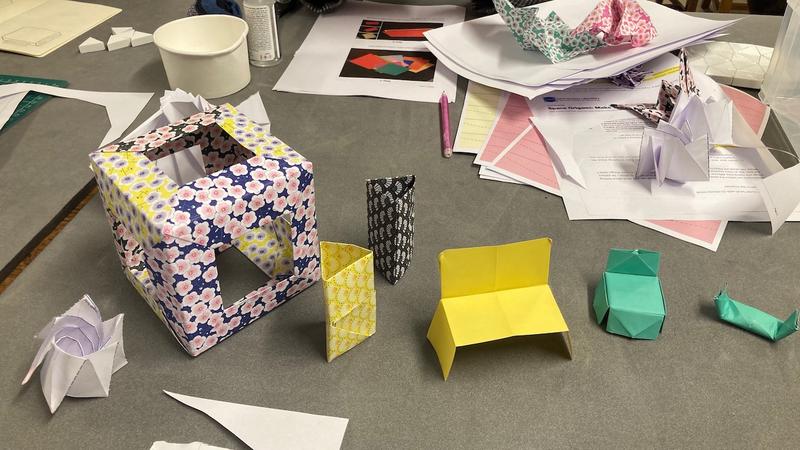
Etymologically, Chenying explained, 'ori' means to fold in Japanese and 'gami' comes from the word 'kami', meaning paper.
However, moving from paper to clothes formed our next challenge. As we rolled up the various tea towels, shirts and socks we had brought with us, we considered what our acts of folding involved and why we performed them. Most of all, our folding made our various articles of clothing more compact and neater, making storage more efficient.
Chenying revealed that the economies of space generated by folding materials characterised much of her doctoral research. It was at this point that our minds were about to be blown.
For engineers seeking to put technology or people into orbit, Chenying explained, utilising shapes that could be moulded and changed, as well as maximising space, was essential. This is especially crucial for power sources that rely on solar energy once in orbit. Tapping into and maximising the potential of solar panels is, therefore, one of the main challenges facing engineers like Chenying.
We soon discovered that our experiments in origami and clothes folding were merely a warm-up for one of the biggest dexterity challenges of this, or indeed any Krasis. Arriving fully equipped, Chenying handed out sheets of paper marked out with the pattern for making our own mini solar panels.
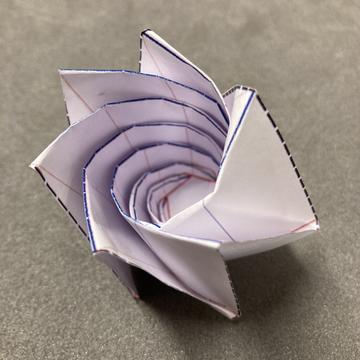
We set to folding the mountain and valley lines correctly according to the instructions on the NASA worksheet (which you can find here). After 20 minutes of intense focus and a few difficulties in getting the final flourish that twisted the solar panel to life, we each had made our own mini panel (see the picture!). We felt oddly emotionally attached to this little bit of paper, and one of us, not to name names, still has theirs proudly on their desk.
Having created these paper solar panels, we thought about the limitations of what we’d made. Even with our collectively limited STEM knowledge, there was a consensus that paper was probably not a good material for storing solar power and that other materials would have to be used instead.
Chenying, ever resourceful, brought out a box of what can only be described as ‘drywall-like’ 3D triangular chips. We were then tasked with joining and creating possible solar panel shapes with thicker materials. We set about sellotaping triangles together in small groups to develop flexible, robust structures. Descriptions of these structures escape us, and our drawings are not much better; as per this quick sketch! However, if you want to see our tiny, folding structure you can see it here on Krasis twitter.
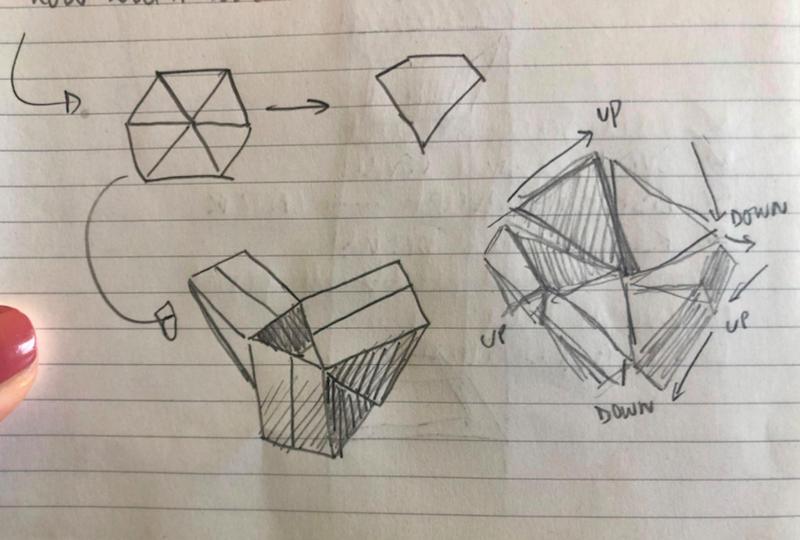
Having completed and been utterly mesmerised by our moving constructions, Chenying showed us the larger and more complex structures she’d built. These caterpillar-like structures were fluid and moveable only in specific directions, whilst others were rigid and solid. There are infinite possibilities inherent in sheets of material that can be manipulated or joined together. The triangles, either equilateral or isosceles, moved in regular and predictable ways.
Chenying explained that if a computer programme was told the shapes and their patterns, they could then predict the outcome precisely and infinitely. Meaning the development of artificial intelligence could create the most optimally compact, manoeuvrable and flexible structures out of potentially millions of smaller shapes. And it was at this point that our small group consisting of Seren, Deanna, and Teaching Curator, Jim, began to ponder the (slightly terrifying) possibilities of AI within cultural heritage sectors as well as the wider world.
After a (much needed) tea break in which Chenying showed us a video of a robotic claw, made from the same spiralling shapes of triangles, safely picking up and putting back down an egg, we returned to the galleries.
This time, we split up into groups on the hunt for specific shapes we could see in the basic structure of the Museum. Our group was on a quest for various forms of cuboid, which, within a museum full of glass cases displaying all kinds of objects spanning thousands of years, we soon found everywhere we looked. However, the display cases in question were often made up of much more than a single cuboid, with pyramids, trapezoids, and even an eight-sided pyramid.
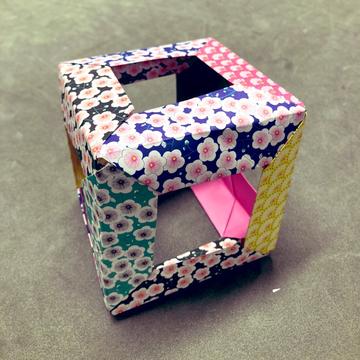
Back in the New Douce Room we got to work on a whole-team activity: recreating a form that mirrored the cuboid display cases we had been surrounded by, but never noticed throughout the galleries. Each student and teaching fellow had responsibility for one piece of origami paper.
Under Chenying’s supervision (and with her frequent necessary interventions…), we managed to fold the pieces of paper into the correct trapezoid shape. From here, Chenying fitted the 12 parts together to bring the display case frame to life.
Finally, we shared our final thoughts on how our perceptions of the Museum had changed. Even within the whistle-stop two-and-a-half-hour introduction to the sciences of soft-robotics and folding engineering, we could see how our approach to the Museum had fundamentally shifted.
The Ashmolean is a place full of different socio-cultural values. But it is also a set of rooms housing material things, each with unique dimensions and physical qualities, but containable in cases whose forms all obey the fundamental principles of engineering and mathematical science. And so, buoyant from making our paper recreations of the fundamental principles, we headed back out into the Beaumont Street rain.
Week 7 was devised and led by AJTF Jiaqi Kang of Lincoln College, who is a DPhil researcher in History of Art. Their research examines the relationship between hygiene politics (discourses of health, contagion, and pollution) and art of the postsocialist period in China. They were previously a Krasis Scholar in Krasis 5.
This post was written by Hannele Hellerstedt and Laurel Rand-Lewis who are colleagues on the MSt in History of Art and Visual Culture, at Keble and St Cross College respectively, after undergraduate study and Brown University and Middlebury College.
Re-using Maps
We think of maps as an objective tool, guiding us through space where numerous steps have trailed before. They orient us to our surroundings, from a macro to a micro scale, imprinting in our minds a sense of their material facts. Through the use of this tool, we participate in a broader, objective truth of the world - or so it seems.
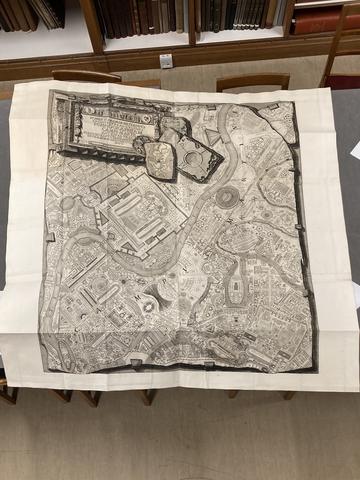
The lines between reality and fiction begin to blur in Piranesi’s unfeasibly enormous, engraved map of the Campo Marzio in Rome. The fine rendering of every building – the intricate notation of columns and other architectural features in a painstakingly detailed plan view - communicates what seems a reality, despite coming almost entirely from Piranesi’s imagination. A ‘fragment’ of the ancient city plan only partially supported by archaeological exploration, Piranesi’s map makes us wonder: to what extent do maps communicate reality - and whose reality might this be?
Our understanding of spatial reality has changed over time, expanding as connections between continents and cultures became globalised. For James I, Ortelius’s atlas provided the mechanism for reality to become a possessable object, depicting the known world to that point.
Facilitating a visual and textual engagement with the world, the atlas highlights an early-modern, Eurocentric perspective, as distinct, small regions of Europe were given equal weight as the entirety of the newly ‘discovered’ American continent. Thus, cultural capital becomes skewed, projecting a European gaze upon a landscape already steeped in history.
This process of (re)mapping erases the indigenous conceptions of space and history, prioritising a European colonial worldview.

For British colonists in the United States, cartography became a means of controlling the landscape, often through the ‘discovery’ and (re)naming of landmarks, regions, and settlements.
When maps included indigenous place names, the translation to English and into a foreign cartographic structure stripped many of their full meanings. This legacy of colonial erasure is being challenged by indigenous communities through cartographic projects meant to map the traditional place names of a region, such as Margaret Wickens Pearce’s work with the Penobscot Nation.
Pearce has emphasised the embodied nature of the map – to appropriately convey the meanings and significance of Penobscot place names, the map-user was required to activate the space around them. The map became a story, living history being passed along as one followed the plotted routes.
Inspired by Pearce, Piranesi, and others, Krasis turned to the Ashmolean Museum under the guidance of AJTF Jiaqi Kang, questioning the choices made in the map of the Museum displayed in the visitor’s guide.
Like the atlas, pictures and words came together to convey spatiality; however, the closer we looked, the more questions seemed to emerge. A glance at any number of the floorplans revealed much of the building to be absent, hidden from the public gaze in what is assumed to be a public institution.
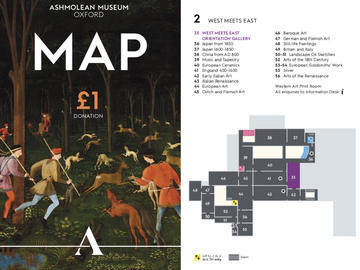
Oxford students might be familiar with the New Douce Room on the second floor, home to the Western Art print collection. It is accessible to the wider public by appointment, although access is largely limited to members of the University for teaching and research. Hundreds of students have classes in it every year and it is where Krasis takes place. But it is not on the map.
The foundation is thereby laid for a gradient between public and private where access becomes a function of the status of the individual. Despite the seeming objectivity of the map in the visitor’s guide, it becomes clear that this map does not suit all purposes. There is a visible and a hidden museum. As a result, a ‘personal mapping’ emerges, where space becomes highly subjective and the role of the visitor’s body can be interrogated.
Re-mapping space involves the abstraction of what is considered to be a ‘map’. So, we took maps and discovered how we might re-use them to make ‘maps’.
For visitors of limited mobility, the map becomes a tool for negotiating journeys between floors. For those with dyspraxia, a disability affecting coordination, mapping the Museum might involve navigating between places of ‘high’ and ‘low’ risk where one might be more or less likely to damage objects if one stumbles. For others, the Museum is almost like a ‘choose your own adventure’ book, which can be navigated by moving between only the objects one desires to see, or through the creation of a soundscape whose pitch and rhythm are based on the changing pace of movement and location of the visitor on different floors.

Krasis maps devised (l.-r.) for dyspraxic visitors; to plot access points; to compose music describing a museum visit
Not everyone makes it to the Museum, so how can we also communicate a space to those who have not seen it – can we take the Museum with us after we have left? This book-map provides one answer. By reusing the elements of conventional mapping and applying to them alternative techniques of describing space we engage in dialogues of inclusion and exclusion in museal spaces that ultimately get at one of the most important questions museums are asking themselves today: who is the museum for?
KRASIS 12
During Michaelmas term 2021, we explored the theme of Belonging from the perspectives of AJTFs working in English Literature, History, Assyriology, Museology, Italian and Musicology.
Week 1 was devised and led by AJTF Amy Lim, a historian and collaborative doctoral researcher working at Tate Britain and St Hilda's College, who uses art patronage to examine the relationship between the aristocracy and monarchy in late Stuart Britain.
Twitter: @amyplusthree
This blogpost is lifted directly from Krasis' own live Twitter feed.
Belonging to Me
Amy's session began by casting the whole group in the role of eighteenth century copyright thieves, attempting a sneaky copy of Hogarth on the basis of a very brief acquaintance.
We went on to consider all sorts of 'property' - intellectual, physical, theoretical, personal and institutional - in search of an answer to the fundamental question, "what belongs to me?"
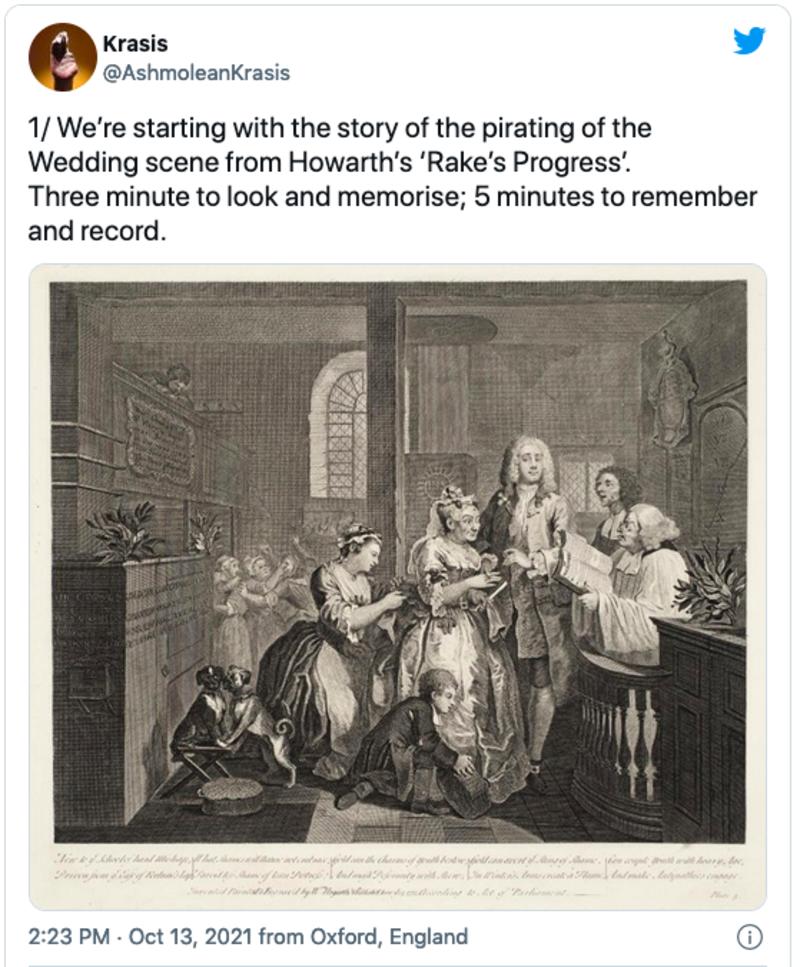
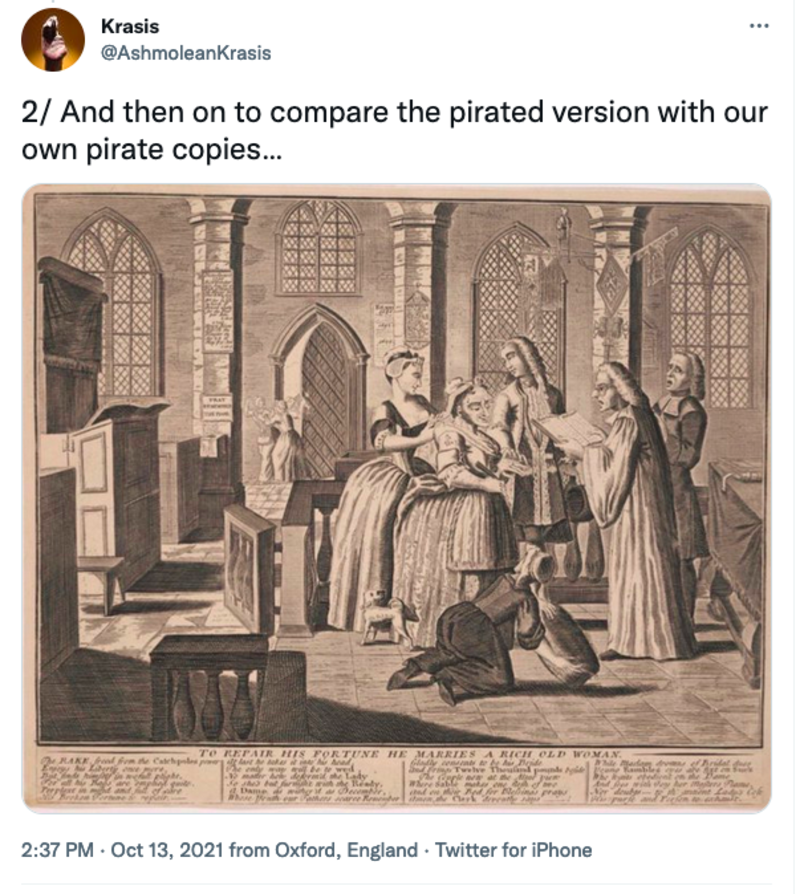
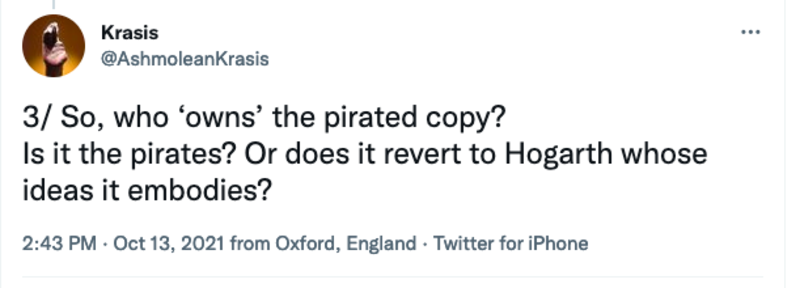
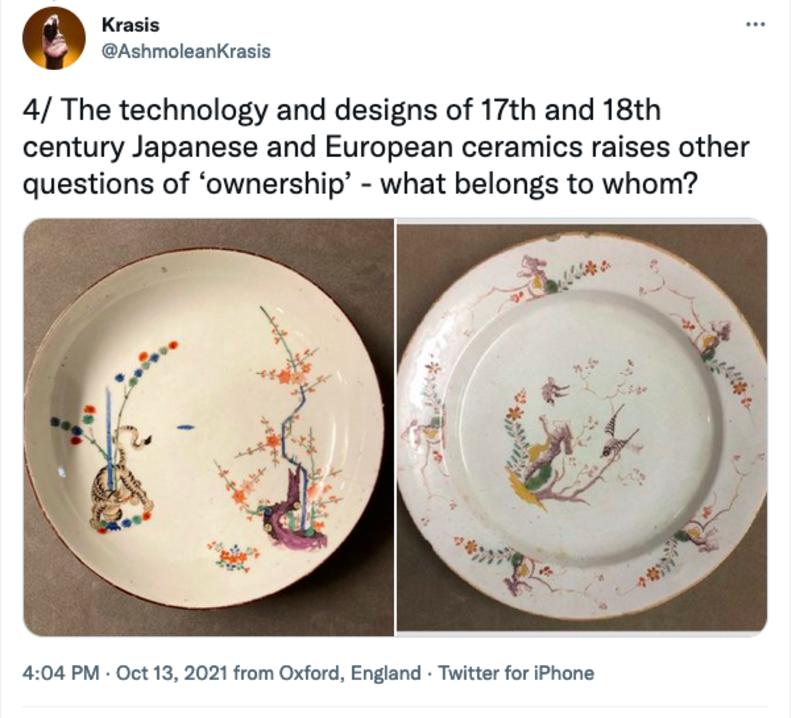
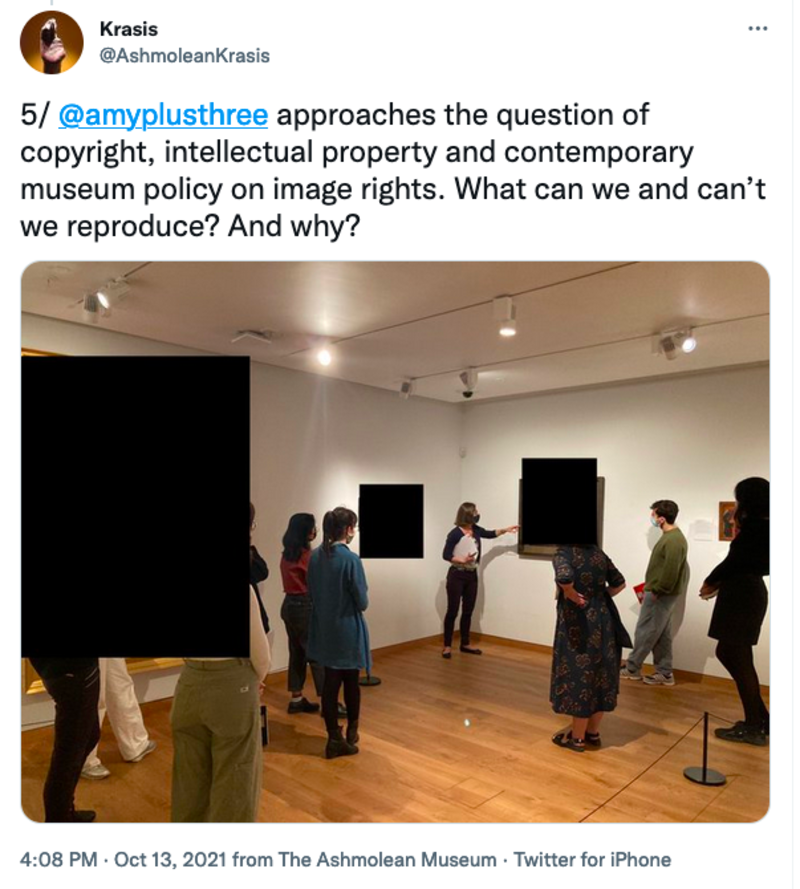
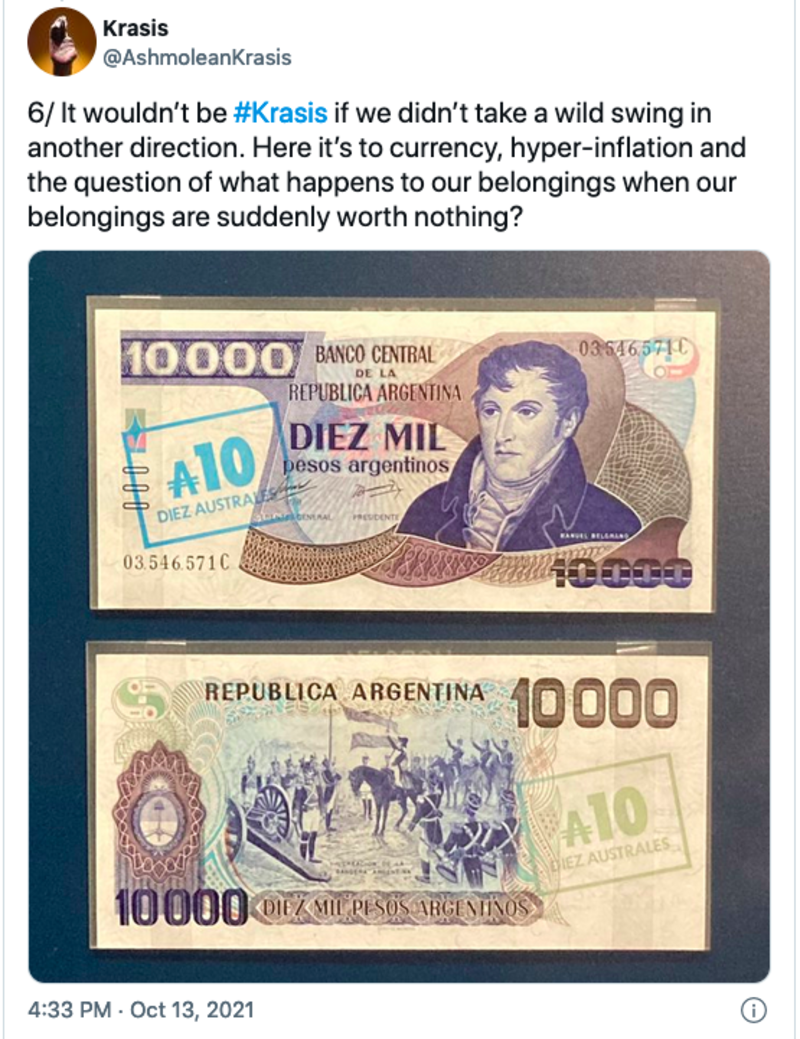
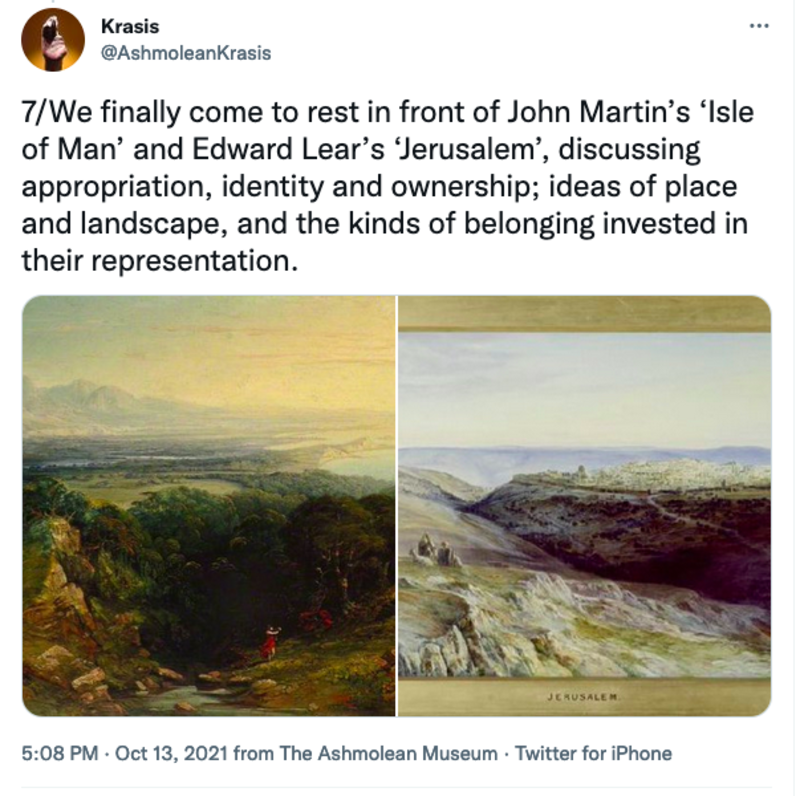
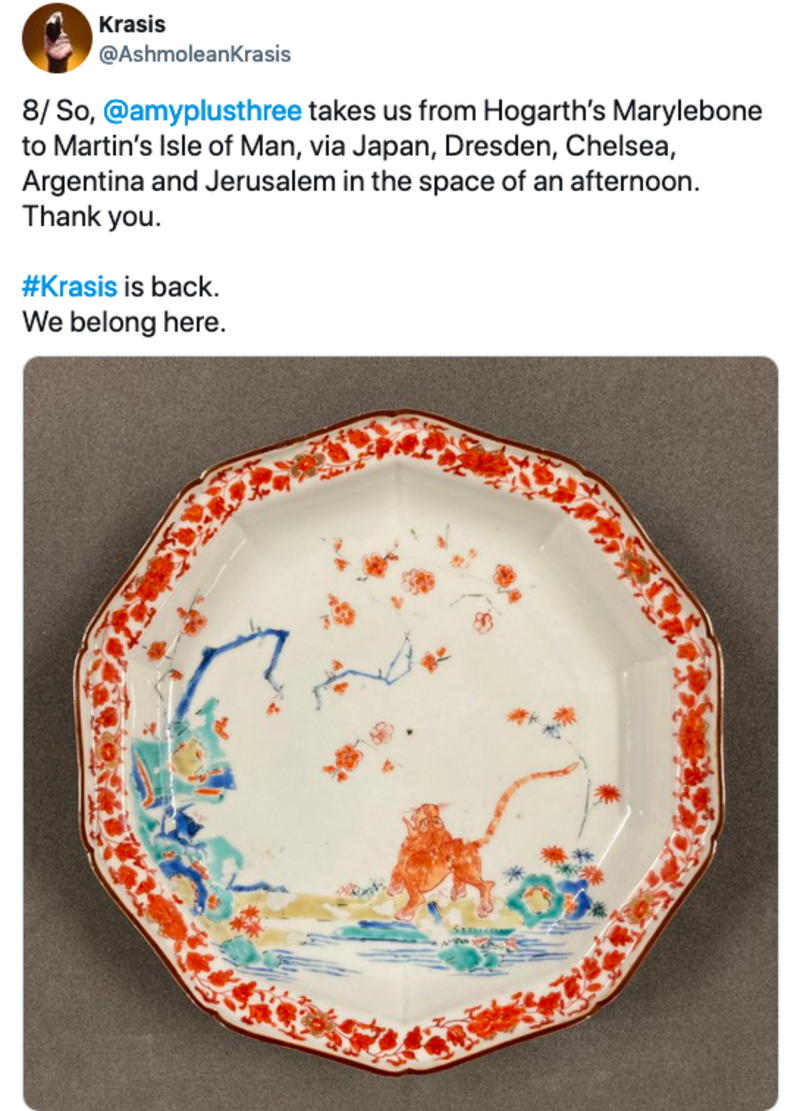
You can follow Krasis on Twitter at @AshmoleanKrasis
Week 2 was devised and led by AJTF Lily Crowther, a museologist and curator pursuing a collaborative DPhil at the V&A and Balliol College on the history and legacies of the Museum of Construction and Building Materials. Lily is also Curator at the Leamington Spa Art Gallery & Museum
Twitter: @lilCrowther
This post was written by Krasis Scholar Georgia Lin, who is undertaking an MSt in Womens, Gender and Sexuality Studies at Linacre College.
Belonging There
“Find the harpsichord.” Thus began the first of our even-week Krasis group’s orientations towards the collections housed at the Ashmolean Museum, one of the many objects we would encounter on our first Wednesday together. From clay bowls made in Staffordshire to stone from Headington, Junior Teaching Fellow Lily Crowther introduced us to the historical and contemporary peculiarities of working with materials.
First, we were instructed to bring an object with us whose materials speak to a particular place; offerings included a Yankees baseball cap, a pashmina scarf, and my item: a jade carving of a hei tiki, a traditional symbol of Māori peoples in Aotearoa New Zealand gifted to me by my former supervisor.
Our Krasis group includes students from multiple levels and areas of study, from undergraduates reading English to DPhil candidates in Music, all enthralled by the same questions, whether asked of the diverse things we brought from home or the contents of Museum around us: in what ways do its materials shape our interactions with an object? What was the significance of using certain materials, such as tropical woods, in household items purchased by English aristocrats? How can we make sense of our relationship with material objects housed in museums, removed from their original communities?
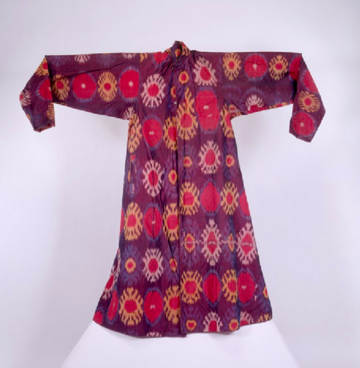
As part of the session, we explored the museum in groups to orient ourselves in new ways towards objects that included an 18th century English dresser and an Ikat coat housed in the textiles collection.
The physicality of wandering the museum galleries and observing tangible objects around us was a welcome and grateful change after the year of virtual rituals made necessary by the pandemic.
Throughout the discussion, we touched on topics from ecological extraction, colonial trade routes, the production lines of the Silk Road, to what I found to be the most fascinating part of the day: limestone. We took a field trip to St. John Street just off the side of the Ashmolean to investigate the building construction of Oxford. It was illuminating to consider the class connotations of brick versus limestone, and facade versus authenticity.
The imperfect business of crafting an upper-class image on St. John Street was evident in its bricked origins, raising questions of material reproduction we returned to once back inside the museum as we inspected objects in the ceramics gallery.
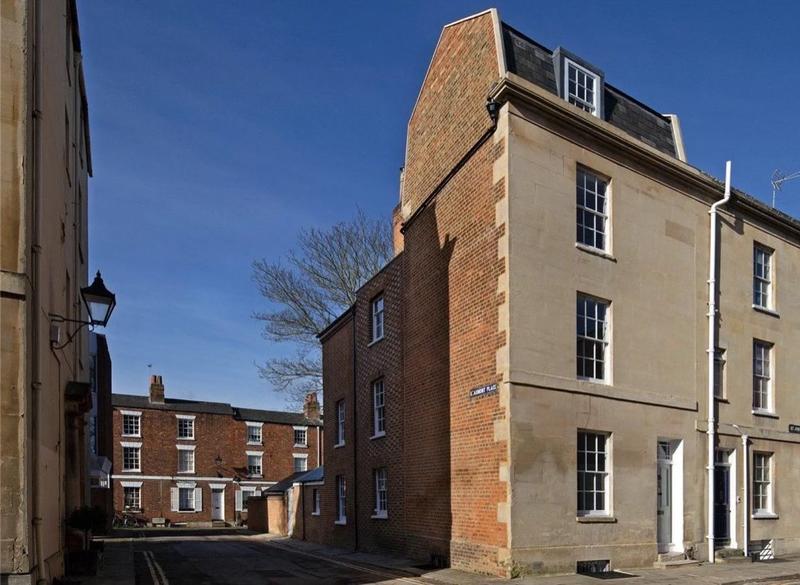
Later on, carefully holding neolithic greenstone axes in our gloved hands (after receiving instructions for handling such precious artefacts) made me question the significance of using a material like jade or jadeite, one with deep cultural roots and geographical associations, compared to Cumbrian greenstone.
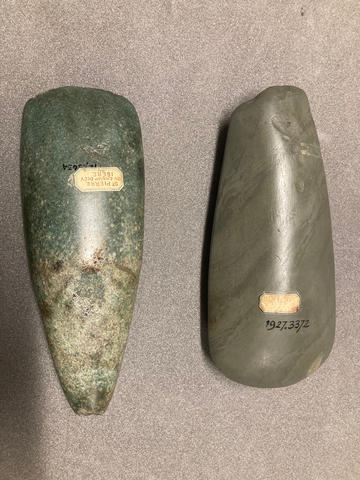
How can we employ colour and its provenance as a category of analysis? Furthermore, how should we make sense of an object when it’s no longer in the same place where we assume it should belong? These remain, of course, unanswered questions but I am hopeful that our future sessions will shed light on our evolving understanding of museums and their myriad meanings.
Our first Krasis session reminded me of the possibilities inherent in studying material culture, the depth of curiosity and insight that lies in something as simple as viewing a stoneware teapot, and the joy of soaking in all that museums - in all their flawed wonder - have to offer. I eagerly await the upcoming Wednesdays we will spend together at the Ashmolean learning with and from one another on this term’s Krasis theme of “belonging” to ourselves and our changing environments.
Week 3 was devised and led by AJTF Elena Porter, a historian and collaborative doctoral researcher at St Anne's College and Historic Houses. Her work focuses on post-war public policy as it affected privately owned built heritage.
Twitter: @elena_porter
This post was written by Krasis Scholar Alice Main, who is a second-year undergraduate in Classical Archaeology and Ancient History at Lincoln College.
Belonging Here
The main theme of Krasis week three was the question: what belongs here? The 'here' in question was, of course the Ashmolean and we were led by Elena Porter in exploring how museums display, interpret and retain objects.
The session began by dividing into small groups of AJTFs and Scholars to explore the European art galleries, figuring out the aesthetic and curatorial decisions that could have led to the paintings and objects being grouped together. We then returned to our larger group and had a lively discussion where we attempted to identify themes including: theology, ancient history, nationality and artistic technique. Nearly everyone thought about the ‘interior design’ of the rooms, in particular the juxtaposition between the opulent red walls and chandeliers of the seventeenth century gallery and the more neutral blue walls in the gallery of Dutch art.
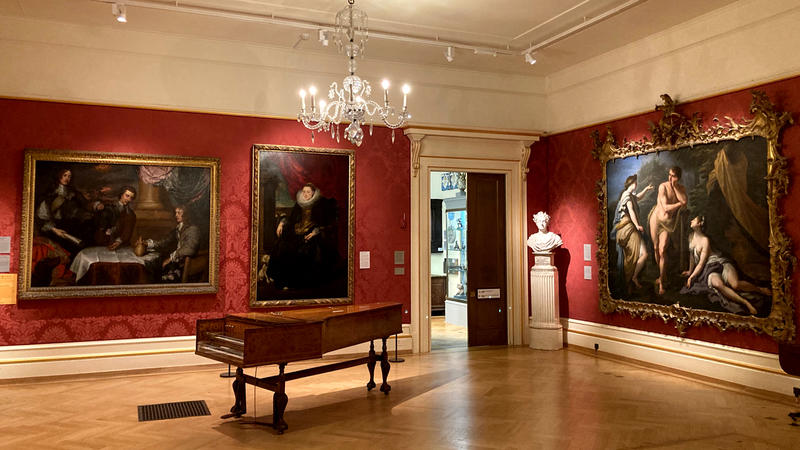
Juxtaposition became a key theme of the discussion, as we identified certain pieces that we felt did not belong in certain galleries and were curious about the decisions the curators must have made in order to hang these paintings next to each other. After much discussion we came to the idea that one of the reasons for these choices were the paintings are grouped by donation. In one sense, the jarring objects do belong together because they were collected by the same people and by displaying them together it keeps them in the context that the benefactor left them in. However, context is important for museums when interacting with the general public and we came to the agreement that perhaps more explanation of this grouping by donation might be helpful. Our discussion of curatorship led us into exploring the issue of objects belonging in museums or in alternative settings, such as stately homes.
Elena Porter began this exploration of stately homes with a whistle-stop tour of Anthony Eden’s Labour government’s policy to safeguard country houses. This led to the introduction of tax exemptions and grants for the owners to maintain the country house ensemble, in order to act as a time capsule which included the land, building and context of home (it could also be argued that this also preserves the owners, due to the revenue that private homes can acquire from running tours and weddings). It seemed very odd that a government that was focused on the redistribution of wealth via taxes would be actively fighting to preserve the country house, which we felt was synonymous with wealth and privilege, but this may be due to a longing for a rural idyll in a period of mass economic hardship that Britain faced as a consequence of the second world war. We also felt that the idea of the stately home as a ‘national’ resource was important, alongside the idea of ‘saving things for the nation’ (which we returned to after the tea break!) The 'stately home as idyll' led to a discussion of Penrhyn Castle, and the links the country house often has with the darker aspects of British history.
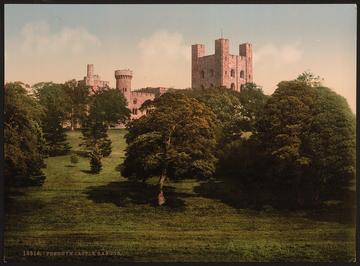
We felt it was important to address that these grandiose buildings were often built via proceeds of the slave trade and the exploitation of the local workforce, how this has shaped the communities around the houses and how we interact with these issues in the modern age. It can be argued that there is value to keep certain collections within the context of the stately home, because they can be shown to the general public in a way that explains more about the original collectors in the space the objects were purchased for. Whilst a museum is incredibly valuable in making the past more accessible, we felt that the stately home and its contents are also important spaces in providing context for larger object groups.
After the Krasis tea break, we returned to address the question of ‘national importance’, via the Waverley criteria. The Waverley criteria are designed to be used to assess whether certain objects should have stop placed on them when collectors or museums are attempting to take them overseas. The three central questions of the Waverley criteria are:
Is it so closely connected with our history and national life that its departure would be a misfortune?
Is it of outstanding aesthetic importance?
Is it of outstanding significance for the study of some particular branch of art, learning or history?
We were then set the challenge of researching and pitching the cases of three objects to the curator of Sculpture and Decorative Arts, Matthew Winterbottom in order to ‘save them for the nation’.
The objects we were given were a small, bronze hand by (or after) Auguste Rodin, a 15th century alabaster altarpiece of The Martyrdom of St Bartholomew, and a 17th century, Japanese Kakiemon porcelain dish.
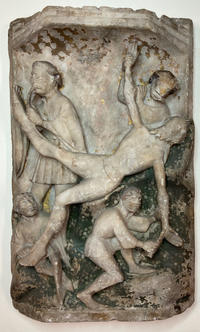
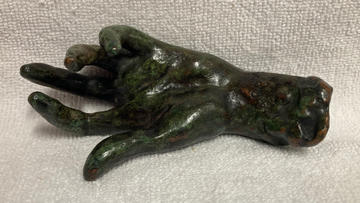
We were all struck by how difficult it is to make a strong case, due to the subjectivity of the questions. It was easier to find reasons for the objects not fulfilling them (which was definitely not the brief!). The idea of ‘national importance’ is incredibly emotionally charged, as two groups discovered with some disappointment that their objects would not meet the Waverley criteria and would have been allowed to be sold overseas.
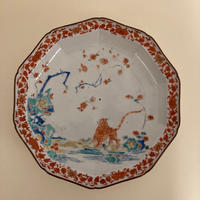
The alabaster altarpiece was ‘saved’ however, due to the committee deciding that more research needed to be conducted into its provenance. The global trade in antiquities adds further complexity to the idea of any objects ‘belonging’ to certain cultures or museums, if they can be bought and sold relatively easily (depending on the country in question). Elena left us with this question to ponder, and we walked out of the Ashmolean thinking about how the objects we passed came into the museum and whether they actually ‘belonged’ there. Krasis was (and is) thought provoking and I would recommend it to anyone who wants to challenge or feel challenged by cutting edge research.
Week 4 was sadly lost to illness.
We hope that there will be some output from the week nonetheless.
Watch this space.
Week 5 was devised and led by AJTF Felicity Brown, a literary historian and doctoral researcher in the English Faculty, at Jesus College. Her research explores the relationship between myth and history, performance and politics, and the conception and construction of periodisation, particularly of the “medieval” in early modern thought, through the lens of a mythical and historical King Arthur in the post-Reformation period.
Twitter: @felicityebrown
This post was written by Krasis Scholar Seren Atkinson, who is a second-year undergraduate in English at Christ Church.
Twitter: @seren_atkinson
Belonging in a Story
What belongs in a story? The fifth Krasis session of the term, led by Felicity Brown, began by asking this question, for the first time of the entire cohort of Scholars and Teaching Fellows. Bringing her literary-critical research to bear, Felicity encouraged us to begin thinking about the ways in which we could imagine ‘belonging’ in a story, a continual process of shaping, reshaping, and revision. As an English Literature student myself, it was a further thrill to discover that the narrative framework for the session was that of Arthurian legend. Underpinning our thinking for the following three hours, therefore, was not only the potential for stories to engender a sense of belonging for an object or viewer, but also the possibility that objects might create their own stories. And, as we were to find out soon, these narratives might operate as fully within the confines of a small, illustrated piece of paper as through an entire gallery. What better way to chase away fifth week blues?
We started work in the New Douce Room, where we were greeted with seven works on paper laid out on the table, as well as a larger, framed watercolour on an easel alongside. Having visited the Ashmolean earlier in the year for the Pre-Raphaelite exhibition, I was over the moon to see a couple of familiar works (in particular Edward Burne-Jones’s The Knight’s Farewell, which has since become my laptop screen-saver).
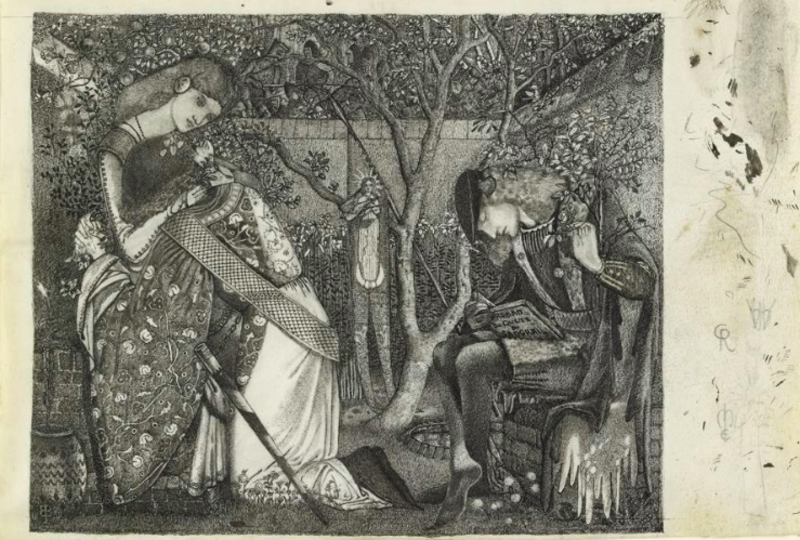
The images were diverse in scale, medium and subject – ranging from knights on horseback, to pining women, to expansive panoramas. Arming each of us with a short quotation, Felicity tasked us with choosing an image that we thought corresponded most closely to each snippet of text: an extract from an Arthurian poem, a piece of criticism or even simply a word cloud. Junior Teaching Fellow Talah Anderson and I were given this, from Thomas Malory's Le Morte d'Arthur of 1485.
Than, as the booke seyth, Sir Launcelot began to resorte unto Quene Gwenyvere agayne, and forgate the promise and the perfeccion that he made in the queste; for, as the booke seyth, had nat Sir Launcelot bene in his prevy thoughtes and in hys myndis so sette inwardly to the quene as he was in semynge outwarde to God, there had no knight passed hym in the queste of the Sankgreall.
To partner our text, we were torn between Burne-Jones’s The Knight’s Farewell (above) and Rossetti’s Sir Lancelot's Vision of the Sanc Grael, one of the studies for the frescoes of the Oxford Union (below).
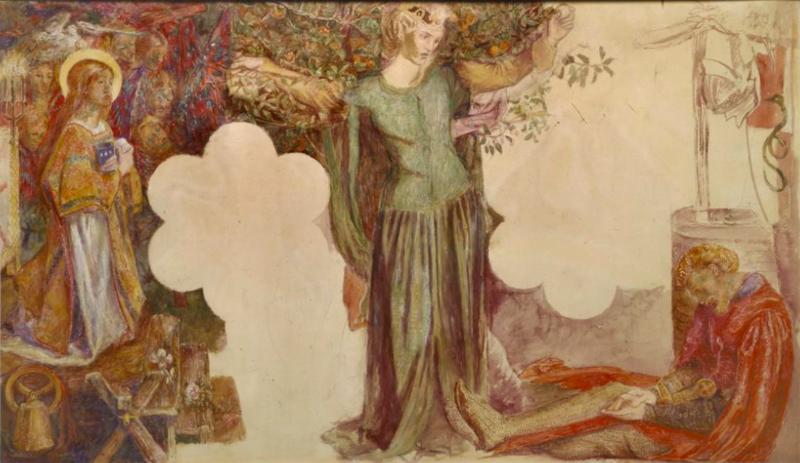
We could see the looming shadow of the omnipotent “booke” physically represented in both the foreground and background of Burne-Jones’s drawing. And in Rossetti’s, we could also see Gwenyvere’s alluring presence causing Launcelot to “forgate the promise and the perfeccion that he made in the queste”. Felicity then asked us to pick a theme deriving from our quotation and choose three images from the eight that we might display together in an imaginary exhibition.
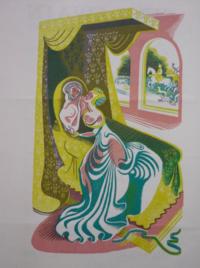
In addition to The Knight’s Farewell, Talah and I selected Dorothea Paul Braby’s Sir Gawain and the Lady and John Everett Millais’ A Lady at the Tournament, to examine ideas of female agency, and how narrative can be conveyed in a single still. In each of our images, the private is brought close, occupying the foreground, while the public world of duty and conflict sits uncomfortably in the background. As a result, we began to see the essential contrast between domestic/interior and public/exterior that would come to characterise many of the different narratives and conceptions of ‘belonging’ both in literature and objects – and in the Ashmolean’s galleries.
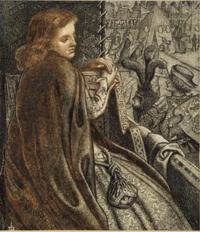
After a short tea break (always well-received), we continued our discussions in the Pre-Raphaelite gallery where Felicity once again provided us with texts, tasking us with finding corresponding images. Afterwards, we set out to choose other objects that we felt embodied the themes that had run throughout the session. Our questions this time included: what has the artist left out? which parts of the narrative have they chosen to depict, and how does this influence our reception of the artwork-as-narrative versus text-as-narrative?
The standout image for me was Ford Madox Brown’s ‘The Seeds and Fruits of English Poetry’, in which Chaucer is shown reading aloud to the court of Edward III, accompanied by other central figures of the so-called English canon, such as Shelley, Milton, and Shakespeare. At first glance, I was drawn to the painting’s organising principle, a tripartite structure mirroring religious triptychs, as well as its focus on oral reading practices, as both spoke to some of my own research interests. However, some of the ideas Felicity had helped us explore in the first half of the session began to illuminate more complex powers at work in the painting.
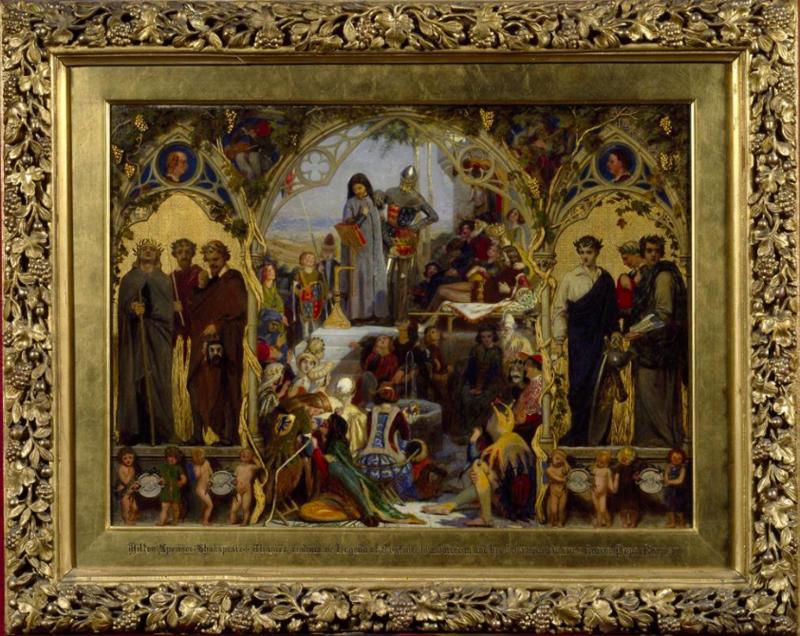
Unlike the other images in the gallery (or those we had encountered earlier), we are faced by authors and not their mythical or historical subjects. This invites us to question not only the figures of authority in the painting but the museum itself since, as we scrutinise Ford Madox Brown’s construction of national identity, his painting’s presence in the gallery to some degree affirms its contents. Even under a critical eye, the painting seeks to determine who belongs to the literary canon and how that might be a determinant of our own socio-historical identities: our own structures of belonging and exclusion.
Working alongside students and Junior Teaching Fellows from other subjects has provided throughout this session (and indeed the Krasis programme as a whole) new insights into (and provocative discussions of) the narratives offered up by museums and their collections. As our final discussion turned from the specifics of the images we had considered over the afternoon to the function/assumed authority of museums in creating – or burying – national identities, we finished with one final meditation: asking not only what belongs in a story, but how does a story make something belong?
Week 6 was devised and led by AJTF Dr Tom Metcalf, a composer and musicologist, and a postdoctoral researcher at Worcester College. His work considers ekphrasis and transmediality, and specifically the transformation of graphical spaces into determinately–notated music.
Twitter: @tmkmetcalf
This post was written by Krasis Scholar Cecily Fasham, who is reading for an MSt in 20th Century English Literature at Keble College.
Belonging Together
Coming to write this blog-post, I realized I didn’t know how to approach it. How do you distil an experience into text, draw out the kernel of a discussion, crystallise a sprawling afternoon into a few pertinent paragraphs outlining the ‘key take-aways’? How, in short, could I translate week 6’s Krasis session into a blog-post? And, was that even what I was supposed to be doing? I don’t think I’ve found answers to these questions, but it strikes me as important to raise them because the subject matter of this week’s Krasis was all about these kinds of enquiries, interrogating issues of framing, presentation, titling, curation, and – practically – the issue of turning the data of experience and sense (sight, touch, thought) into words (or music, or any other medium).
And how to do this without describing: I’m wary of my blog-post becoming a ‘we did this, we did that’ sort of list, because to do so would I feel strip the krasis session of its energy, its vitality, all the things that made it useful and pleasurable. That’s where we began our session, trying to avoid description while playing with inscription. We went out into the galleries cold, without much prior warning, to find some objects and write ekphrastic poetry about them. The one instruction we were given was not just to depict or describe the artefacts, but to think more expansively about how to pay attention, in text, to the object’s form, its resonances, its energy, not just the fact that it’s a pot.
Although the truth is, most of the things that we looked at were pots.
So, I went with Tom Metcalf, who led the session, to look at a broken Roman vase, carefully reconstituted from fragments placed on metal supports, recreating its shape though only half-reconstructed, like an unfinished jigsaw puzzle. Through the gaps, other parts of the display were visible, including a photograph of a conservator painstakingly putting together the jagged pieces of pottery. For ten minutes, Tom and I worked on our own, writing our responses to the object.
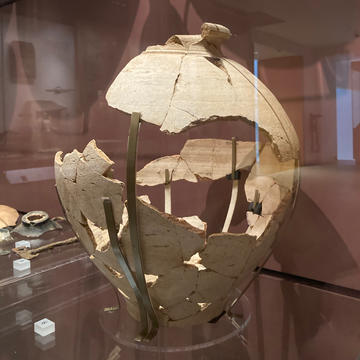
I say ‘on our own’, but in fact the gallery was very busy; a large group of local year sevens were visiting for a class project, and the room was filled with overexcited eleven-year-olds, darting from case to case with enthusiastic cries of ‘look!’ and ‘wait for me!’
When our ten minutes were up, we adjourned to a more peaceful spot to talk through what we’d written. Tom had created what I, following Apollinaire, would describe as a calligramme, which is to say, a concrete poem. Words related to the object (however obliquely) were linked together by multidirectional arrows to form a poem that, on the page, recreated the shape of the vase.
Like Tom, I was struck by the fractured nature of the pot, which engendered a desire to play with the shape of the poem, to mess around with mise-en-page in such a way that would let white space commingle with the text of the poem, reflecting the brokenness that seemed to be the most pressing feature of the object – but my poem turned out quite differently to Tom’s, becoming a loosely coherent scattering of small stanzas across a page of my notebook, with quotes from the children dotted around in the gaps, all drawn together at the foot of the page by the teacher’s call to the children to ‘gather round’, which struck me as emblematic of the efforts of both the conservators who had worked on the vase, and ourselves, trying to write ekphrastic poetry.
While Tom’s theories of transmedialisation are focused on music, my own work in English literature often draws from theories of experimental translation, and this particular instance reminded me of the ideas of Clive Scott, particularly his theories of ‘constructivist’ and ‘survival’ translation. Scott’s idea is that translation should strive to remediate the text, to give its body a new form. Translation in this sense is about trying to ‘capture [a text’s] changing states, and to project it forward’, ‘giving [it] new options of being.’[1] Writing ekphrastically about the vase was about trying to capture the way it had shifted and changed over time, pulling it forward into a new medium, into the present day surrounded by children, and incorporating all these overlapping forms and temporalities into the poem.
Other poems about other objects, read when we drew back together as a group, focused on the warmth of a kitchen tureen, the imagined touch that had worn-away its decoration, or thought about sedimented history the layered varnish of objects that had undergone restoration. The session temporarily turned into a poetry workshop and I felt quite at home as scholars and fellows alike read aloud from their writing. It was moving, and beautiful, and very intimate. I was reminded of one of the things I’m grateful to Krasis for, which is creating a space for trust and real conversation, which is difficult to find in the hypercompetitive settings of Oxford academic life.
Enough intimacy, though. We were next treated to some hard theory around the concept of transmedialisation, listening to music based on graphic scores and looking at the scores themselves. Rather than employing conventional musical notation, they resembled architectural drawings, elegant curves to represent a glissando, miniature cityscapes in outline, all unreasonably perfect.
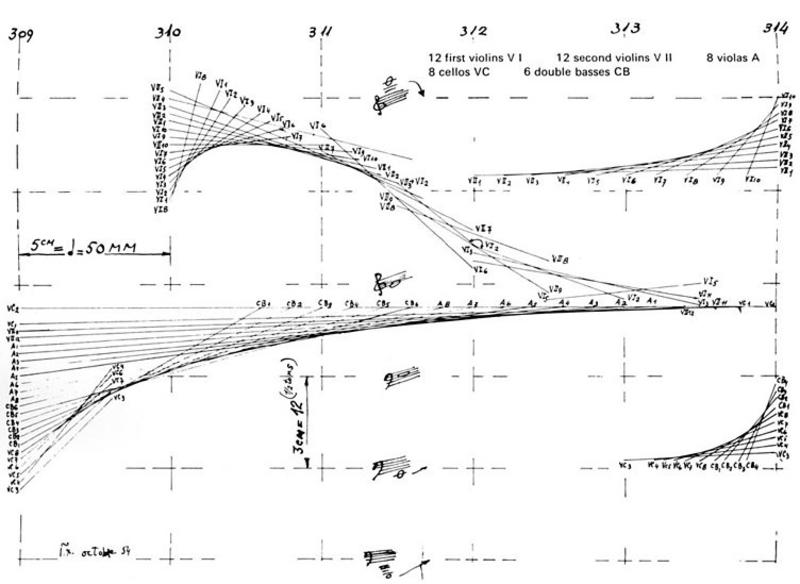
Iannis Xenakis’ score for Metastasis doubled as an architectural sketch for the Philips Pavilion, the music recreating the sound of Le Corbusier’s Philips Pavilion being built at the 1958 World’s Fair, complete with loud beats that were variously interpreted as a hammer during construction, or water dripping through the empty concrete shell of a half-built structure.
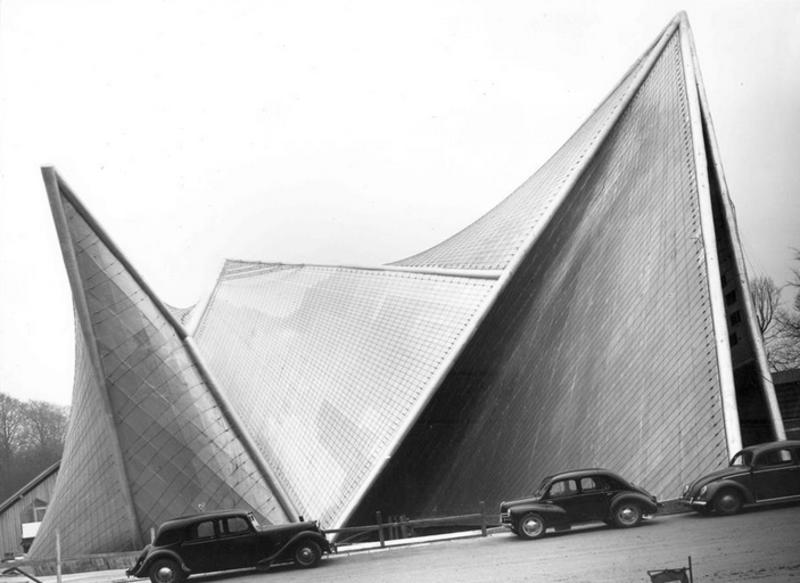
We were also lucky enough to see some of Tom’s own work, titled Dissolution, in which he used an image of the serpentine coil of the Thames as a basis for music, which slowly compressed and dissolved as he pixelated the picture, until everything came to a crashing halt.
After a well-earned tea break, where conversation (at my end of the table) covered curating exhibitions, and how music and other media might – or might not – come to an end, we returned to consider framing and titling. How might a title mislead? And how do frames affect the way we perceive objects? How is Mendelssohn’s ‘Scottish Symphony’ ‘Scottish’? Spoiler: not at all, really, but the title has long dictated the way the music has been heard and interpreted.
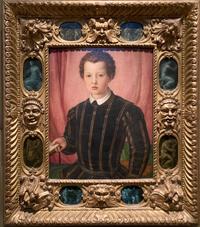
We returned to the museum galleries to look at frames: the standardised frame for a small Japanese woodblock print, which left space bordering the image, flattening the effect of the busy scene it depicted; Bronzino’s Portrait of Giovanni de’ Medici, an 8-year old boy coupled incongruously with an incredibly ornate frame depicting ‘people in various states of undress’;
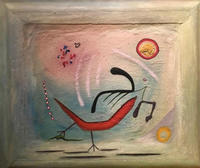
Desmond Morris’s The Dove plastered and painted over its frame, the artwork consuming and subsuming the frame, defying constraint.
As with objects and poetry, sound and graphic image, and every other question of ekphrasis and transmediality, the question we were asking was: do these things belong together?
And consistently we answered yes.
And no.
Links:
https://thomasmkmetcalf.com/research - links to all Tom’s research, including ‘Graphical Ekphrasis: Translating Graphical Spaces into Music’
https://thomasmkmetcalf.com/dissolution - Dissolution (audio and score)
[1] Clive Scott, Literary Translation and the Rediscovery of Reading (Cambridge: Cambridge University Press, 2012), p. 101 – 102.
Week 7 was devised and led by AJTF Talah Anderson, a DPhil researcher in Assyriology and Neo-Assyrian Studies, working on kingship, divinity and antiquarianism in the visual representations and texts of Sargonid Mesopotamia.
This blogpost was written by Nia Moseley Roberts, who is reading for the MSt degree in Medieval English at Jesus College.
Unbelonging
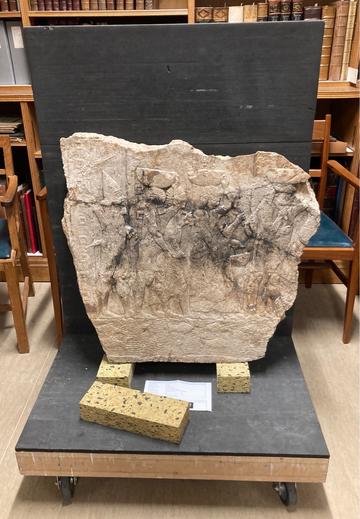
Before Talah’s session had even begun, we were faced by a mystery. Throughout term, in hushed tones, Talah and Jim had been discussing the possibility of bringing an object of immense size, the largest ever known to Krasis, up to the New Douce Room. So when we arrived, we finally got to see what it was: a 170kg fragment of a limestone relief from the palace of Sennacherib, carved in Assyria nearly 3000 years ago.
In many ways, this object encapsulated the major themes of Talah’s Unbelonging session. It speaks to Talah’s academic research in constructions of ancient Assyrian kingship. Here is Neo-Assyrian imperial ideology writ (or, in this case, carved) large. But in its content and present form, its status as a highly local and static object is complicated and worried.
The relief depicts captive Babylonians being driven to Assyria, uprooted from their homeland and relocated as part of the imperial project of a foreign power. The dislocation of the Babylonians is echoed in the frieze’s present form; it is now only a fragment, its rough and jagged edges betraying the touch of Western archaeologists, who in the early 20th century removed this and many other objects from ancient, near-eastern sites for sale and display in the West. This relief is an object awash with layers of memory, speaking to us not only from the ancient past but also from our all too immediate colonial history. Its multivalency is a reminder of the power of objects to record that which has been done to them, and thus of the value of the object-centred teaching Krasis aims to provide.
So where do this object and others like it belong? This was the central question of the session, which both examined and deconstructed theoretical conceptions of belonging and addressed the practical questions of belonging and repatriation so central to the working of museums today.
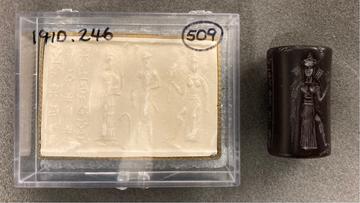
After the Sennacherib relief, we examined a series of objects, all associated with the goddess Ishtar. Her presence was carved onto cylinder seals, then rolled into wax or clay to leave a distinctive impression.
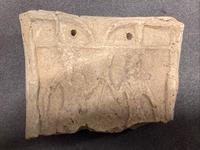
Her image was found on terracotta models of chariots, and her hands were moulded as bricks, incorporated into the Palace of Nimrud in order to bless it. The range of her representation illustrated both her importance to the communities who worshipped her and the breadth of her power.
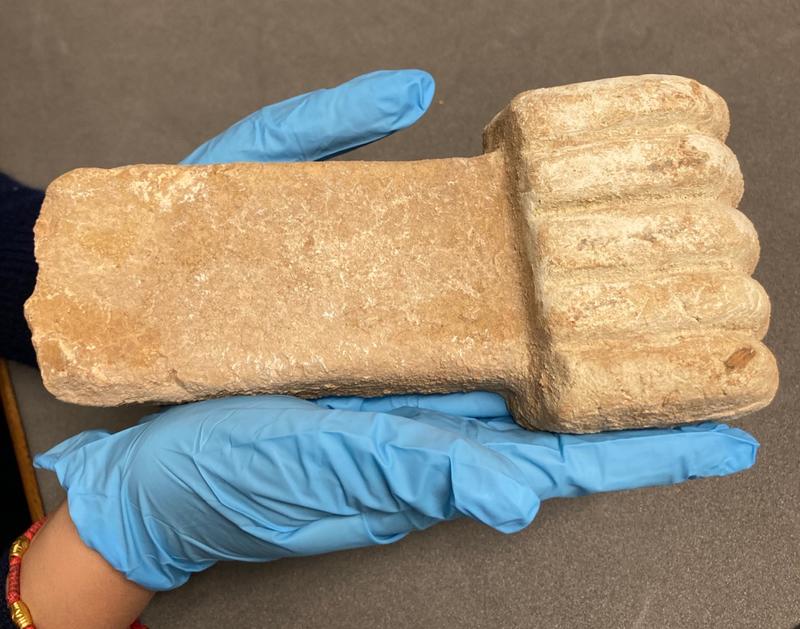
We then turned towards how these powers and abilities were acquired: by theft. To explore the source of the goddess’ attributes and powers, her ‘belongings’, Talah introduced us to a myth concerning Ishtar’s Sumerian predecessor, Inanna. The Sumerian text Inanna and Enki tells the story of how Inanna stole the sacred mes, a wide ranges of abilities, ideas and skills central to civilisation, from the god Enki.
We read passages where Inanna proclaims all the things she has gained, from ‘rejoicing’ to ‘the plunder of distant lands’. Our job was to rewrite the passage with reference to the museum, using Inanna’s capture of civilisation from Enki as a lens through which to consider the institution in which we were sitting, both in terms of its material belongings and its cultural reputation.
It was harder than first appeared, primarily because the term ‘museum’ itslef is complex: did we mean the museum as it was or as it is? As it likes to think of itself or as it is perceived from the outside? We broke for the tea with a healthy awareness of the museum as a contested space, representing very different things to different people.
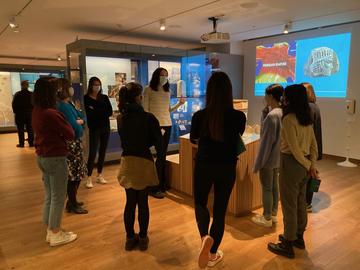
The final activity of the session was my favourite. Building on our earlier discussion of the museum, we were set the task of devising a display around a single object, deciding where it should belong. This took us to the Ashmolean's new Ancient Middle East gallery to pick our objects, where were faced with hundreds of objects with deeply problematic and complex histories. There was the Gilgamesh tablet, recording one of the first known works of literature; a sandstone head, cleaved from its body; a relief, smashed and defaced, this time not by western archaeologists but by the efforts of so-called Islamic State.
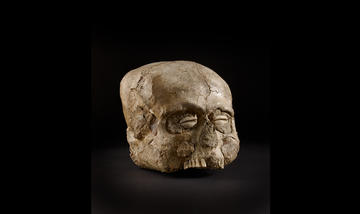
Faced with such an amazing array of objects, and distracted by the insights offered by the new displays, my group failed to stick to the brief. We chose two objects instead of one: a beautifully carved stone head given to British doctors involved in the smallpox inoculation campaign; and a decorated human skull from Jericho, so old that we cannot understand its full significance or even the civilisation which made it.
Superficially linked through the the theme of ‘heads’ both objects to us challenged conceptions of belonging, and complicated attempts we might make to repatriate them. One was a gift, forcing consideration of the extent to which ancient artefacts can be owned and given by individuals, the other so ancient that the question of where, or more properly to whom it might be repatriated to was all but unanswerable.
Other groups focused more intently on the act of repatriation, designing exhibitions in which the key objects were not present, having been transferred out the museum and back to their place of origin. This led to the session ending with a focus on absence, and a repeated questioning of the purpose and function of the institution in which we sat. As minds and museum policies turn towards the importance of repatriating objects to the places and peoples to which they unarguably belong, Western museums such as the Ashmolean are going to have to learn how to present absence: how do we frame an image which is no longer there.

KRASIS 11
During Trinity term 2021, we explored the theme of Becoming from the perspectives of AJTFs working in Archaeological Science, Art History, Assyriology, Conservation Science, English Literature, History, Museology and Musicology.
The constraints of illness and examinations left some Summer weeks unblogged, and for these weeks we have given the abstracts written by the AJTFs for their respective sessions. These posts will be filled by mining the Krasis live Twitter feed: @AshmoleanKrasis
Week 1 was devised and led by AJTF and former Krasis Scholar Dylan Price, a DPhil researcher in music at Worcester College, informed by his work in music theory, political geography and the visual and aural landscapes of 19th century nationalism.
Becoming a Hero
This blog post starts where we finished, with a text produced by one of the scholars’ breakout groups thinking about ‘heroism’ as expressed in objects from the collections of the Ashmolean Museum. This blog hopes to show how these became our finale.
The texts we wrote were focused on three objects that each spoke in different ways to the idea of heroism as an expression of colonial identity. One arose from the ‘sentence game’ whereby each member of the group wrote a sentence following on from the last. This process produced a written piece narrated from the perspective of a Kashmir sock giving voice to the sock, not its owner, Warren Hastings, a key figure in Britain’s colonial exploitation of India. An engraved gypsum relief of winged genius with a standard inscription of Ashur-nasir-pal II extracted and exported from the Northwest Palace at Nimrud by one of the key colonial archaeologists of the 19th century, Austen Henry Layard, produced the second.
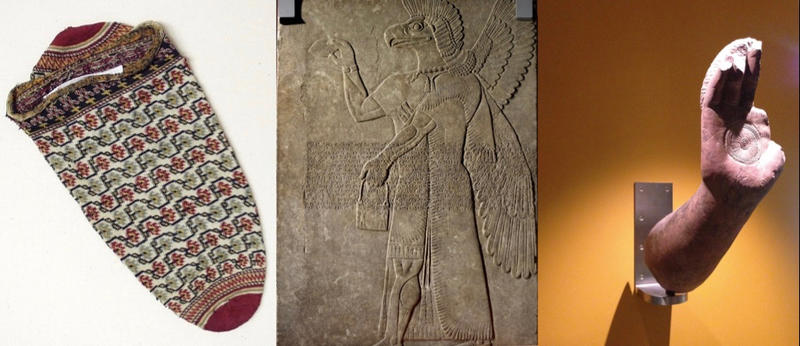
The final text responded to a fragmentary hand and forearm from a Mathuran sandstone standing Buddha of the Kushan period. Its provenance is to the collection James and Marilyn Alsdorf of Chicago, in the 1970s, though its history after being removed from a site near Mathura in the 19th century is somewhat sketchy. After sensing an immediate connection with Shelley’s Ozymandias, the group reworked the short poem to capture something of the power, heroism (and melancholy) of the Mathuran Buddha.
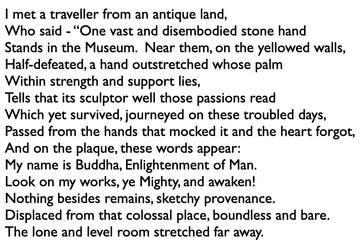
Tying these three collection items together was the relation between heroism and colonialism. As Dylan led us to realise, a heroic narrative often underpins that of colonialism. Common understandings of heroism are founded on the idea of overcoming a difficultly, a challenge or an ‘other’. Colonialism’s common ‘us’ and ‘other’ foundations are, therefore, mirrored in the stories of ‘heroes’, whereby both nation and individual overcome the ‘other’ to establish, ownership and control. In this correlation, the reimagining of museum objects in our literary exercise was a practice in decoupling, examining or challenging the implicit heroism that is silently presented in objects acquired through colonialism.
To demonstrate the process of becoming a hero through overcoming a difficultly or difference, we had earlier turned to Dylan’s own discipline, music. After listening to Antonín Dvorák’s Hero's Song his last symphonic poem, and Beethoven’s Ode to Joy we saw their contrasting fundamental structures and patterns distilled in the Ursatz of Schenkerian analysis.
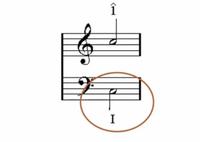
While the former (right) constitutes one strong note, continuous throughout, the latter (below) moves upwards, before returning. In Beethoven’s work, this audible struggle before finding familiar ground again encapsulates the notion of becoming a hero: the sound of freedom, the sense of success, a form of heroism in which the process of overcoming is vital.
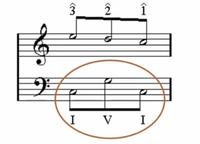
In Dvorák’s simpler Hero’s Song, however, Dylan demonstrated that there is also a form of heroism in the 19th century consciousness that is steady, strong and innate.
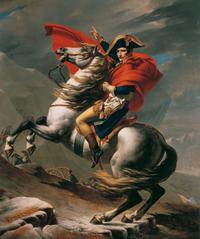
This distinction, between an innate or divinely present form of heroism and the process of becoming a hero had become clear visually in the first part of the session. David’s Napoleon on the Great St Bernard is a perfect, self-fashioned image: the isolated figure, supposedly caught in the heroic moment. Not only did Napoleon commission the work himself but he did so to place himself among a hall of fame of ‘greats’ such as Charlemagne. An image of steely reserve commanding both his men and his wild-eyed horse, he is overcoming the odds to press his campaign forward over the Alps. In contrast, Alphonse Mucha’s early 20th-century The Slav Epic and Viktor Vasnetsov’s Bogatyrs of 1898 (below) offer up an image of a more innate, God-given, national heroism.
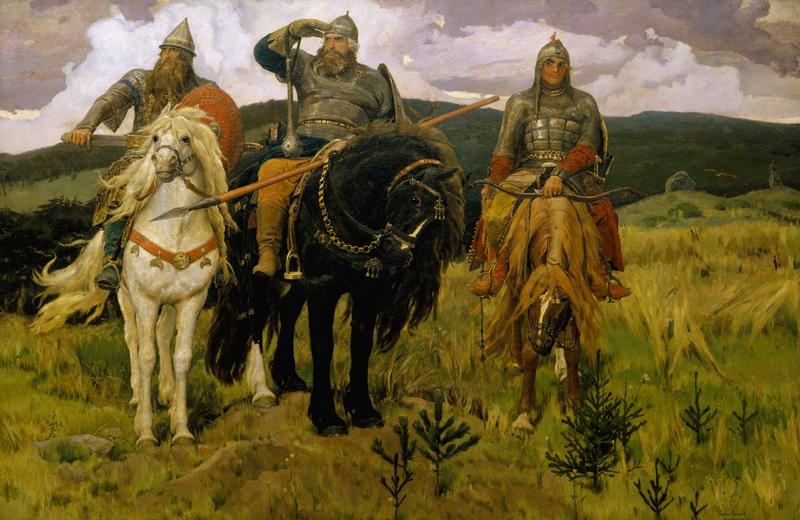
The assumption of heroism as an innate characteristic brings us full circle to consider the presentation of the ‘heroic’ in museums and its relationship with colonialism. Over time, we have allowed the ‘heroism’ of colonisers and collectors to pass as an an assumed, legitimised and approved fact. Now, we should recognise and draw attention to our collections’ foundations and the concomitant manufacture of heroic narratives for the collectors we have celebrated. In understanding their processes of becoming we can begin to reconstitute and reimagine the forces they represent, decoupling them from the heroic, questioning them just as we aimed to do in our literary responses to the three colonial objects from the Ashmolean.
This post was written by Krasis Scholar Sarah Jackman, who is reading for an MSt in the History of Art at Christ Church College.
Week 2 was devised and led by AJTF Talah Anderson, a DPhil researcher in Assyriology and Neo-Assyrian Studies, working on kingship, divinity and antiquarianism in the visual representations and texts of Sargonid Mesopotamia.
Becoming an Empire
“Ashur is king – indeed Ashur is king!”
So opens the passage of King Ashurbanipal’s coronation hymn given to Krasis scholars to read by Assyriologist Talah Anderson. Etched in cuneiform on immortalising clay, these lines of the hymn represent a Neo-Assyrian imperial propaganda which proclaimed the supremacy of its head deity in the Assyrian pantheon over conquered peoples and by extension, the divine right of its King Ashurbanipal (literally, “Ashur has given a son-heir”) to rule over them accordingly, granting hegemony to his power-wielding sceptre. The entire multitude of the Neo-Assyrian empire is channelled through the relationship of two individuals, god and king as rulers of their respective pantheons, and an object of limitless reach “to extend the land”.
What symbolises an empire? This question lay at the crux of our discussions. As we ascertained over course of the session, an empire’s conception of self is fashioned through subjugation (of the enemy) and construction (of physical systems of canals and gateways, of opulence, of homage to previous eras and empires). Nowhere is this duality of empire, of destruction and creation, better exemplified in Assyrian material culture than the BM124920 relief from the North Palace of Ashurbanipal at Nineveh.
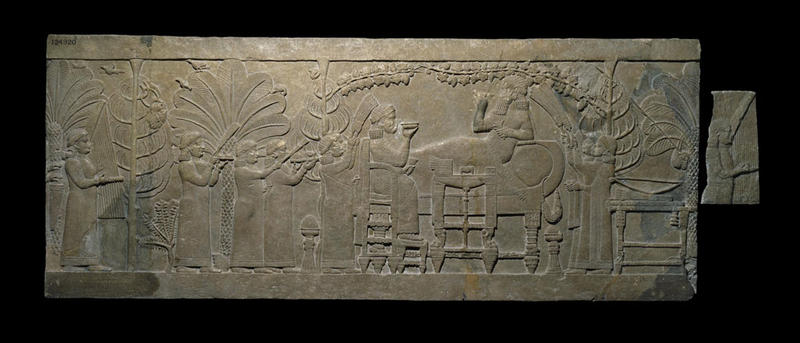
The so called the Garden Party scene features Ashurbanipal drinking and reclining amidst lavish flora and fauna, accompanied by his enthroned wife and harp-playing attendants. Hanging in one of the trees, however, is the head of Teumann, the defeated king of the enemy peoples the Elamites, and on the table behind the peacefully reclining Ashurbanipal lies his bow, the symbol of the war-goddess Ishtar. There is luxury and splendour to be derived from the fruits of empire, to be sure, but its primary impetus derives from brute military force and disempowerment of the enemy, thereafter absorbed into imperial imagery in a show of dominance and threat for the future.
At once divinely sanctioned and sustained (in the words of his coronation hymn, “the great gods make firm [Ashurbanipal’s] reign”), the King is simultaneously a figure who needs to be grounded, to be seen as participating in his empire amongst his people in spite of, or perhaps exactly owing to, a near divine posturing. A stone stela commemorating Ashurbanipal’s refurbishment of the Marduk temple in Babylon has him holding a basket of earth above his head, an age-old symbol of the king as a divinely guided builder, as his hat and hands point towards the sky.
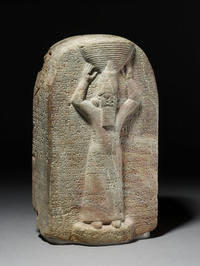
Encouraged by Talah, we found pertinent links to a copper figurine of King Shulgi, a member of the Third dynasty of Ur, similarly positioned in a building stance, but differently configured in its aims as an object.
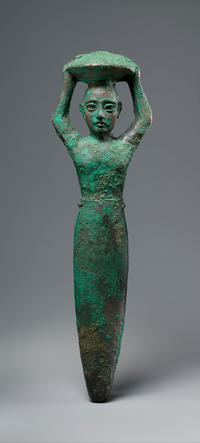
Thought to have been discovered by Ashurbanipal during his own excavations in Babylonia, Shulgi’s figurine was buried deep in the ground, an act of humility and devotional reverence which Ashurbanipal took from his supposed Neo-Sumerian (and therefore, very distant) ancestor and appropriated to give his own great power a humble veneer.
But empire is a wholly unnerving concept, we Scholars determined; one which requires a Defeated in order to define a grand Victorious, and one which finds brusque reiterations in modern memory. Looking at the lamassu, the Assyrian intermediary protective deities often stationed as statues at major palace entrances like that of Sargon II at Khorsabad, Talah drew our attention to their appropriation as plaster casts in the imperial pomp of London’s 19th cent. Crystal Palace – one empire’s remnants feeding the imaginations of another.
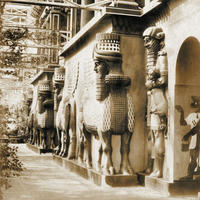
The Crystal Palace appropriation struck me as a very different European configuration of the ‘Oriental’ to works of art like Delacroix’s Death of Sardanapalus, where the chaos and sheer sexual deviancy puts the depicted Assyrian king at odds with the (then celebrated) neoclassical conventions as found in paintings like David's Oath of the Horatii.
The lamassu remains a potent symbol today. Those who have visited London’s Trafalgar Square recently may recall a colourful example on the Fourth Plinth in 2018-19. Made of 10,000 Iraqi date-syrup cans, this construction of the winged bull was meant to represent one which stood at the Nergal Gate of Nineveh, destroyed by ISIS in 2015.
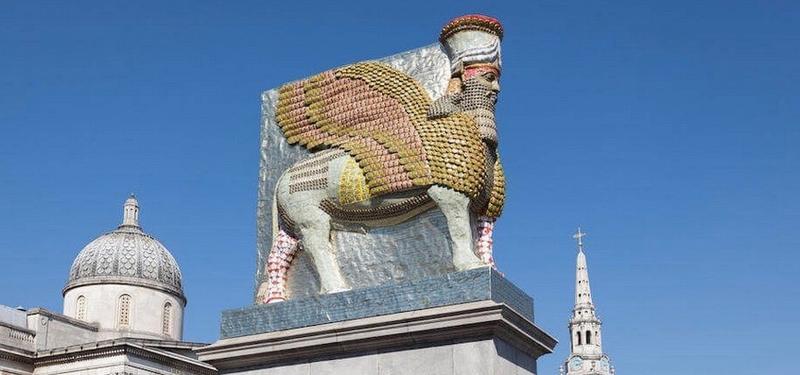
We ended with an analysis of the advertising and reviews of the 2018 British Museum exhibition I am Ashurbanipal, king of the World, king of Assyria. Although the idea of empire remains very attractive to some British audiences, for whom the memory of ‘their own’ empire still rings true, Assyria and its cultural remnants continue, often, to be an Orientalist fantasy: to quote The Guardian, nothing more than a “murderously efficient empire”.
Constructions of empire, acts of becoming and the self-fashioning of power and might, are not just the temporary products of wealthy kings and their commemorative inscriptions; they persist throughout time. When it comes to manifestations of immeasurable control, we are always looking back; as Ashurbanipal to Shulgi, the Victorians to the Assyrians.
This post was written by Krasis Scholar Kiana Rezakhanlou, a first-year undergraduate at Merton College, reading Classics and German.
Week 3 was devised and led by AJTF Petros Spanou of Baliol College, whose doctoral research in 19th century history examines ideas of peace and 'just war' and the ways in which they inhabited public discourse around the Crimean conflict.
Becoming Better
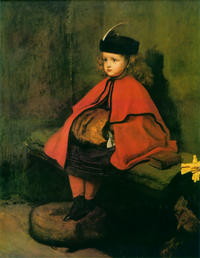
The attentive little girl in John Everett Millais’ 1863 painting My First Sermon is perhaps not how many of us imagine ourselves during sermons. Belying no ‘endurance’, she encourages well-worn caricatures of Victorian Brits as somehow alien, inoculated from boredom by their own haughtiness.
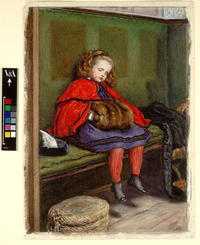
Yet, alongside its 1864 sister-painting, My Second Sermon, the pair undercut this typecast. The child, sent to unreceptive sleep, has undergone a transformation clearly unintended by the preacher. As Petros Spanou framed our third Krasis symposium, this inadvertent loss of audience raised questions of what may instead have been intended. How did Victorians successfully use sermons as vehicles for morality? How did experiences of sermon-going participate in moral inculcation? And how, ultimately, did the Victorians approach 'becoming better'?
We opened by attempting to encapsulate a sermon, though it was clearly agnostic to precise definition. Power relations are apparently inherent: a person in control acts upon a static audience. However, the latter are not totally passive, for their process of reception dominates sermons’ purpose; sermons require ‘accessibility’ for ‘understanding’. This leads to positive moral audience transformation, rendering recipients ‘educated’, ‘inspired’, and ‘improved’.
Comparing present-day political speeches was striking, and we wondered whether sermons had to be religious. Certainly, ‘popular’ appeal, today and for Victorians, was a common thread: in their, 19th century, England, 8 pages of sermons were published for every 1 of fiction. There was hunger for spiritually-minded self-betterment, and they were clearly connoisseurs. As Millais demonstrated, Victorians knew a bad sermon when they saw one.
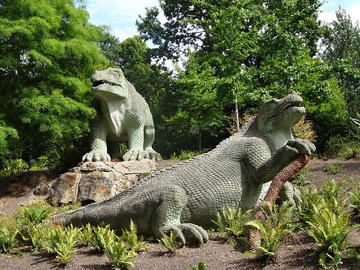
The question was thus, "what made a sermon ‘land’"? We discovered the Victorian conception of space as a participant in mental transformation, creating a holistic, multi-sensory experience to enhance the reception of messages.
The 1851 Crystal Palace, in a secular context, was a case in point, with The Westminster Review in 1854 fawning over the capacity of its sights and sounds – even down to life-size cement dinosaurs - to ‘kindle’ even the ‘dullest intellect'.
In a spiritual context, the picture varied according to confessional division. In groups, we examined three very different Victorian churches, considering the affective impact of space: Edinburgh’s (Presbyterian) St. Andrew and St. George’s West; Cheadle’s (Catholic) St. Giles by Augustus Pugin; and Clapham’s (Anglican) Holy Trinity (home of the abolitionist 'Clapham Sect' of Wilberforce, Venn and Macaulay).
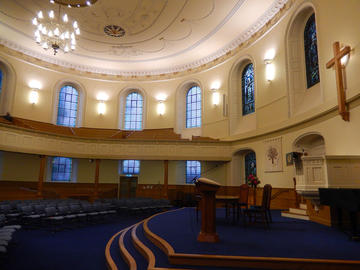
The Edinburgh and Cheadle churches were effective extremes. One a Presbyterian exercise in simplicity, removing any distracting ‘friction’ for the sermon message. The other, a Catholic exercise in achieving theophany via sumptuous space, with the sacred content of the sermon made palpable. Holy Trinity Clapham was something of a middle ground, though even Anglican tastes oscillated, witnessing the widespread removal of overly-comfortable pew booths, yet also the grand architecture that came from the Oxford Movement. Witnessing these contrasts was as if we had effectively distilled the iconoclastic debates that have shaken the Abrahamic religions for millennia.
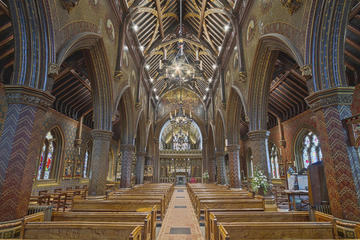
Strikingly, despite varied architectural styles, Petros explained that one trans-confessional approach to sermon texts was favoured: a threefold division into ‘Exposition, Application, Exhortation’. This accessible and recognisable format allowed moral messages to reach audiences most smoothly, and thereby to transform them. A scriptural tert would be explicated and then applied as a moral message, illustrated with contemporary parallels. The application would then precipitate a lesson, exhorting congregants to inward transformation and outward action.
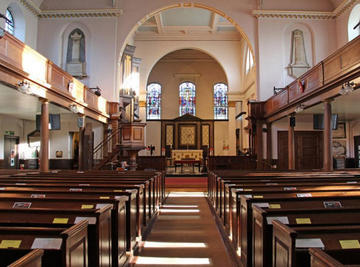
Using this format, in groups we attempted to compose our own sermons, each group receiving a short scriptural prompt: Joshua 1:9 emphasising fortitude, Proverbs 4:7-9 emphasising wisdom, and Matthew 4:44 emphasising compassion. We set to work within a 5-line limit for each trifold section, and the results, preached ‘live’ via TEAMS, were valuable lessons for our own complex age: exhortations on COVID-19, the Climate Crisis, and the world’s conflict zones.
While the affective impact of a webcam was no Victorian consideration, the use of their format, considering their incorporation of holistic experience, made them not so alien. Whatever the popular Victorian stereotype for emotional austerity, they had at least one mission with as much resonance today: in a changing world, to end up, as we all could, becoming better.
This post was written by Krasis Scholar Julian Wood, of University College, where he is reading for an MPhil in History.
Below are the three sermons on Becoming Better written by the Krasis team on May 12th 2021
Joshua 1:9
"Be strong and courageous; be not afraid, neither be thou dismayed: for the LORD thy God is with thee withersoever thou goest"
Here Joshua is exhorted by G-d to take the Israelites and lead them after the death of Moses. Joshua is asked to be bold, to be brave, to improve upon himself, as the occasion demands he must. Despite the daunting task Joshua is reminded that he is not alone and that G-d will accompany him throughout his journey.
As we move into through and beyond pandemic, we have been tasked with new challenges and responsibilities. We are charged with the care of our families and communities, even as we have experienced great loss ourselves. Both as a society and as individuals. Bravery is needed to carry us forth despite hardship or despite perceived isolation.
We ought to be strong, we ought to be brave, and we ought to be faithful. It is at this time that we are called upon to react with these virtues. Like Joshua, we need to become leaders for our communities and maintain faith despite the hardships upon us. For with these ideals we can walk in faith and in victory wherever we may go.
Proverbs 4: 7-9
"Wisdom is the principal thing; therefore get wisdom: and with all thy getting get understanding. Exalt her, and she shall promote thee: she shall bring thee to honour, when thou dost embrace her. She shall give to thine head an ornament of grace: a crown of glory shall she deliver to thee."
The proverb tells us to embrace Lady Wisdom, the divine property, so that we might earn a glorious crown. Her hand is offered to us, to you, an aid for your endeavour through the righteous path. Wisdom, in Her glory, is the way to glory itself. Her gift, upon our embrace, is that of a process toward enlightened consciousness: understanding. Understanding is the enactive engagement with all holiness afforded by wisdom.
We are called to respond to these words in our everyday life. These words talk of an abstract figure of wisdom, one that is separate from, but underpins, your actions. It speaks of the distance between wisdom, and of understanding, yet there is a powerful relationship here. This relationship must be maintained, and nurtured, like a beautiful flower rising from the Earth. Wisdom, and our understanding of the Bible’s teachings, will lead us to salvation.
So now, I entreat you: water your magnolia of wisdom! Let it flourish into a magnificent field of colour and splendour! Let it protect thee against the perils of cholera, let your wisdom grant you shelter. Let your crown be a beacon of health and virtue for your people.
Matthew 5: 44
"But I say unto you: Love your enemies, bless them that curse you, do good to them that hate you, and pray for them which despitefully use you, and persecute you."
Few people were as beset with as many enemies as our Lord. Here, while the Roman soldiers watched from the fringes of the crowd, and the elders of the Sanhedrin kept a close eye, he preached always a message of love and acceptance. Bless them that curse you. Do good to them that hate you. Pray for them which despitefully use you and persecute you. What does it mean to despitefully use you? It is those who are characterised by ill will or spite. Jesus asks us to pray for them. Not to spite them back, but to pray for them.
This week, there has been a great division in our land. Neighbour has turned against neighbour. It has been a week characterised by ill will and spite. As weak human beings, our first instinct is to embrace our spiteful natures. I ask you to remember our Lord’s words. Bless them that curse you.
Regardless of how you voted, regardless of whether you agree or disagree with others in your town, your street, your own family, remember that we are all brothers and sisters in God. Remember our brothers and sisters on the continent. Let me entreat you to move forward amidst the uncertainty, with love, with prayer, with acceptance. Hate and enmity are born of division. We can unite through love.
Week 4 was devised and led by AJTF Amy Lim, who is undertaking a collaborative DPhil in History between Oxford and Tate Britain, examining the relationship between monarchy and aristocracy in Stuart England through the lens of their artistic patronage.
Becoming Yourself
This week we will be exploring the ways in which we use objects to construct our identities. We’ll be doing this by looking at three eighteenth-century portraits, and the clothes, backdrops and props that the sitters and/or artists use to present themselves in a particular guise. How much do the objects we surround ourselves with represent our true selves? Be prepared to think about the objects that you use to present your own identity/identities.
Week 5 was devised and led by AJTF Katie Noble, a DPhil researcher in English investigating the FB Brady Collection of theatrical ephemera in the library of Christ Church College.
Becoming Someone Else
Digital technology has allowed people to become someone other than themselves in a multitude of ways, from fantasy role play to creating a fake dating profile. Yet for centuries people have transformed themselves into different characters to earn a living and entertain others – actors. However, outside of the industry the process of acting and inhabiting another persona are rarely considered. This nebulous task of becoming someone else was the central theme of our symposium.
We started by considering a distinction drawn between two styles of acting in the eighteenth century. Mimetic acting is merely replicating an emotional response without a full embodiment of the character’s feelings. There is a synthetic quality to the mimetic style of acting. Whilst the earnest style of acting requires the actor to authentically experience the character’s emotions.
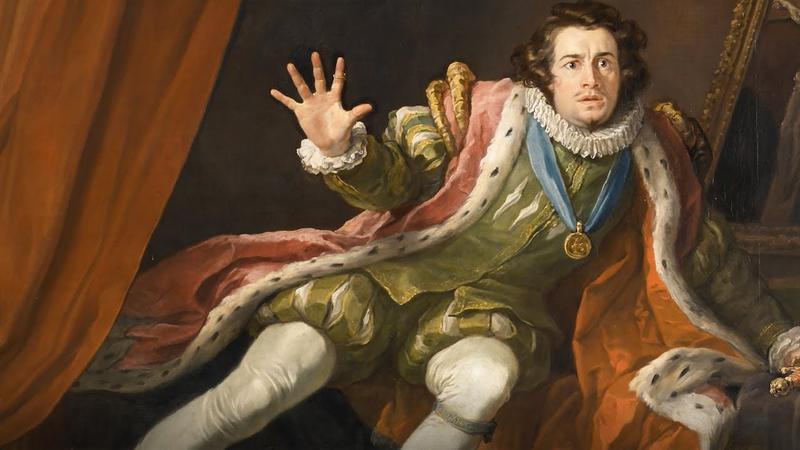
William Hogarth, David Garrick as Richard III (detail), c.1745; Walker Art Gallery, Liverpool
This may involve the actor recalling moments from their own lives where they felt similar to the character. The inference being that the mimetic style is somewhat hollow and contains less emotional truth than the earnest style.
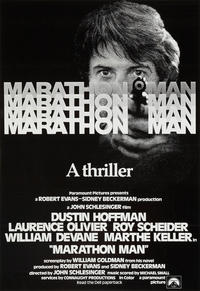
This question of truth would arise throughout the afternoon. In regard to the two styles, it could be argued that if the earnest actor has to recall their own personal experiences they aren’t fully becoming someone else. However, actors must maintain some sense of themselves otherwise they are not acting but descending into madness. As Jim pointed out, actors are constantly asked to become other people and yet remain themselves.
(Those seeking an amusing anecdote are encouraged to look up Laurence Olivier’s response to Dustin Hoffman’s approach to the earnest style whilst filming Marathon Man.)
Our first task was to examine clips of actors in different forms and styles of drama, our group was given a clip of Nicole Kidman in the film Stoker. The majority of the scene is shot in close up and the proximity of the lens to Kidman’s face and voice places the viewer practically in her mind. We discussed how this closeness encourages the viewer to believe this is an earnest performance. If we are close enough to see her thinking, hear the break in her voice, surely we’d spot any inauthenticity? Yet the viewer’s gaze is deliberately manipulated and controlled which could be considered its own form of mimesis.

We discussed too the tropes of naturalness that can persuade an audience the performer’s emotions are genuine. A glistening eye can be as mimetic as it can earnest. The other groups who were given an extract from Tony Kushner’s Angels in America, and EastEnders' iconic “you ain't my mother” scene between Kat and Zoe Slater, discovered similarly blurred lines between the two styles.
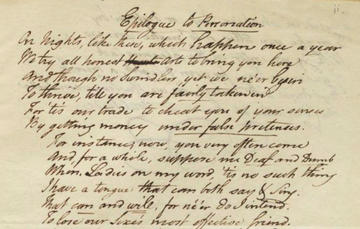
The scope of a Krasis symposium is as diverse as it is stimulating, so naturally after discussing soap opera Katie set us the task of transcribing the epilogue from the eighteenth-century play, Personation. Mercifully, the handwriting was no worse than the average student’s scrawl, although the word ‘swindlers’ took us a little longer to decipher.
After hearing the whole epilogue read aloud it was apparent how closely the verse aligns acting with deception. The actor’s job is to cheat the audience of their senses but as the audiences have chosen to attend the play they are “fairly taken in”.
This is in stark contrast to a lot of the language used around drama today. Actors and directors talk of the emotional truth of a character or play, and many actors will tell you with pride that a good actor is a terrible liar. The epilogue from Personation is concerned with literal truth: the actress references the fact that she is not really as old as the character she has been playing. Whilst contemporary performers are more concerned with the truth of feeling, the lack of literal truth is taken for granted. Yet portraying an emotional truth is the same as delivering an earnest performance, so perhaps we are not so different from our eighteenth-century predecessors as first appears.
The final task was to discuss images relating to three particular actors and three partiucular performances. Our group was given an engraving of the famous actress Sarah Siddons (1755–1831) in the role of Medea. Two things about the image were immediately striking.
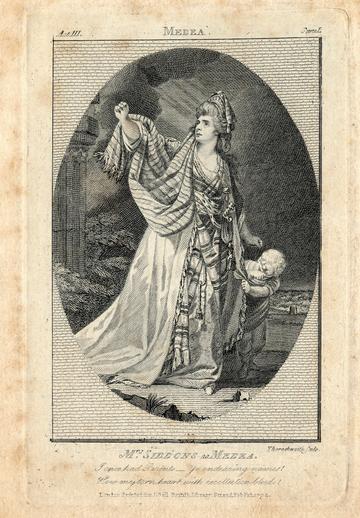
Firstly, that she is wearing a lot of scarves, that familiar colonial cliche of ‘exotic attire’. Secondly, that despite inhabiting the role of Medea, Mrs Siddons looks more like she is trying to shield the child clinging to her robes from harm, than do away with them. Perhaps, we thought, the artist was influenced by Sarah Siddons’ own reputation as a mother. In this image not only has Mrs Siddons become Medea but Medea has become Mrs Siddons. However, we went on to learn that Sarah Siddons in fact never played the role of Medea and was quoted as saying it wasn’t a ‘female character’. Yet for a brief moment on a Wednesday afternoon Mrs Siddons had become Medea, in our minds. Which proves an actor can take part in a performance without stepping a foot on stage.
I work in theatre and if I had a pound for every time someone has quoted “holding a mirror up to nature” at me, I would no longer need to work in theatre. Yet a mirror image reverses the objects it reflects. On reflection, where the truth in drama lies is no easier to spot now than it was in centuries past.
This post was written by Krasis Scholar Emma Jones, a theatremaker and writer undertaking the MSt in Creative Writing at Keble College.
Week 6 was devised and led by Heritage Scientist and AJTF, Dr Tea Gigho. Tea is post-doctoral Research Fellow in Conservation at the Ashmolean, where she has been undertaking a material investigation of the pigments used in the making of Wiliam Burges' Great Bookcase, deploying a range of non-invasive analytical and imaging techniques.
Becoming a Thing
"Nothing is lost, nothing is created, everything is transformed". Museum objects are often displayed presenting their history or telling the stories they unfold. By contrast, during this session, we are going to look at some of the objects in the Ashmolean using a different approach. What were these objects in the beginning? How were they assembled together? Why were some materials chosen over others? Join me this week: you will never look at a museum the same way.
Week 7 was devised and led by AJTF Lily Crowther, a curator at the Leamington Spa Art Gallery and Museum and a historian undertaking a collaborative doctorate between theV&A and Balliol College, examining the lost Museum of Building and Construction.
Becoming an Expert
How do we acquire the knowledge needed to make something? Can museum collections and displays serve as a medium for the transmission of expertise? In this seminar we will be looking at the work of contemporary potter Walter Keeler and discussing how material knowledge can be learned through the study of made objects. The seminar will involve participants making an object of their own, and will also invite them to consider how best to communicate knowledge through objects.
Week 8 was devised and led by AJTF and former Krasis Scholar Ruby-Anne Birin. Ruby-Anne is a DPhil candidate in Archaeological Science at the University of Oxford. Her research explores the origins of modern human behaviour and symbolism in Africa with timescales for archaeological sites. She started her archaeological career in South Africa with a masters at the University of Witwatersrand.
Becoming Human
At some point in the last 500 000 years, our ancestral species becomes something that resembles us today. But this fuzzy transition does not answer: when does humanity start and how do we see it in the archaeological record? Together, we will examine ideas surrounding human evolution and modernity using material culture and archaeological methodologies. These ideas will help us understand the ongoing transitions and innovations that are part of our collective story.
KRASIS 10
During Hilary term 2021, we explored the theme of Opening, from the perspectives of AJTFs working in archaeology, history, anthropology, musicology, art history, English literature and conservation science.
Week 1 was devised and led by AJTF Beth Hodgett, a collaborative doctoral researcher in archaeology, working at the Pitt Rivers Museum and Birkbeck College, London. Twitter @Wcoloursburntin
Who is this? – Enlarge image to text width, i.e. 7”. – Mystery object. – Crop. – Could be helmet.
We begin Beth Hodgett’s symposium by examining the working notes O.G.S. Crawford scrawled in red ink, pencil, and biro onto the blue card mounts of his photographs taken at the 1939 Sutton Hoo excavation site. Much as the archaeologist and photographer’s images show the dig findings resting on the earth, his annotations too show his thinking process in situ.
Each photograph is taken as artefact, not document. The photographer’s handwritten additions highlight the journey from guesswork to polished interpretation. The second set of photographs is mounted on brown card. Here, that gained (or created) knowledge has been tidied into neatly inked formal captions: Cleaning the silver tray + drawing the other objects for our plan; Part of the silver tray, showing its decoration.
Every archive comes down to chaos held at bay. We trace the lively prehistory of the fifty box files forming the O.G.S. Crawford photographic archive at the Institute of Archaeology, a narrative reconstructed through Hodgett’s oral history work.
In his will, Crawford directed his executors to burn the contents of a trunk in his room without examining its contents. Rumours suggest the Institute of Archaeology’s photographer rescued Crawford’s eighty albums from a museum skip. An unnamed female researcher ripped out the album pages and reorganized the photographs into box files, creating a new order. Decades later, Crawford’s original celluloid negatives were removed from their wax paper sleeves for fear of spontaneous combustion.
Objects, like people, have lives.
The archivist’s work begins in medias res. It is the time spent in the same snug room day after day – immersed in the contents of the same burgundy boxes, revisiting the same photographs of archaeological sites or castles, cats or clouds – that yields up insights into how the images interrelate. New details and connections emerge through deep looking over time.
The photograph is the focus. But the surrounding rings of annotations, filing systems, curatorial history, acquisitions and storage records spin a dynamic pattern of elements that invites creative play, showing that fieldwork need not require distant journeys. Excavating an archive becomes like opening up new ground.
This post was written by Krasis Scholar Sylee Gore, a poet and artist undertaking an MSt in Creative Writing at Oxford. Twitter @berlinreified
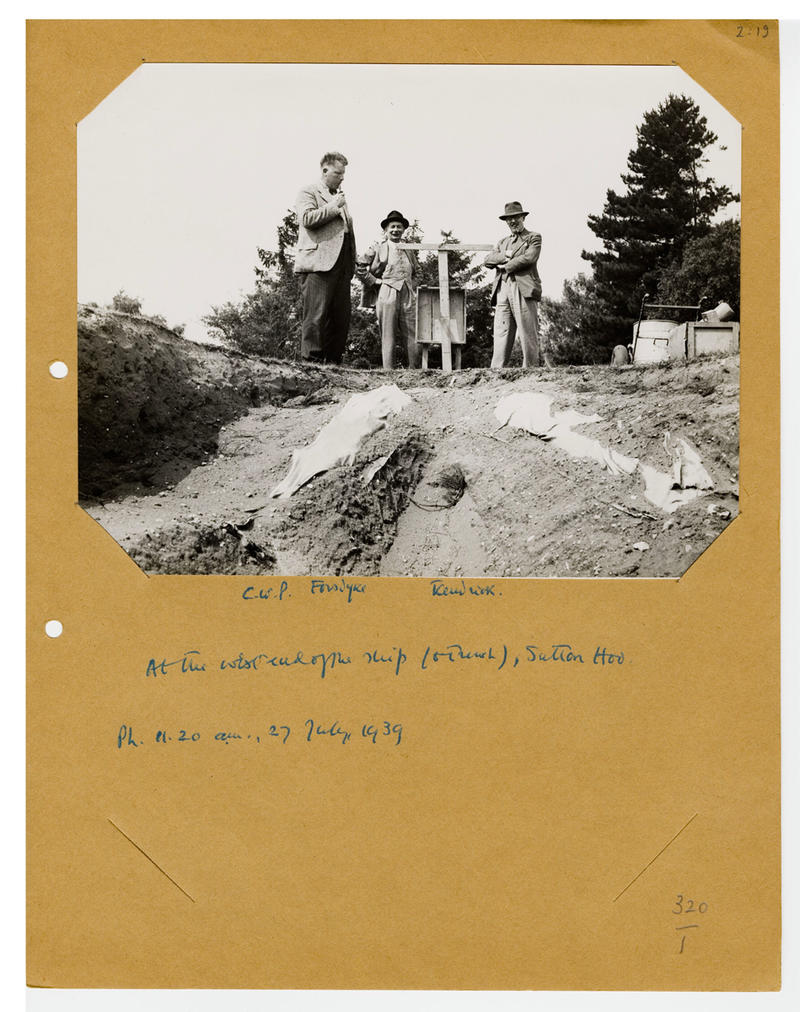
The west end of the ship, Sutton Hoo burial, 11.20am, 27th July 1939; annotations in Crawford's hand
Image reproduced courtesy of the O.G.S. Crawford Photographic Archive. Institute of Archaeology, Oxford
Week 2 was devised and led by AJTF Katie Noble, a doctoral researcher in English Literature, working on 18th century theatre, using theatrical ephemera in the FB Brady Collection at Christ Church College. Twitter @Kaatienoble
Open Access?
Accessibility to resources comes in many shapes and sizes. As Katie Noble demonstrated in her symposium on Open Access, the issue of accessing resources for research is vast and complex, whether it’s completing your DPhil or feeding your appetite for academic knowledge. Beginning by looking at reading lists from our own disciplines, it became clear that even with immense institutional privilege, the barriers to entry for research are varied.
These barriers can take the form of an institutional log-in, complicated online interface, or six flights of stairs to an archive, to name a few. Katie outlined the ways in which limitations to access pertain to physical accessibility, online accessibility, social accessibility and cultural capital, care regarding content and trauma, financial barriers, public engagement and impact, amongst others. Not to mention that circumstances afforded by the Covid-19 pandemic further complicate these matters—ameliorating some while exacerbating others.
While the group conversation navigated these various twists and turns on the subject, we landed on a few struggles in particular that many researchers are currently facing. One of these is institutional politics, which could mean requiring supervision to view archives in a college basement or a lack of advertising for ongoing projects and available resources. This gives rise the issue of arbitrary manuscript digitisation, another topic that requires a worldwide collaborative strategy to make collections available online. Amid the Covid-19 pandemic, research has been forced to go virtual, but often resources can only be found physically in archives and libraries, which are temporarily closed or have restricted access.
What happens if those materials do get digitised and are made accessible to the general public? Often, open-access research carries the misconception that it ranks lower on the hierarchy of scholarly sources. We must rid ourselves of this notion and appreciate that restricting resources to those with paid subscriptions or institutional log-ins does not enhance their value. Additionally, we must be dynamic and flexible in solving issues of access while recognising that making resources available for ‘open-access’ goes beyond merely being able to Google them. For one, it means making academic work widely available and user-friendly while ensuring that researchers and authors are properly compensated. It also means looking inward at our own institutions and points of access to better this issue in its myriad forms.
This post was written by Krasis Scholars Victoria Horrocks, who is studying for an MSt in History of Art and Visual Culture at Hertford College, and Sandra Saade who is in the second year of an MChem degree at Christ Church.
Week 3 was devised and led by AJTF Petros Spanou, a doctoral researcher in History at Balliol College, working on Victorian ideas of war and peace, particularly in relation to the Crimean War. Twitter @Petros_Spanou
Immediate and Visible: Opening the First 'Media War'
What is war in the eye of the beholder? To the readers of British periodicals during the Crimean War of 1853-56, often referred to by historians as ‘the first media conflict’, the visibility of war changed drastically.
This week, Krasis Scholars were asked to explore how immediacy and visibility interlink through representations of war. Petros Spanou began this session by asking what war means to us as individuals. In our era of hyperconnectivity and never-ending media cycles, we are all too familiar with war: it is on the televisions of waiting rooms, the notifications at the corners of our screen, and can always be found at our fingertips. In spite of the near permanent state of war in global history, it is something that most of us see and feel at a distance. And these ways of ‘seeing’ and ‘feeling’ are almost always mediated by another eye.
The term ‘media war’ seems a misnomer in the 21st century, as we find it difficult to divorce our understanding of war from media representations. Yet is the high visibility of war dependent on a need for immediacy? Why do we - and indeed, why did onlookers of the Crimean war - want to view war to begin with? Moreover, how do we want to view war? Through a series of commissioned engravings and photographs, Petros asked us to consider what a ‘media war’ truly entails.
The Krasis Scholars began the discussion thinking about what it means to make conflict ‘visible’ and ‘immediate’, confronting the presentism we often bring to these terms. In the context of the Crimean War the process of bringing an ‘immediate’ image of the war to the reading British public could take weeks. Petros then introduced us to a series of wood engravings representing scenes of the conflict that appeared in The Illustrated London News over the course of the war.
The publication sent three engravers, Edward Goodall, Joseph Archer Crowe and Constantin Guys, to report as direct observers of the war in the Crimea. Their status as ‘artists’ rather than ‘press’ granted them unprecedented access to the army and the battlefields. The scholars speculated about the accuracy and authenticity of such images, recognising the time they would have taken to produce and the deployment of traditional artistic techniques to heighten their drama. Yet considering their place within the broader Victorian cultural milieu problematizes our demand for ‘authentic’ representations of violence; the fact that contemporary readers believed that the images were legitimate reconstructions of the events in the Crimea is perhaps more significant than their factual accuracy.
Petros brought us on to examine the impact of the introduction of photography to capture the events of the Crimean war. “For the first time since men fought we shall have history illustrated by the certainty of a reporter who never errs,” wrote one contemporary viewer of these new snapshots of reality. Far from the neoclassical representations of destruction and pain, the photographs brought a sense of reality and true visibility to representations of the Crimean War.
Yet, the Krasis Scholars were less than satisfied with assertions that the camera is infallible. In spite of our presuppositions, we came to the conclusion that the images in the wood engravings were possibly more accurate than those captured by photography, which was in its incipient stages of development at the time, requiring long exposure with posed subjects.
Perhaps it is our own postmodernity that forces us to doubt the concept of objective photography. Perhaps it is the ruins of a neoclassical building gazing over the rubble of a war well fought that reminds us too much of the commissioned engravings. Whatever it may be, despite the changing media of 'media wars', the relationship between immediacy and visibility remains complex and dynamic.
This post was written by Krasis Scholars Noorie Abbas, a third-year undergraduate in History and Politics at New College, and Corrina Summers, a second-year undergraduate in History and English at Harris Manchester College.
Week 4 was devised and led by AJTF Vithya Subramaniam, a playwright and doctoral researcher in Anthropology, working on the spatial and material experience of South Asian identities, particularly Punjabi, Sikh and Singaporean. Twitter @straitssettled
You'll Never Walk Alone
How do we understand walking?
What does the modern human take note of and what is particularly important when deciding upon a walking route?
And how does a contemporary anthropologist use walking as a research tool to explore identity and environment, and the relationship between the two?
Vithya Subramaniam sent us out to walk, tracing our interaction with the ‘more-than-human’
In comparison with a bus journey, walking allows access to an urban wall (the noise of traffic, of pets, the smell of fresh grass), a social context and to the environment, all of which may be explored by recording empirical knowledge in the form of lists, photographs or scene drawing.
However, considering the worldwide impact of the pandemic, weather and the purpose of the walk (academic or non-academic, solo or in company, social or practical), the ways people relate to their walking experience definitely shape its way of being.
Deciding on the threshold of an ambulatory experience is more than a question of when to press 'Start' on Strava - it is an unconscious testimony to our relationship with the landscapes around us and might tell us a lot about what we most value when moving through different environments.
We shared our experiences of walking and the records we kept
Comparing the views of those who walked rurally with those who chose a route through the city (whether through the golden Headington stone of Oxford or the urban cityscapes of Berlin); those who walked alone with those who enlisted company; and those who wrote notes with those who painted watercolours; all this opened up a conversation on how and why we travel on foot, and what the value of recording this travel might be.
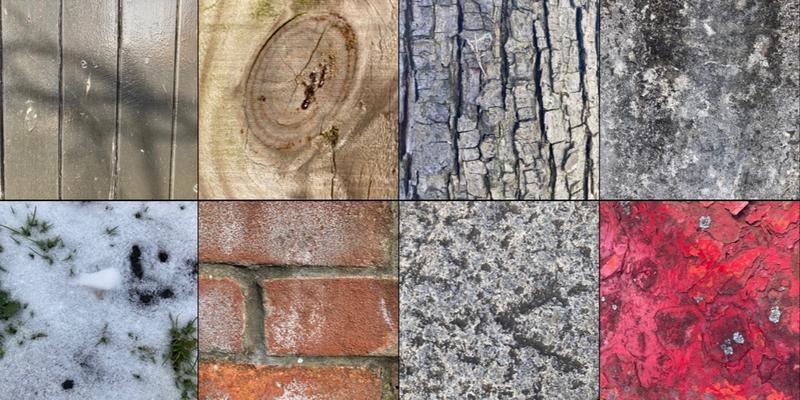
A walk to the postbox noticing materials that might be used to make sculpture
A particular experience has been choosing completely different routes to reach the same destination, no matter the duration or distance, depending on the goal needing to be accomplished.
Another question we came across in discussing how we notice the more-than-human was whether the issues we think of when walking determine why and how the walk even starts or ends.
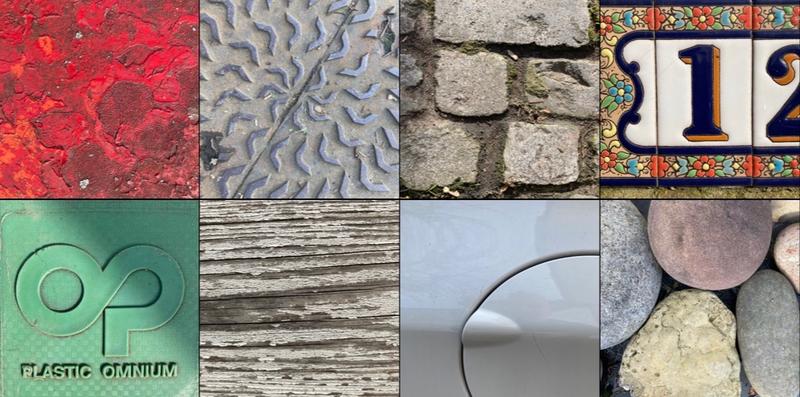
A walk home from the postbox noticing materials that might be used to make sculpture
We walked around the rooms we work in
Having been asked to walk around the room and record by closing our eyes what we hear, what kind of smells we perceive, what makes a cosy place comfortable, we crossed the room by our usual route and then by an alternative. Most of us had comparable encounters : the light taking up a lot of space, the room as a microcosm of the world, divided into sections (space to exercise, bookshelves, a spot to play). These experiences raised an essential question: are the things there because I am there or is it the other way around?
The diverse ways of recording included sketching lines accounting for the side of the space noises came from, the unexpected sneeze from another room, or arranging words into blocks.
We walked from the Bodleian to the Ashmolean on Google Maps
Finally, we questioned the accuracy and reliability of the pictures taken for an online walk and considered the timeframe, overlapping images from 2019, 2018 and 2012. An important strength of walking virtually was, no doubt, the possibility of discovering alternative routes, quieter or narrower streets, making the journey shorter. Nevertheless, our inability to explore through the human senses was also highlighted: the noise of the buses, the feeling of the raindrops, or the flatness of the ground.
The experience of moving from a sunny morning to a rain-soaked afternoon (or from a busy Broad Street to an almost empty one) in the space of a keyboard click is jarring, accentuating the loss of physical sensation and real-world interaction in the theatre of the everyday walk.
Vithya's symposium allowed us to explore again the social rhythms of a world currently deprived of spontaneous interaction, and left many of us with a keener understanding of how walking shapes our lives on a daily basis; as well as a lingering nostalgia for a lost Oxford.
Some of the texts Vithya has drawn on in her own research and practice are:
Ingold, T., Lines: A Brief History (London: Routledge, 2007)
Ingold, T. and Vergunst, J. L. (eds.), Ways of Walking: Ethnography and Practice on Foot (London: Routledge, 2008)
O’Neill, M. and Hubbard, P., ‘Walking, sensing, belonging: Ethno-mimesis as performative praxis’, Visual Studies, 25(1) (2010): 46–58.
O’Neill, M. and Roberts, B., Walking Methods: Research on the Move (New York: Routledge, 2020)
Springgay, S. and Truman, S., Walking Methodologies in a More-than-Human World: WalkingLab (New York: Routledge, 2018)
This post was written by Krasis Scholars Sandra Saade, who is in the second year of an MChem degree at Christ Church, and Annabelle Fuller, who is a third-year Classics and English student at Magdalen College.
Week 5 was devised and led by AJTF Ruby-Anne Birin, a doctoral researcher in Archaeological Science, working on the application of infrared-radiofluorescence (IR-RF) to the dating of Early Stone Age sites in South Africa. She is also the first former Krasis Scholar to return as an AJTF. Twitter @Rubys_Travels
Sedimented Histories
Geography is not fixed; we produce space and its meanings. In Week 5 of Krasis 10, we worked with archaeologist Ruby-Anne Birin to rediscover what maps can do, making our own intertwining and varied cartographies, putting into practice - as Krasis seminars are bound to make us do - an alternative, productive way of thinking about time and space,
To begin, we created our own maps, using ArcGIS StoryMaps software: cartographies that are not fixed, but are rather socially and culturally produced. Feeling pangs of lockdown nostalgia, I produced a map of all the places where I had fallen in love, accompanied by pictures. Another scholar produced a map of the locations of all of the people they had met and bonded with via video gaming. The constellation of human dots stretched far and wide across the continents.
Next, working in small groups we toggled between maps of Oxford from different periods, to consider how the spatial - and thus social - relationship between student and town has shifted. We thought about how changes in political climate change the maps we make, and in what ways maps might be manipulated to reflect particular values or goals. We began to experience a strange sense of bodily relation to maps from hundreds of years ago. Placing myself between faded parchment lines, I could chart my route from Tesco to home, imagining cycling across Magdalen bridge and into the swirl of the bustling Cowley roundabout, through maps made when it was filled with grazing cows.
We moved on to objects associated with Oxford and currently on display at the Ashmolean. Since, as Ruby-Anne pointed out, ‘each object has its own story, linked to many places and multiple lives,’ we were to use five maps to reconstruct the unique history of our objects through space and time.
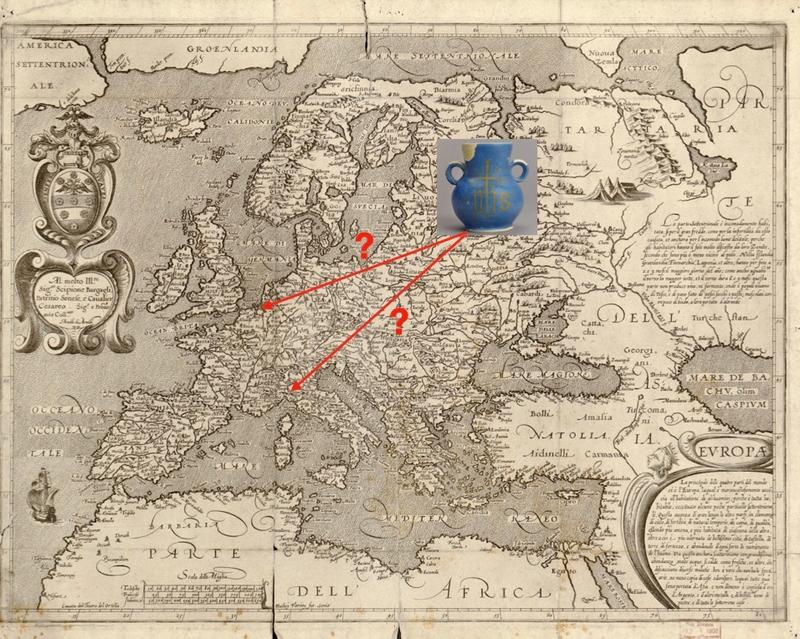
Map of Europe by Arnoldo di Arnoldi, 1600
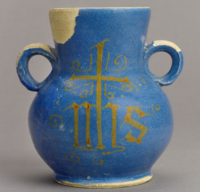
My group investigated a little, blue-glazed, earthenware vase or cup of circa 1520-40, from Liguria or Antwerp, inscribed with the Christian IHS trigram.
Like bona fide detectives, we explored exactly where it would have been buried, while the historian among us spoke to the reformation, and the possible fate of a catholic object in 16th century Oxford.
Its burial had been in what was a garden behind Broad Street; but as we explored the subsequent maps, we saw how more dwellings and buildings were constructed over it until it was unearthed in the 1930s during excavations before the construction of the Bodelian Library extension.
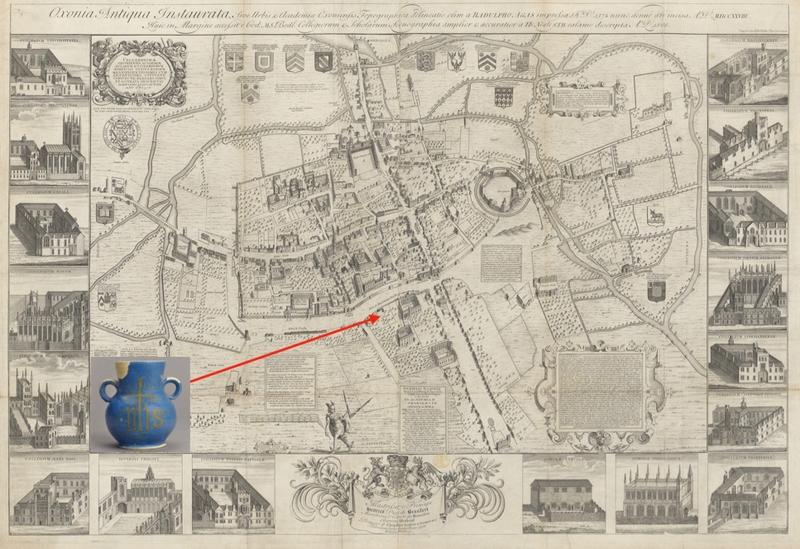
Oxford, by Ralph Agas, 1578; republished by Robert Whittlesey, 1728
The activity was meaningful in multiple ways. To me, it seemed a good example of how we can think about objects - what work goes into not only making and keeping them, but even discarding them? If we were to simply look at the basic form and materials of the object, what stories would we miss?
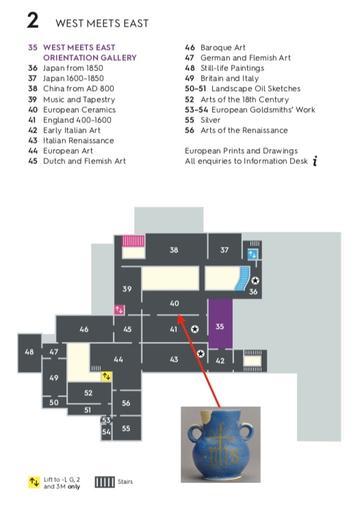
Instead of taking the object’s presence in the museum for granted, we asked how it got here? Why? What serendipities had to unfold for it to emerge, be acquired, written about, catalogued and placed within a glass box?
Maps acted as the ideal tools to explore these questions. But Ruby-Anne’s invitation to ‘propose other maps which may assist in unravelling your object’s mystery,’ required us to question our assumptions not just regarding cartography, but also the traditional fixity of time and space in Western knowledge. I began to think about my own research, which is rooted in feminist redefinitions of the things we take for granted - like time and space - by employing queer lenses. I considered my understanding of feminist phenomenology in relationship to maps, and why and how it was possible to imagine myself existing between the lines of a very old map despite the yawning distance of time.
I recalled two books I’d recently read about theories of bodies in space; by Katherine McKittrick on the cartographies of Blackness, and by Sara Ahmed on queer phenomenology; because following McKittrick, it is my belief that ‘human geography needs some philosophical attention.’ This is exactly the kind of attention that this symposium encouraged, not only because we want to alter the oppressive strictures of traditional disciplines, but also because we simply want to make new maps and new meanings.
Sara Ahmed describes how the phenomenologists Edmund Husserl and Maurice Merleau-Ponty both refer to bodily horizons as ‘sedimented histories.’ Ruby-Anne’s maps allowed us to literally see this sedimentation, as we toggled the transparencies of older maps onto newer ones. As an archaeological scientist, her research deals with scientific sedimentation; mine with amorphous, bodily sedimentations. Nonetheless we are both interested in charting these layers, regardless of the forms they take. And as the seminar seemed to demonstrate, we are all, in one way or another, invested in understanding the sediments we stand on.
References
McKittrick, Katherine, Demonic Grounds: Black Women and the Cartographies of Struggle (Minneapolis, MN and London: University of Minnesota Press, 2006)
Ahmed, Sara, Queer Phenomenology: Orientations, Objects, Others (Durham NC: Duke University Press, 2006)
This post was written by Krasis Scholar Kathleen Quaintance (also an Ertegun Graduate Scholar), who is reading for an MSt in Women's Studies at St Peter's College.
Week 6 was devised and led by AJTF Dylan Price, a former Krasis Scholar and now a doctoral researcher in Music, considering the affective landscapes of the music of Antonín Dvořák in the interstitial space between political geography, international relations, music analysis and game theory.
Sensing the Museum
Victoria
When we walk through the Ashmolean, how do we feel?
This week’s symposium, led by Dylan Price, asked us to engage with the sensory experiences tied to museum-going. When we walk through a gallery, we are not just affected by seeing an object, but also by what we hear, feel, touch, and taste. In the absence of those sensory experiences, we were presented with a range of objects in the Ashmolean and asked instead to imagine our engagement with these works of art.
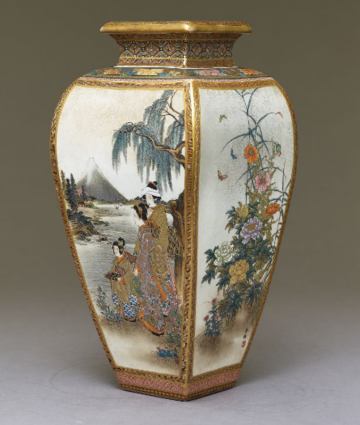
Kyō-Satsuma earthenware vase, Hōzan workshop, Kyoto, c.1890
Looking first at a Kyō-Satsuma ware vase from the workshop of the late 19th-century potter, Hōzan, sitting amongst the glass cases of the 19th century Japanese Gallery, we imagined the experience of weaving between the arrangements and analysing the works included in them. Ceramics, we determined, illuminate an interesting relationship between the art-object and the museum space.
With the display of ceramic plates, cups, vases, and teapots, for example, we are presented with objects that we typically use in our daily lives. But what happens when quotidian objects are arranged in a gallery display? Theorist Bill Brown has an answer: that once they are decontextualised, separated from their utilitarian purpose, objects become ‘things’ endowed with greater meaning. Significantly, a ‘thing’ has the capacity to affect us emotionally, intellectually, or phenomenologically, whereas an object merely serves a pragmatic purpose.
In many ways, Dylan’s questions interrogate the enigmatic ‘thing’, and reflecting on the sensory experience of our engagement with art in the Ashmolean revealed how multi-faceted that engagement is. For example, each of the glass cases in the Ceramics Gallery are packed with beautiful, delicate ‘things’. While the Kyō-Satsuma vase is a remarkable object in its own right, its display, and the displays around it locate it among an inundating swath of other works of art.

Recalling my walk through this part of the Museum back in October, I remember feeling very aware of my body—sensing a need to shrink. Aware of the fragility of the objects and the silence of the gallery, my viewing experience demanded lightness of foot and precision of sight. With so much to see in such detail, I felt an impulse to be as tiny as any one of the teacups.
When looking at it virtually, the vase and its intricacies embodied an interesting manifestation of the ‘thing-ness’ Brown ascribes to the decontextualised object. While the gallery space constitutes an initial layer of separation from any sort of utilitarian purpose, a second layer of decontextualisation emerges when viewing the work on our computer screens. We seemed to inch further and further from physical engagement, and yet the vase still conjured a charged sensory experience.
A scholar in our discussion group asked, ‘What would it sound like if it broke? I wondered, ‘How would it feel like to the touch?’ Such imagined understandings of our engagement with objects feel especially pertinent in the Covid-19 pandemic when our closeness to art, and to life, feels so in flux.
Avery
We finished our discussions of objects, museums and sensory experience by exploring digital spaces of curation. The Universal Museum of Art has created a virtual museum comprising exhibits that users can move through digitally. This open-access project creates a completely different understanding of not only the pieces of art themselves but also with the museum space more broadly.
In navigating our way through the exhibit A Walk into Street Art, a virtual collection of graffiti and street art curated by Yannick Boesso, our discussions emphasized the ways in which a digital space perhaps provides a more honest medium of display for such a genre, whose process of creation is inherently anti-establishment. The connection to video game spaces was also brought up as a comparison for the virtual museum; both employ identical forms of world-building in order to tell a story of sorts; yet video game design has seldom been considered ‘art’ in the sense we see displayed in the virtual museum (the 2018-19 V&A show, Design/Play/Disrupt is an honourable exception). The focus on street art potentially bridges part of this institutional and cultural gap between what is ‘art’ and what isn’t.
Like seeing online images of Ashmolean objects, moving in a digitally created space raises the question of sensory experience. Even though the weather had been designed in detail and you moved from indoor to outdoor spaces, the virtual museum denies the non-visual senses such as touch and smell. Audio may be embedded in the experience, but the ambient noise that usually defines museums is absent. What was notable, however, was the capacity of VR to convey the scale of artworks when compared to conventional digital representations.
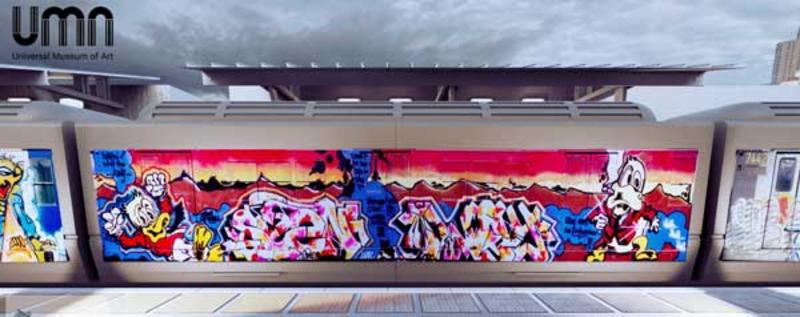
Finally, we moved into a discussion of authorship and legitimation. In the section of the digital museum titled ‘Subway Art’ we were able to observe a tagged subway train from the #5 Lexington Express line in New York in (virtual) situ. The art preserved on the cars, however, is credited not to the graffiti artists who painted them, but rather to the photographer, Henry Chalfant, who photographed the train in 1980 as part of his work as an urban culture photographer. Is graffiti art legitimized by being filtered through the more accepted medium of photography? Or is there a symbiotic relationship between the two? Who is considered the ‘artist’ when the original creator is unknown to us? And what about the designers who built the digital versions of these pieces for the virtual museum? Are they artists and, if so, in what sense?
These questions complicate our assumptions when we picture art, artists, and the museum space. Dylan’s careful engagement not just with the what but also the how of museums and curation allowed us to reflect on the permeability of categories we perhaps take for granted in the art world. This permeability is intrinsic not only to a world currently digitized by COVID but also to the future of museum spaces more broadly.
References
Brown, Bill, ‘Thing Theory’, Critical Inquiry, vol. 28, no.1, Things; Autumn 2001, pp.1-22
This post was written by Krasis Scholars Victoria Horrocks, who is reading for the MSt degree in History of Art and Visual Culture at Hertford College, and Avery Warkentin, who is taking the MSt in Classical Archaeology at Lincoln College.
Week 7 was devised and led by AJTF Dr Tea Ghigo, Heritage Scientist and Conservation Research Fellow on the Chromotope Project, for which she is undertaking an analysis of the pigments used in the decoration of William Burges's astonishing Great Bookcase, now on display in the 19th Century galleries at the Ashmolean. Twitter: @ercchromotope
Beyond Labels
Imagine you are the Keeper of Western Art at the Ashmolean Museum. One day, a researcher contacts you and asks permission to undertake pigment analysis of the Great Bookcase. How do you respond? As Keeper, what concerns do you have? What challenges do you anticipate, and how might you address them?
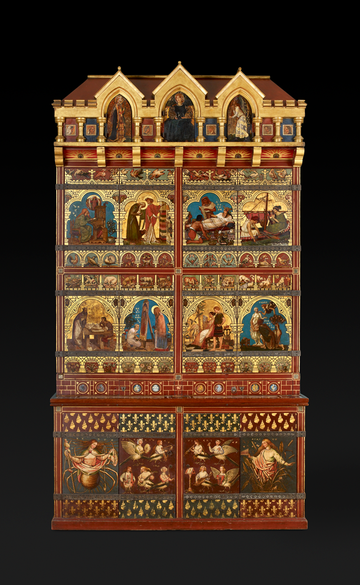
These are just a few of the questions we sought to tackle in this week’s Krasis, which was led by Tea Ghigo, Heritage Scientist and post-doctoral Research Fellow in Conservation at the Ashmolean. Tea opened the session by challenging us to consider the label for the Great Bookcase, which was designed by architect William Burges, painted by 14 artists under his supervision, and exhibited at the 1862 International Exhibition in London.
The Bookcase’s museum label describes it as “painted and gilded deal with inlaid marble and pietra dura panels, 1859-1862.” This description, though accurate and concise, raises a host of questions of its own: what kind of paint was used? How exactly was it applied, and why? How were the materials chosen? Where did they come from? How did these different materials come together across the three years during which Burges’ team worked on the bookcase?
To help us answer these questions, Tea introduced us to heritage science, a field that combines art, art history and archaeology with the natural sciences to investigate the materiality of heritage objects. Heritage science encompasses techniques such as radiocarbon dating, dendrochronology, petrological studies of ceramic materials, and material studies of inks, pigments, and metallic artefacts. Each of these inquiries offers different insights about different types of materials, and each allows us to probe deeper—literally and metaphorically—into the story of a given object.
Whenever possible, heritage scientists prefer to apply non-invasive investigative methods, such as infrared reflectography and X-ray fluorescence, using portable instruments, which allow objects to be examined without removing them from their original locations or the galleries or museums they now inhabit. During the session, Tea challenged us to use data she had gleaned from these methods to uncover the story of the Bookcase’s construction.

She showed us how the Bookcase’s central panels, which now bear blue and gold backgrounds, originally depicted far more intricate scenes. This backstory, invisible to museum visitors, allows us to gain a clearer picture of the object’s history and hypothesise about the designer’s motivations. By using scientific techniques to complicate what is visible to the naked eye, heritage scientists are able to enhance our view of individual artworks and, perhaps more importantly, of the historical contexts in which they originated.
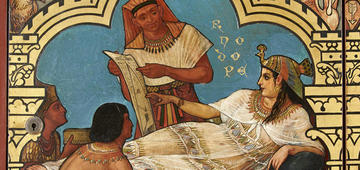
Yet, as we realised during our discussion of the Bookcase, acquiring this knowledge is not enough, nor is publishing it in an academic journal for the consumption of fellow researchers. How could we allow a museum label to continue offering such a simplified portrait of an artwork, we wondered, if we knew its story were so much more complex? We could not.
In considering the possible applications of insights from heritage science, we revisited discussions on openness and accessibility raised in previous weeks. What if we recreated the first set of Bookcase panels, before they were painted over in blue and gold? What if we displayed this set to visitors using an interactive digital model, so that they could compare the “before” and “after” states themselves? What if we tried to reconstruct the atmosphere of the workshop and trace the geographic origins of the paints and other materials used? Possibilities abounded.

Our brainstorming led us to realise that what might, at first, seem like a simple pigment analysis is never such a simple matter after all. Such analyses certainly highlight the difficulties posed by the conservation of invaluable works of art. They might also help us construct—and present to the visitor—a more nuanced understanding of those same objects. But in doing so, they complicate the questions of how much a short museum label can communicate and what are the optimum conditions for responsible viewing, underlining the twin challenges of care and interpretation inherent in the work of museum curation. If we had revisited Tea’s original set of questions at the end of the session, we would have emerged with altogether different answers.
This post was written by Krasis Scholar Maggie Wang, who is in the second year of a BA degree in History and Economics at Pembroke College.
After the session ended, Tea invited the whole Krasis team to consider why heritage science should form part of museums' interpretive narrative. This is the word-cloud that resulted.
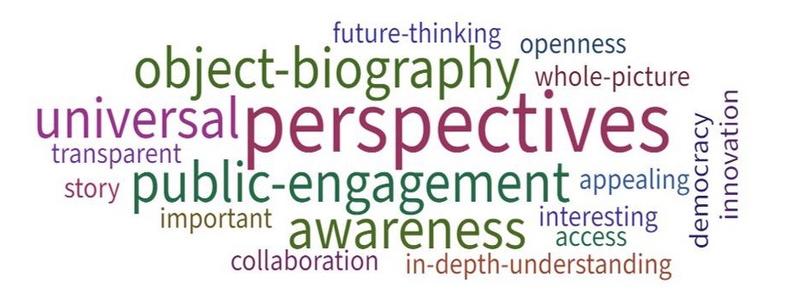
Week 8 was devised and led by Alexis Gorby, a doctoral researcher in Classical Archaeology whose work examines the social, religious and material significance of late-antique, Roman sarcophagi. Alexis is also the co-leader of Talking Emotions, a programme of public, research talks by Oxford ECRs exploring aspects of the history of emotion through the lens of the Ashmolean's collections. Twitter @AlexisCGorby
Zooming In and Zooming Out
In the last session of Krasis 10, Alexis Gorby led us into the world of late antique mosaics. After watching Ray and Charles Eames’ film Powers of 10, we were challenged to consider the role of scale in how we approach mosaics, and what each individual piece may be able to tell us about the larger artwork and the contexts in which we see it.
We were first split into smaller groups to consider a single gold tessera and discuss what we may be able to learn from it. We considered the costs and impact of using gold, how it was made, and by whom.

It was an intriguing way to approach an artwork and raised to us particularly the challenges that must have come with making so many tesserae and keeping them neat and consistent. Alexis then explained to us the way tesserae were manufactured, and the different materials and chemicals used to create each colour inside the tiles, making each tile completely unique.
In the second group session, our scale was widened to a square of 10x10 tesserae. We talked about how the differences between each tile, in texture, colour and shape, whether they were deliberate or not, changed what we saw.

The aesthetics of intentional imperfections were discussed, and we speculated on where the mosaic may have been – on a wall, a floor or a ceiling. Back together again, Alexis led us to consider how the ways the tesserae were inserted into the medium could change their effect, and the effect of the whole mosaic, as the sunlight catches different sides and edges at different times of day; how the materiality of objects works in context.
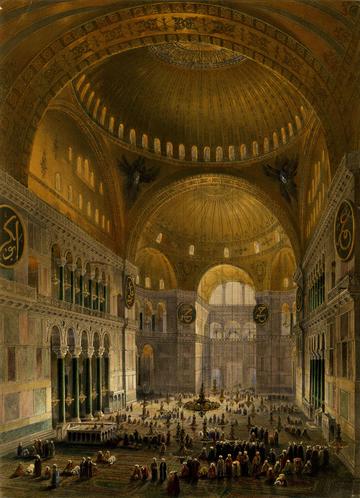
Interior of Hagia Sofia, 1852
Alexis then introduced different objects to our groups, looking at candle holders and incense burners, to further consider the environment surrounding the mosaic, the effect of light and smell and their impact on how we understand the artwork.
Looking at the example of the Hagia Sofia in Constantinople (now Istanbul) we began to think about artworks not just as visual encounters but as rich sensory experiences. Recordings of haunting liturgical music helped to immerse us, as we were invited to think about not just what we could see but also the many sounds, smells and emotions that form key parts of how an ancient artwork is seen and understood.
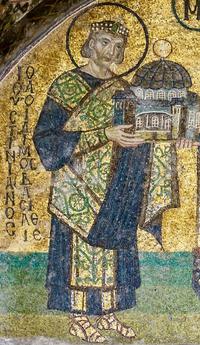
Justinian presenting a model of Hagia Sofia to the Virgin; Hagia Sofia, Southwestern entrance
Finally, we zoomed out one more time, to consider the place of Hagia Sofia in the wider imperial landscape of late-antique Constantinople – why it is where it is. And with that, the final Krasis session came to a close all too soon, as we reflected on how Alexis had skilfully led us from a single tessera to the landscape of an entire city, to show how each point on that scale can inform our understanding, give us a new perspective on the function of mosaics.
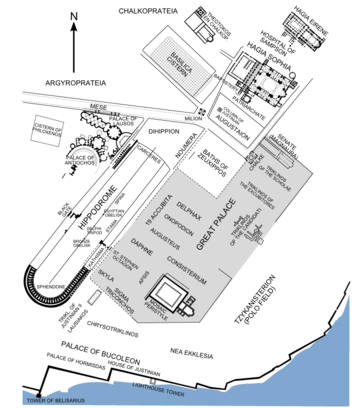
Imperial Contantinople at the time of Justinian I, 6th century CE
As someone observed during the session, these eight Krasis meetings have formed something of a mosaic themselves, building on ideas and perspectives from previous weeks that, although diverse in subject, have been united around our theme of ‘Opening’ by the passions the ECR scholars have shared with us through their research. Krasis has been one of the highlights of my term, both for the people I’ve met and the discussions we’ve had. A blog post cannot convey the levels of enthusiasm and dedication every member of the team has brought to this programme, but I hope reading our summaries will encourage prospective students and researchers to apply to Krasis in the future!
This post was written by Krasis Scholar Gemma Bond, who is a third year undergraduate at Lincoln College, reading Classical Archaeology and Ancient History.
Krasis Scholar Sylee Gore, a poet and artist undertaking an MSt in Creative Writing at Oxford, reflects on a Hilary Term spent exploring at a distance. Twitter @berlinreified
Experiencing the Museum(?)
“We will experience the museum without being in the museum. We will experience the archive without being in the archive.” – Jim Harris
And so our virtual symposia began. We “knelt” on the ground in Suffolk and sought to discern where the great silver dish of Sutton Hoo was first excavated. We changed the settings on our web browsers and scried photographs of steep spiral stairs to consider how access to proprietary research and private archives is controlled. We compared nineteenth-century photographs and engravings of Crimean battlefields to reflect on how each visual medium manipulated a public’s reception of war.
A spotlight shines onto a single circumscribed field; our culture of specialism encourages us to value the mastery of a tightly focused area of knowledge. But in Krasis, the Ashmolean Teaching Fellows brought the objects of their research into our weekly circle of archaeologists and artists, chemists and classicists, economists and musicians, historians, literary scholars, linguists, psychologists and writers – and the interdisciplinary group we formed illuminated each topic from so many angles that we were sometimes left dazzled, even on Zoom.
And we went walking. “Life itself is as much a long walk as it is a long conversation,” Ingold and Vergunst observe, “and the ways along which we walk are those along which we live.” We considered walking as a humble research tool that downplays the conversation in favour of the moment, encouraging a personal exchange to dart in unexpected directions. When grouped under the rubric of “Places I Have Fallen in Love”, scattered quadrants from street maps across the world took on a stirring resonance. And star maps, stick and shell charts, stone mosaics and paper maps showed us how cartography layers freeze-frames of a place over time.
But did we miss the museum? We most certainly did. No herky-jerky virtual museum tour could rival the serendipity and sensual experience of moving through airy galleries, bending to examine a hammered shield, circling a marble figure to consider the delicacy of the robe’s folds, catching a glimpse of a basalt god on a plinth from another floor and taking the stairs to follow the excitement of seeing it up close. Yet the accessibility benefits of a virtual museum could offer are tantalizing and unquestionable; and we imagined how creative scholars and web developers could collaborate more closely to create engaging online experiences of museum spaces and holdings that equal all that a physical museum offers.
Behind the scenes in a museum, of course, heritage scientists are hard at work. Is the rich green found on Burges' mighty bookcase malachite, verdigris, emerald green, or viridian? We peered at an X-ray fluorescence spectrum and realized how non-invasive samplings can help us answer such questions and date an object to a time when the pigments present were in use. Krasis 10 finished, fittingly enough, by sweeping us from a tiny gold tessera to the soaring interior of Istanbul’s Hagia Sophia, and reminding us that the points of light in this awesome structure were collaged of just such miniscules stones.
More than anything, Krasis showed us that a museum is foremost not a set of vitrines and plinths but a network of conversations, always in flux. Our encounters with the University’s archives and collections breathed new life into objects under lock and key because together, we brought an array of fresh perspectives. Opening up the museum to outsiders is to welcome in playfulness, serendipity, and a sense of wonder.





